Last updated: 24th February 2024
Varanasi is a place that has always intrigued us. It’s India’s holiest city where people come to die, and Hindu pilgrims come to pray and wash away their sins. We found Varanasi to have an incredible energy, it’s an unforgettable place, just be ready for a bit of a culture shock. In this Varanasi travel guide we’ll show you the best places to visit in Varanasi in 2 days plus all the best things to do in Varanasi and the surrounding area.
Table of Contents
About Varanasi – India’s Holy City
Varanasi is the most sacred city in the world for Hindus, where millions of pilgrims will visit at least once in their lifetime. It’s an important place of life and death where people are cremated and have their ashes scattered into the holy River Ganges so they can go straight to heaven. What really surprised us is that some elderly people and holy men come to Varanasi and literally wait to die. They believe if they die in Varanasi and are cremated within 24 hours they can break the cycle of death and rebirth and their souls become one with god, it’s called Moksha, a bit like reaching Nirvana in Buddhism. Certain guest houses offer beds to people who expect to die within a couple of weeks or a few years.
Varanasi is also considered to be one of the world’s oldest inhabited cities. Viewed from the River Ganges Varanasi does indeed look ancient and a world away from India’s high tech cities like Mumbai. However venture away from the old town and the riverside ghats and you’ll discover Varanasi is actually quite modern with lots of shopping malls and bustling streets.
We found Varanasi to be an eye opening place, thought provoking and being honest like most of India – beautiful and ugly at times. We were overwhelmed by the noise and crowds of people, but we had an unforgettable and absolutely fascinating visit – a once in a lifetime experience, which is what travelling the world is all about.
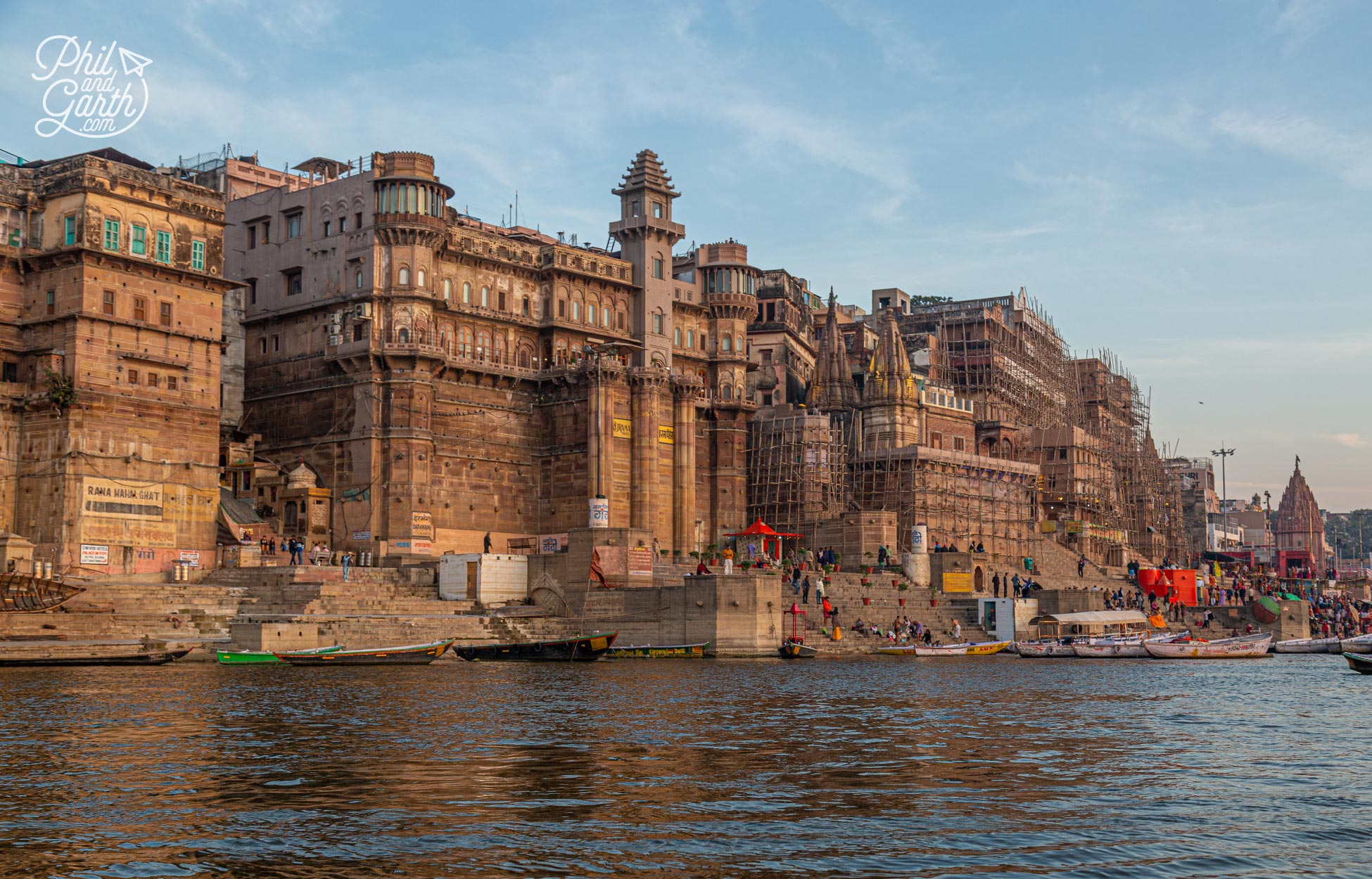
Varanasi is considered to be one of the oldest continuously inhabited cities in the world
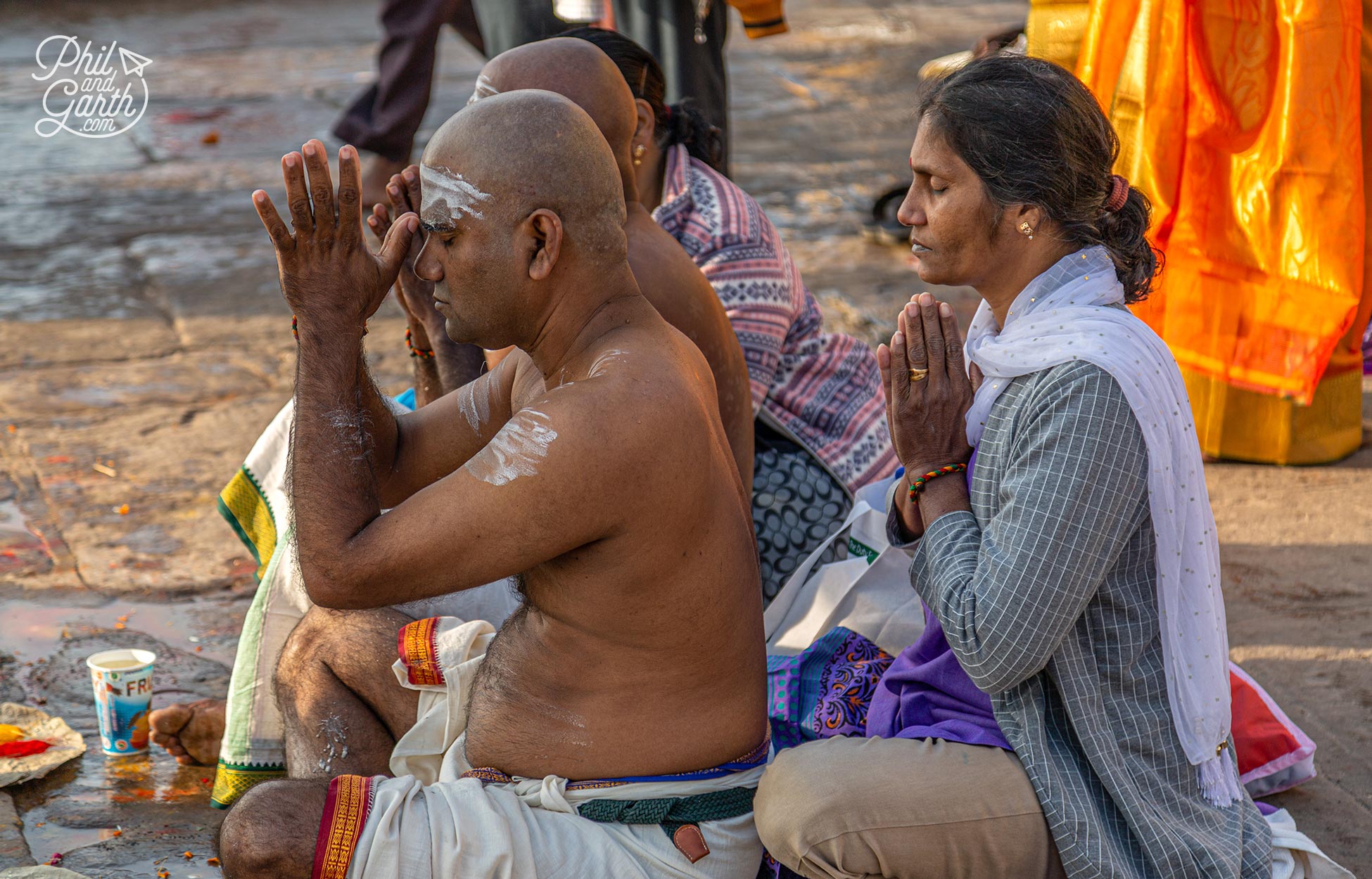
Over 2.5 million Hindu pilgrims will visit Varanasi every year
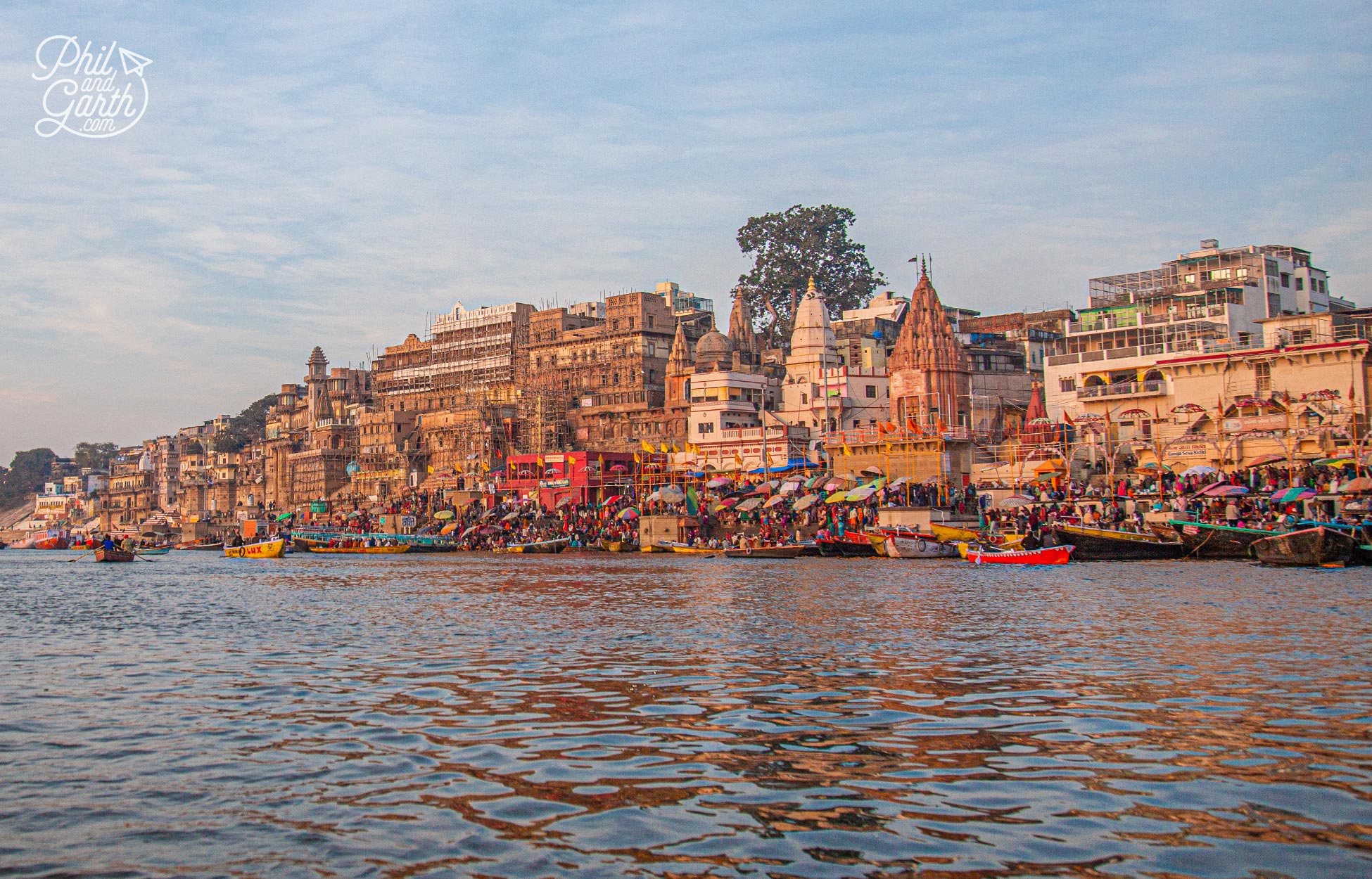
Known as the ‘city of temples’ – Varanasi has over 23,000 temples
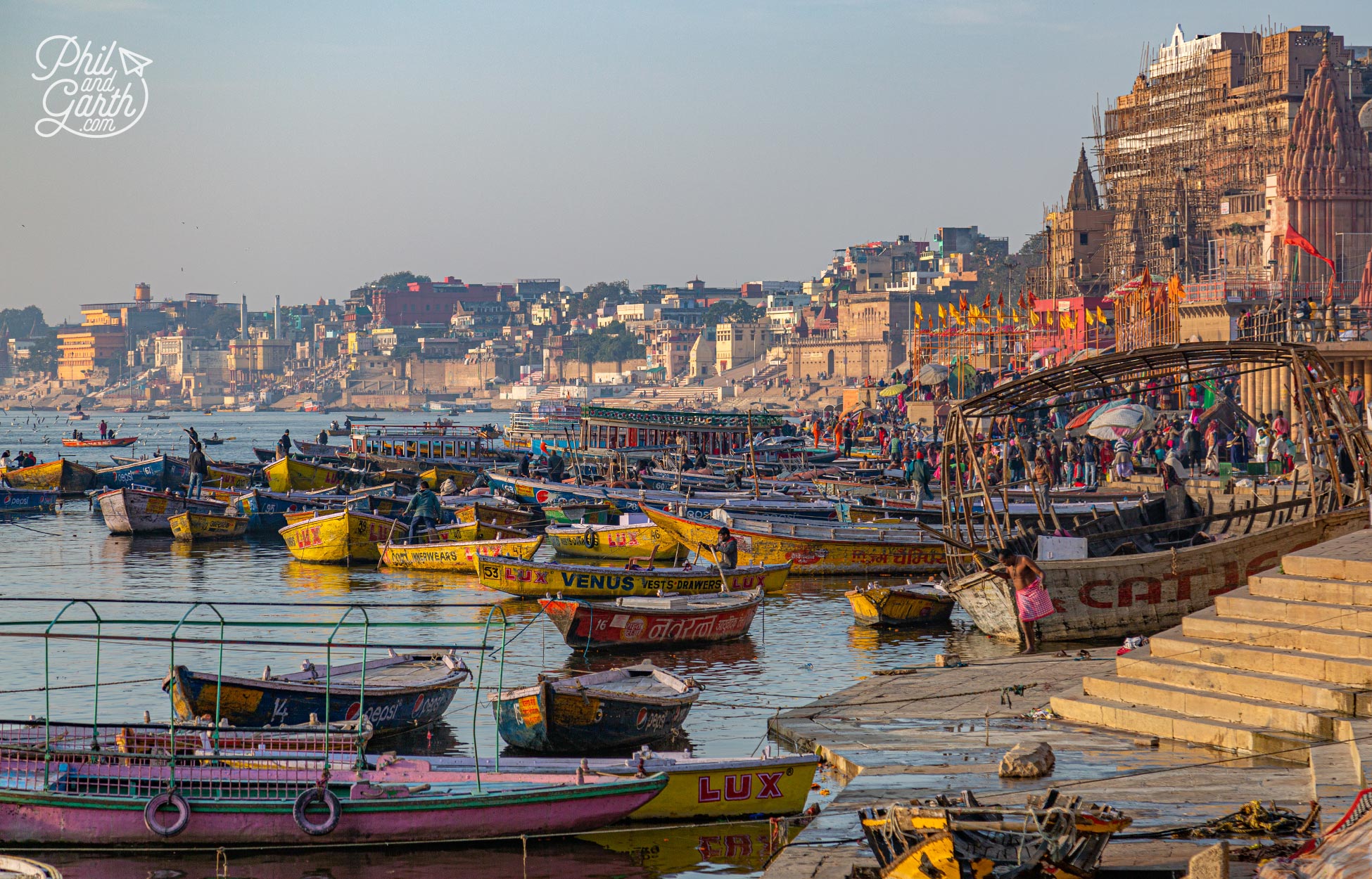
Walking the Ghats is one of the best things to in Varanasi
Attractions & Things To Do in Varanasi
Ghats of Varanasi
Lining the banks of River Ganges in Varanasi are many concrete and stone steps that lead down to the water, they are called ghats. There are 84 ghats in Varanasi and are the main attraction of the town. Hindus come here to perform prayers and acts of worship called ‘puja’. People worship the River Ganges considered to be a living god – The Goddess Ganga. They take holy dips in her water to wash away their sins, simply bathe, wash clothes, meditate or celebrate.
We spent a few hours walking most of the ghats starting at Assi Ghat (the end one with a beach) just watching daily life as we passed all the different steps. From people praying to ladies washing their colourful saris and laying them out to dry. It’s a hive of activity. Apparently barbers and dentists even offer their services on the ghats, we didn’t see those guys. As you get closer to the main Dashashwamedh Ghat it get very busy with people. When we visited Pushkar we had to take our shoes off to walk on their ghats, however in Varanasi you don’t have to which is fortunate as some are quite dirty.
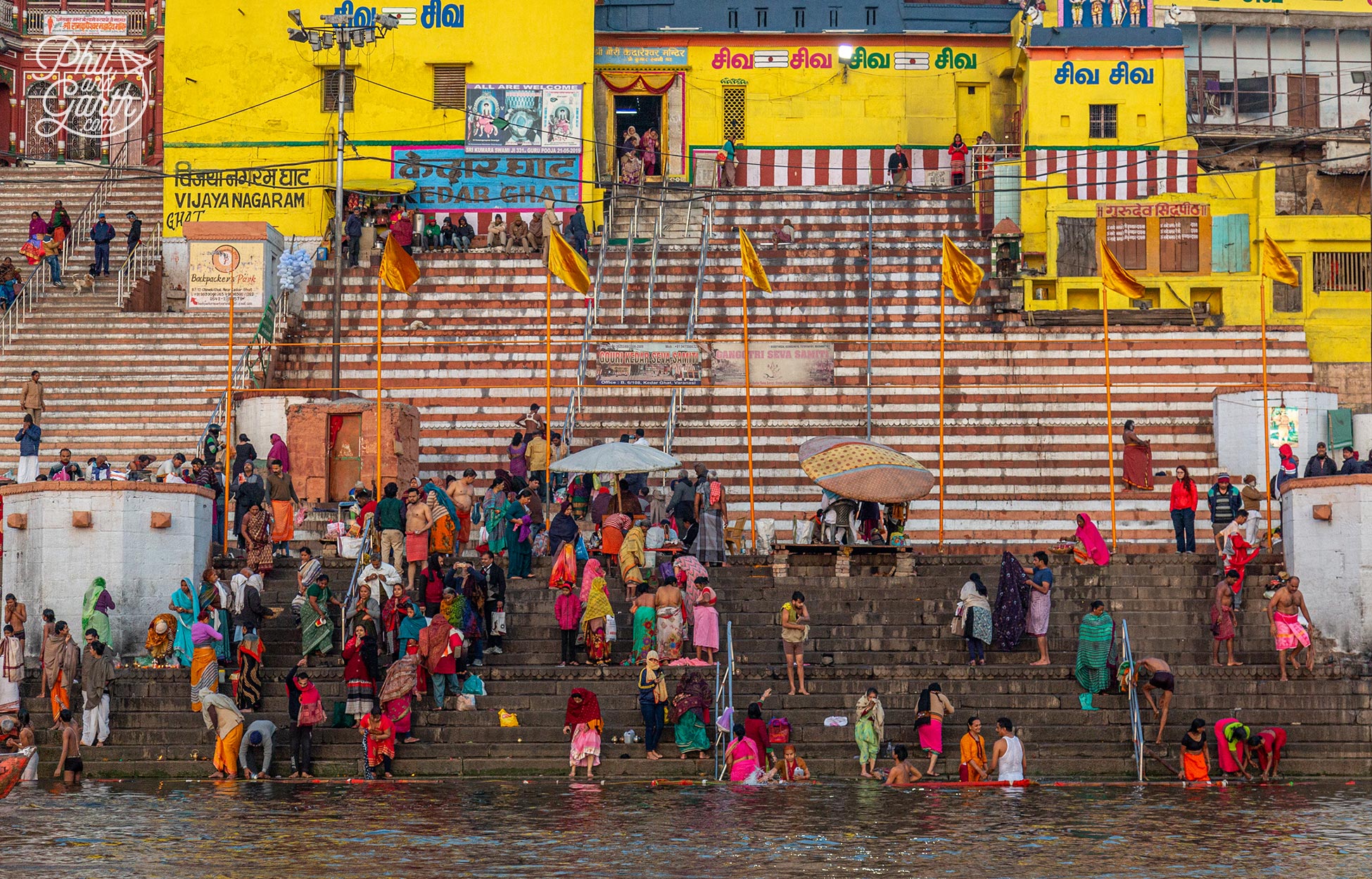
People take dips in the holy water of the River Ganges to wash away sins and perform prayers
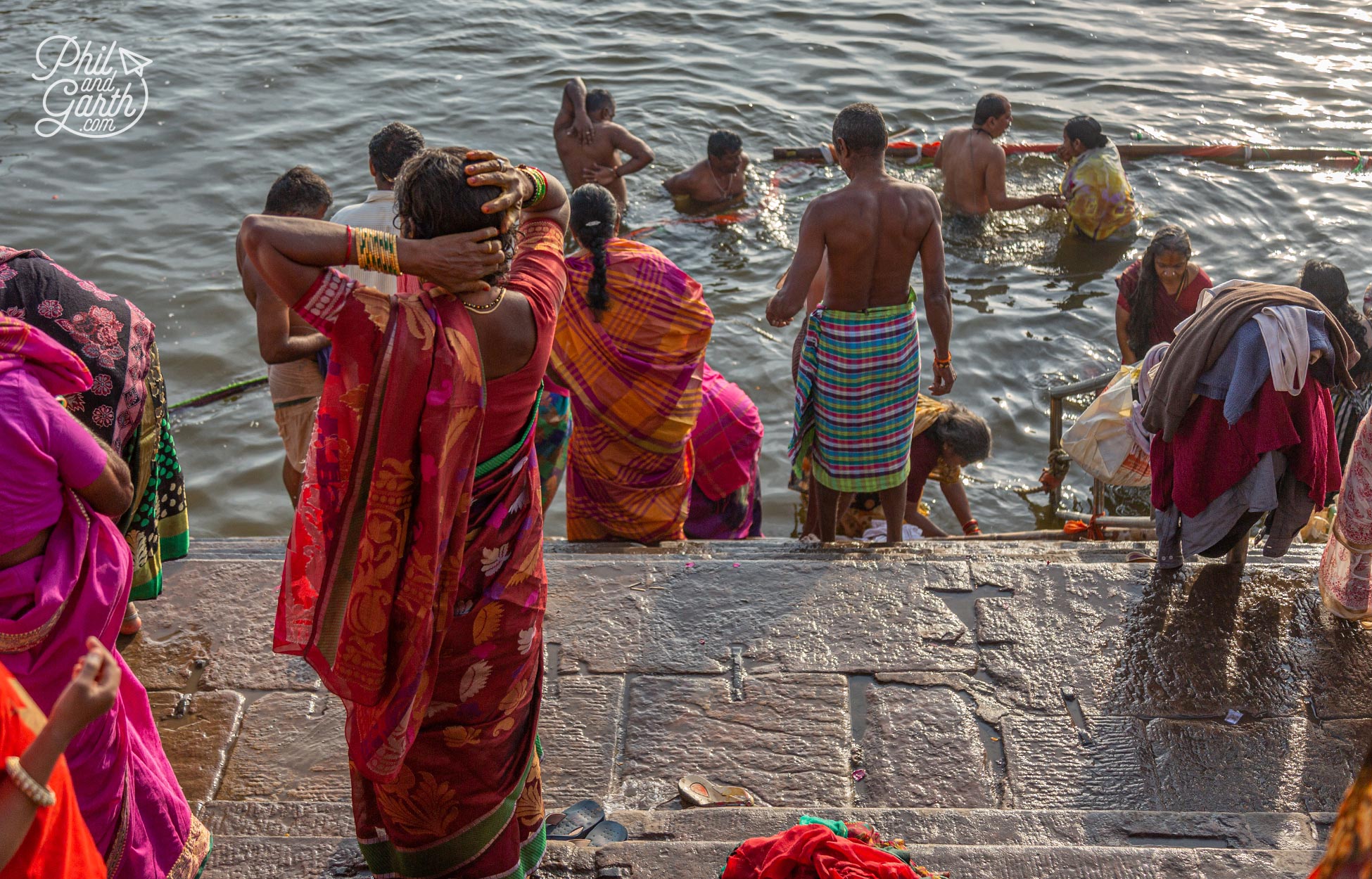
Bathing is a common sight everyday in Varanasi
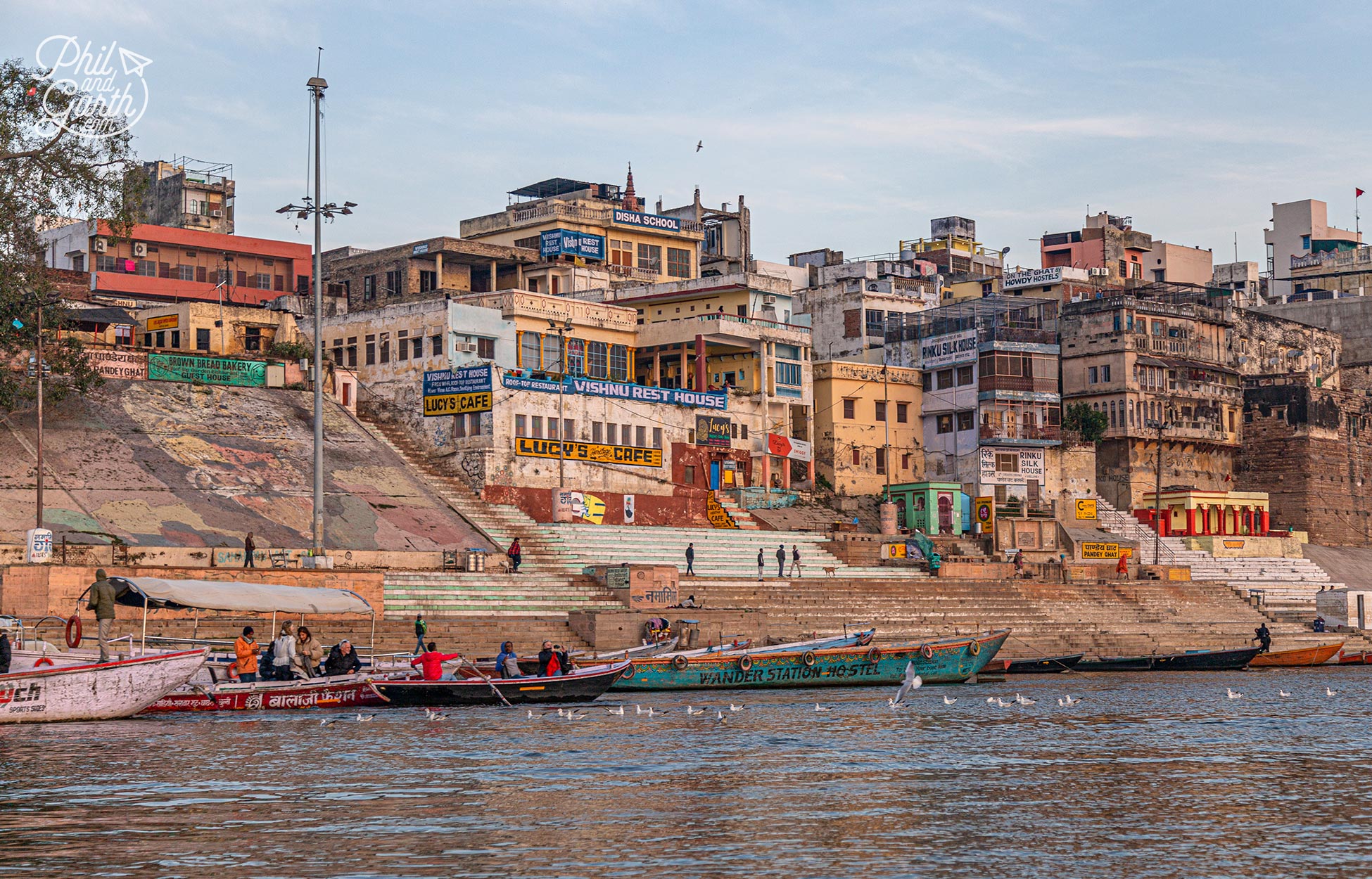
Pandey Ghat
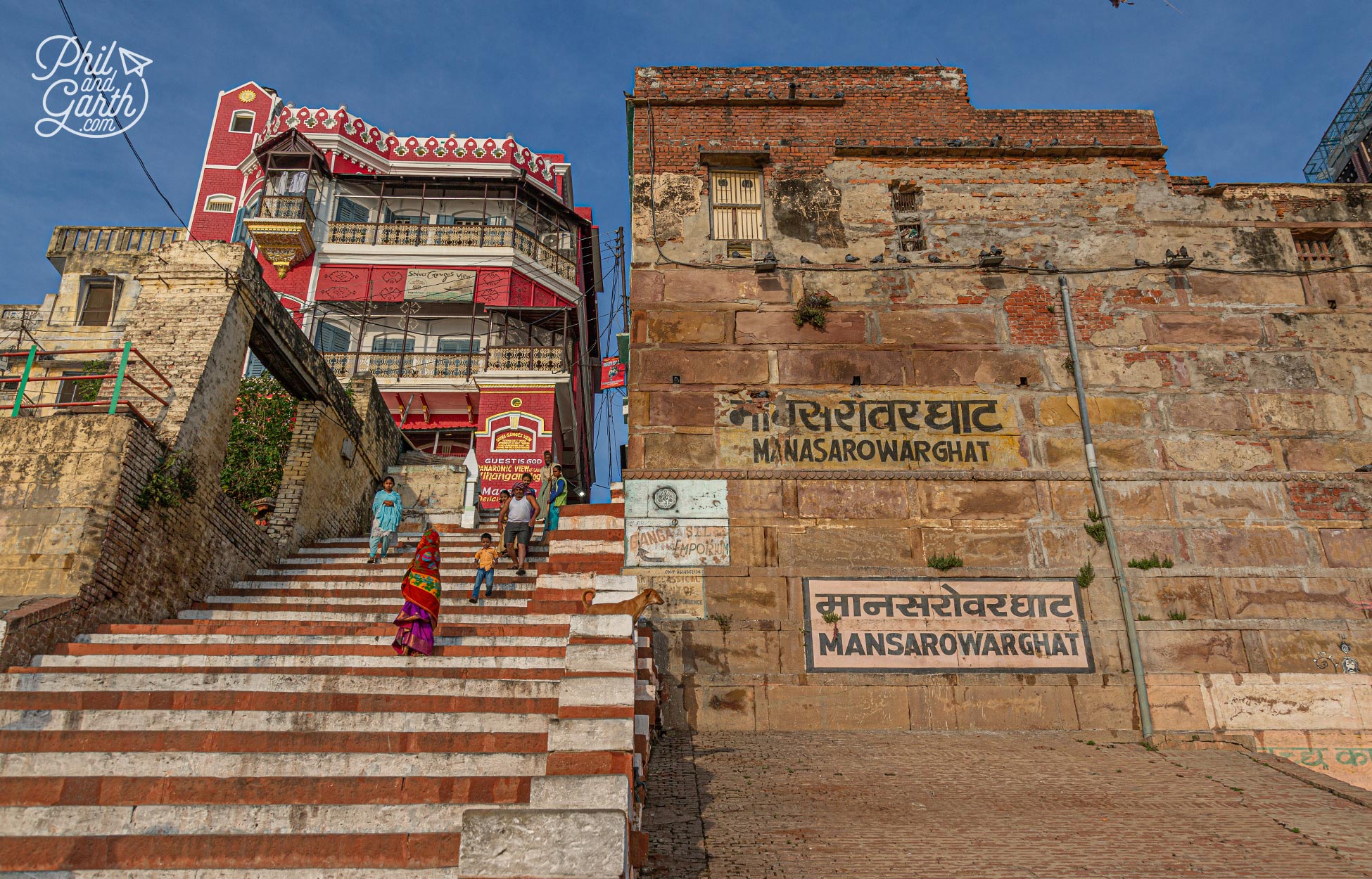
The steps of Mansarover Ghat
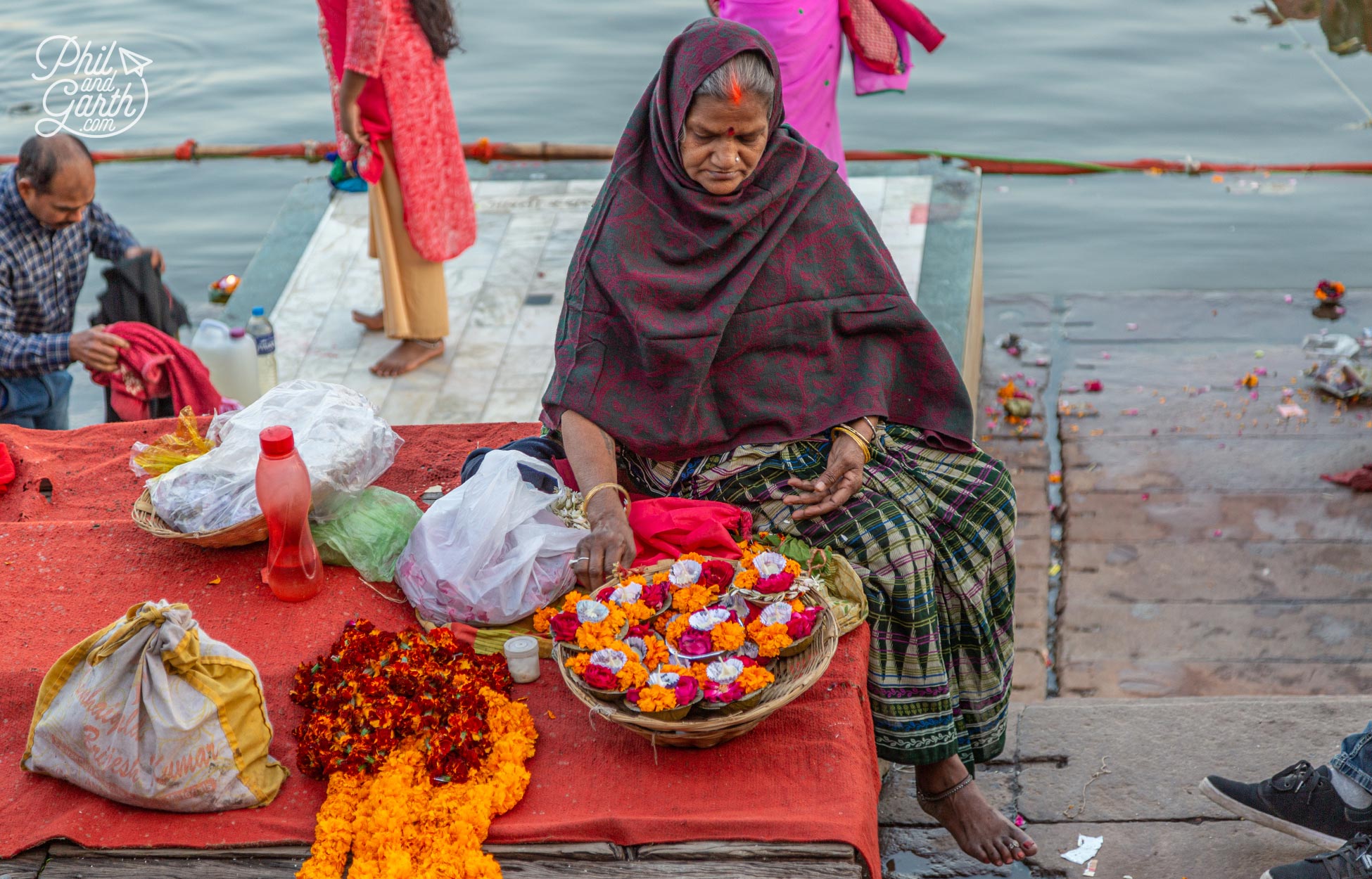
A lady makes candle and flowering offerings for the evening aarti
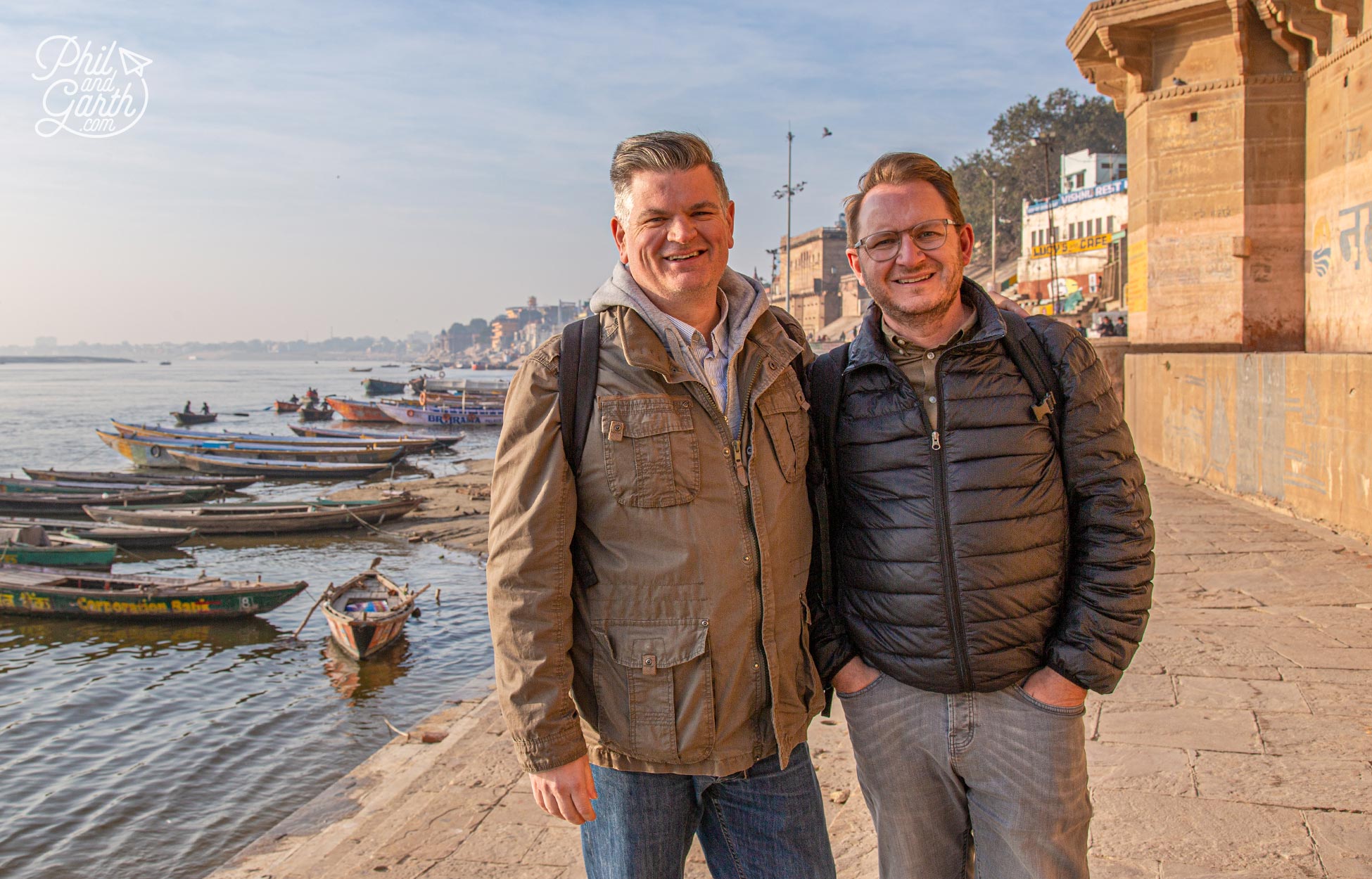
Taking a walk along all the different ghats in Varanasi

Crowds of people gathering at Dashashwamedh Ghat
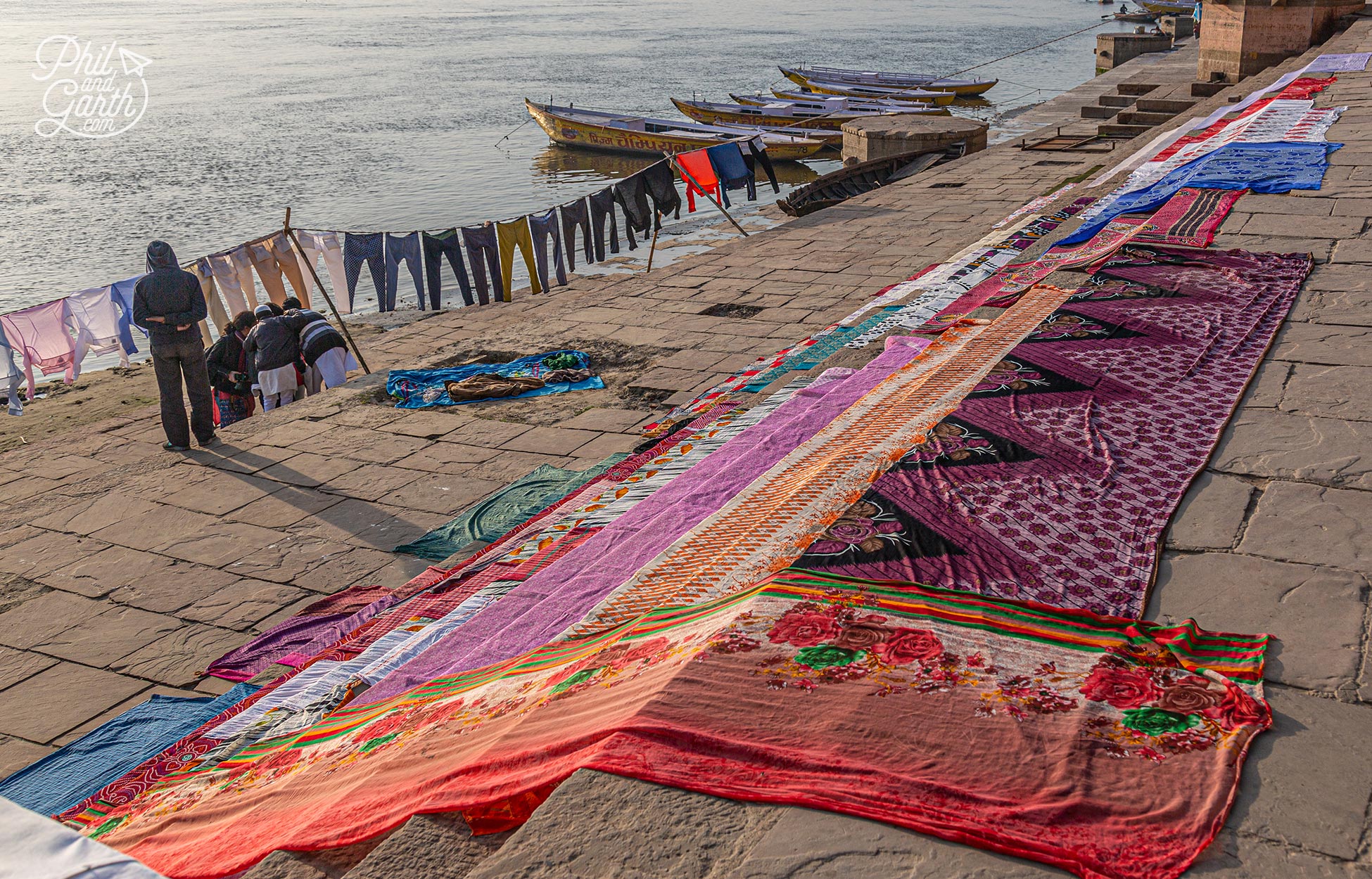
Colourful saris laid out to dry on the ghats
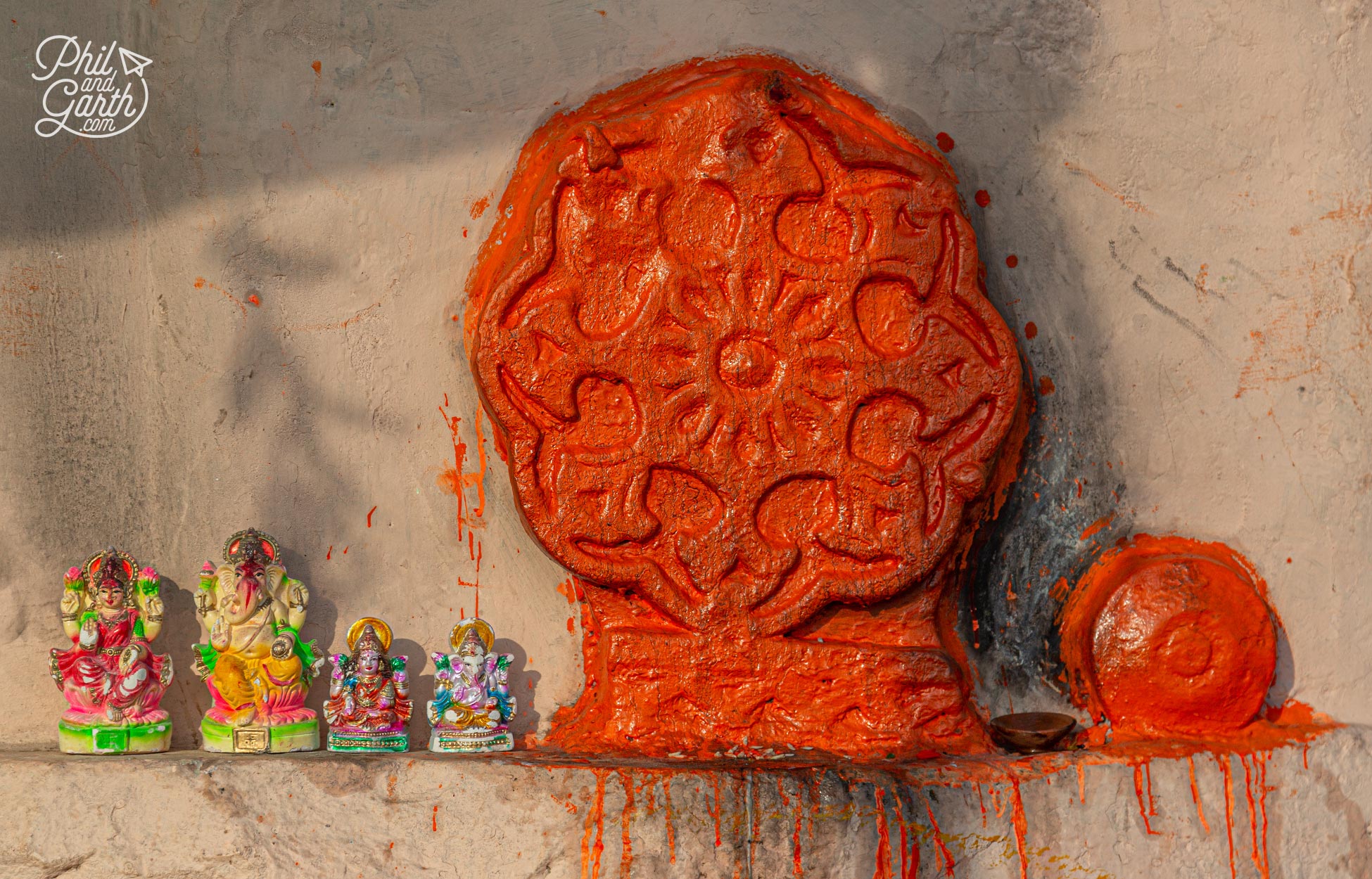
We discovered lots of little shrines on the ghats like this one
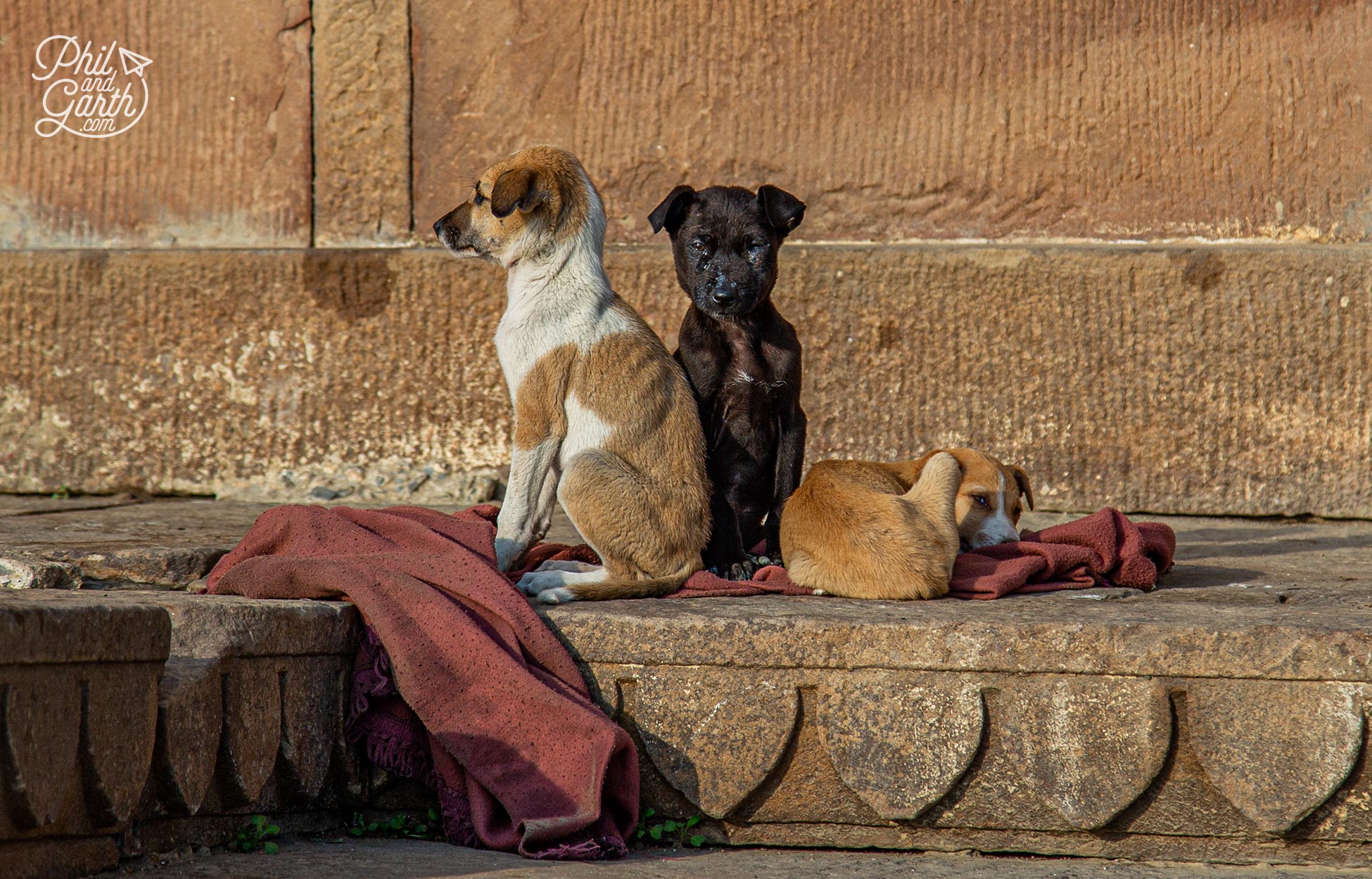
So many stray dogs on the ghats of Varanasi
‘Burning’ Ghats
Manikarnika Ghat and Harishchandra Ghat are the only two ‘burning ghats’ of Varanasi. This is where dead bodies are cremated in front of everyone to see all day and all through the night. Manikarnika Ghat is the most holiest of the two ghats, around 100 cremations take place everyday. Bodies arrive on simple stretchers by family members and then dipped into the River Ganges first to wash away sins, then sprinkled with ghee before being placed on large piles of wood, called pyres and burnt for 3 hours. The flames here never go out, and are said to be sacred because they have been burning for over 3,500 years.
Death in Varanasi is not a taboo or a private affair like it is in the West, instead death is a celebration in Varanasi. We witnessed all of this right in front of us, it’s initially quite shocking and felt uneasy to watch but after a while somewhat peaceful. We felt quite privileged to see this intimate ritual of death. If you want a closer view you are allowed to walk along the burning ghats, but you must be quiet and respectful, and photography is strictly forbidden. Indian women are not allowed to view the ceremonies but female tourists can. We were slightly worried after reading online about people seeing body parts at the waters edge. However we’re pleased to report we didn’t see anything like that, just loads of stray dogs at the water looking for food.
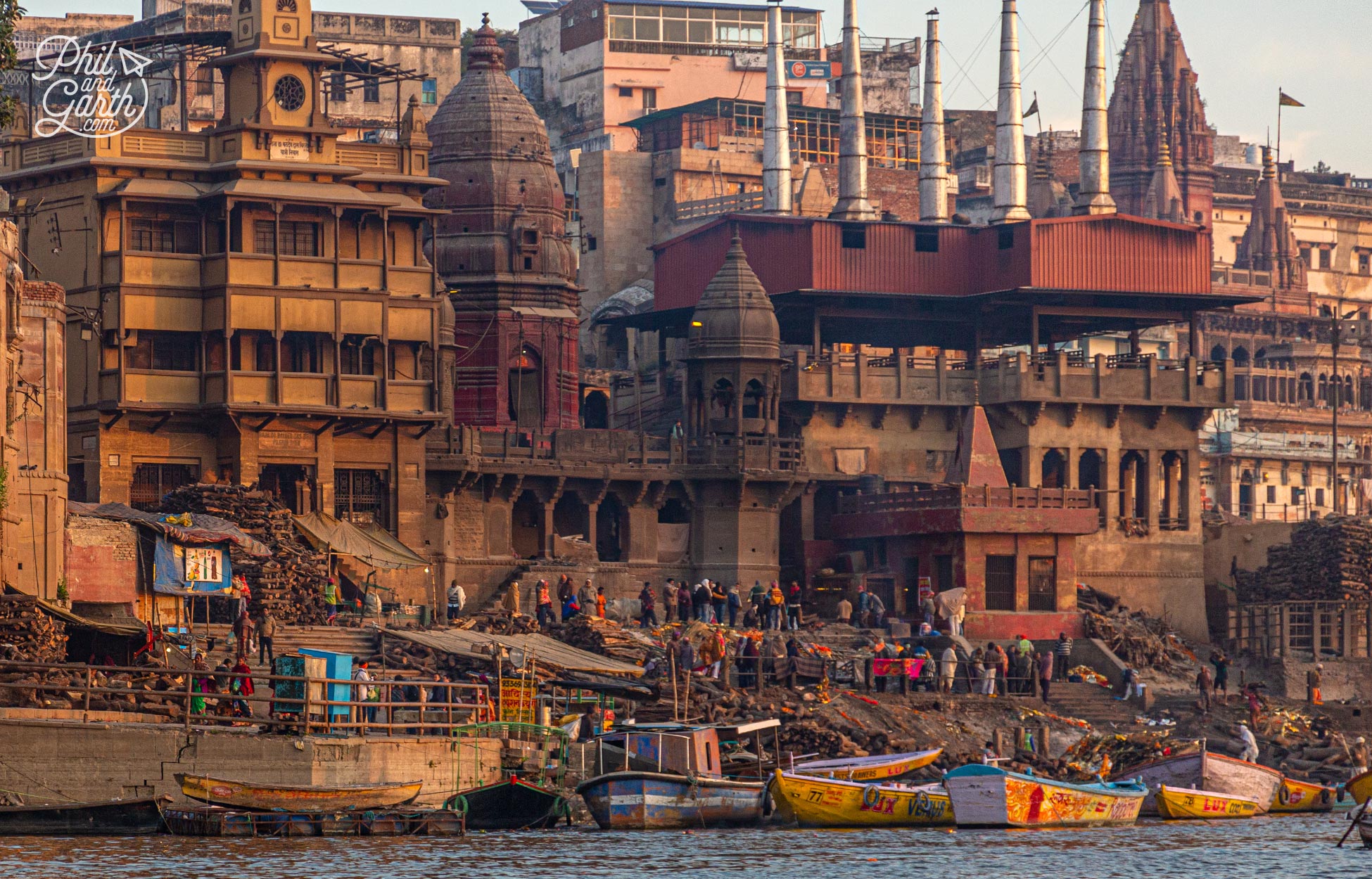
The Manikarnika Ghat where around 100 cremations take place every day
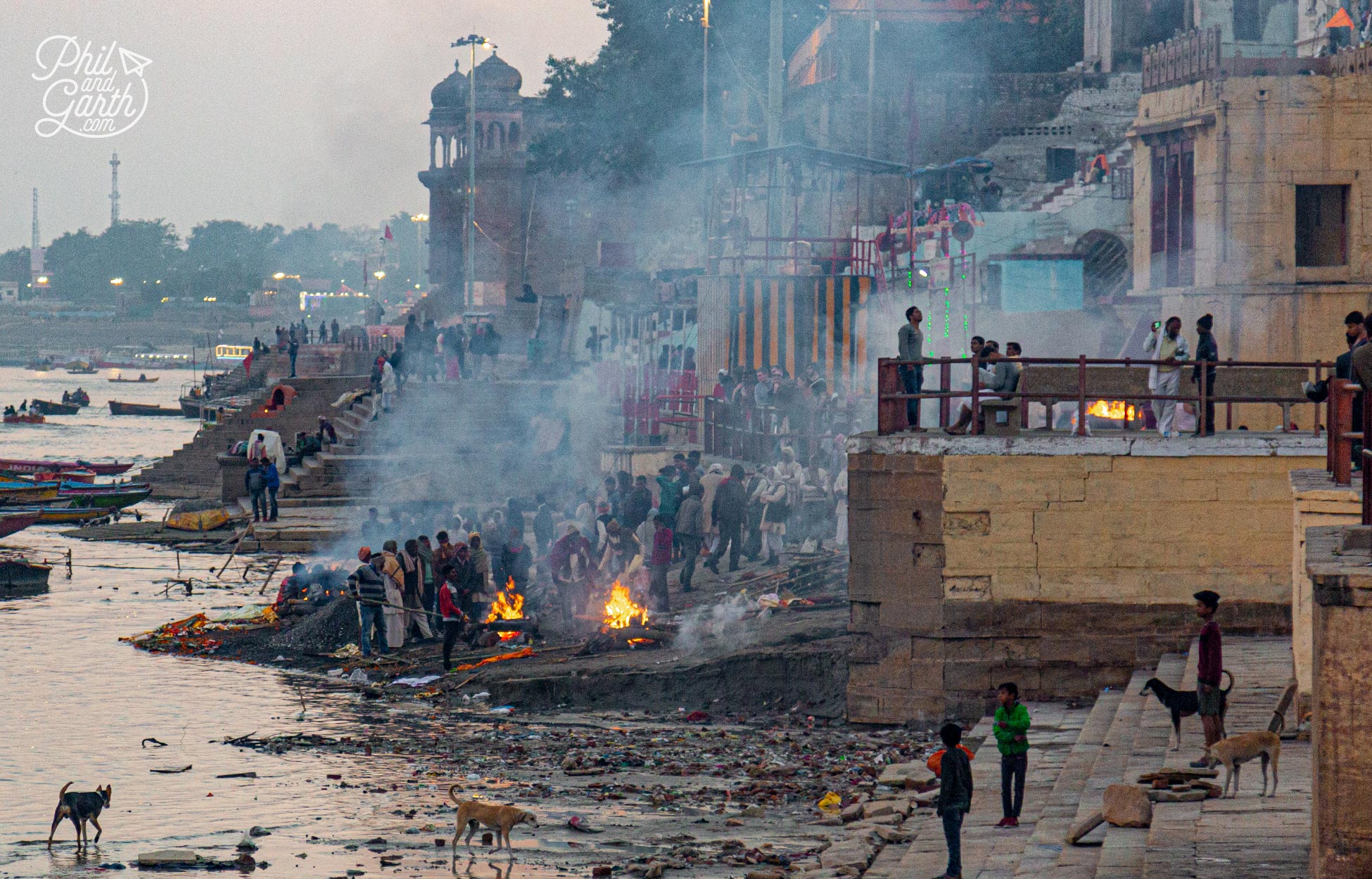
Harishchandra Ghat the second site for cremations by the River Ganges
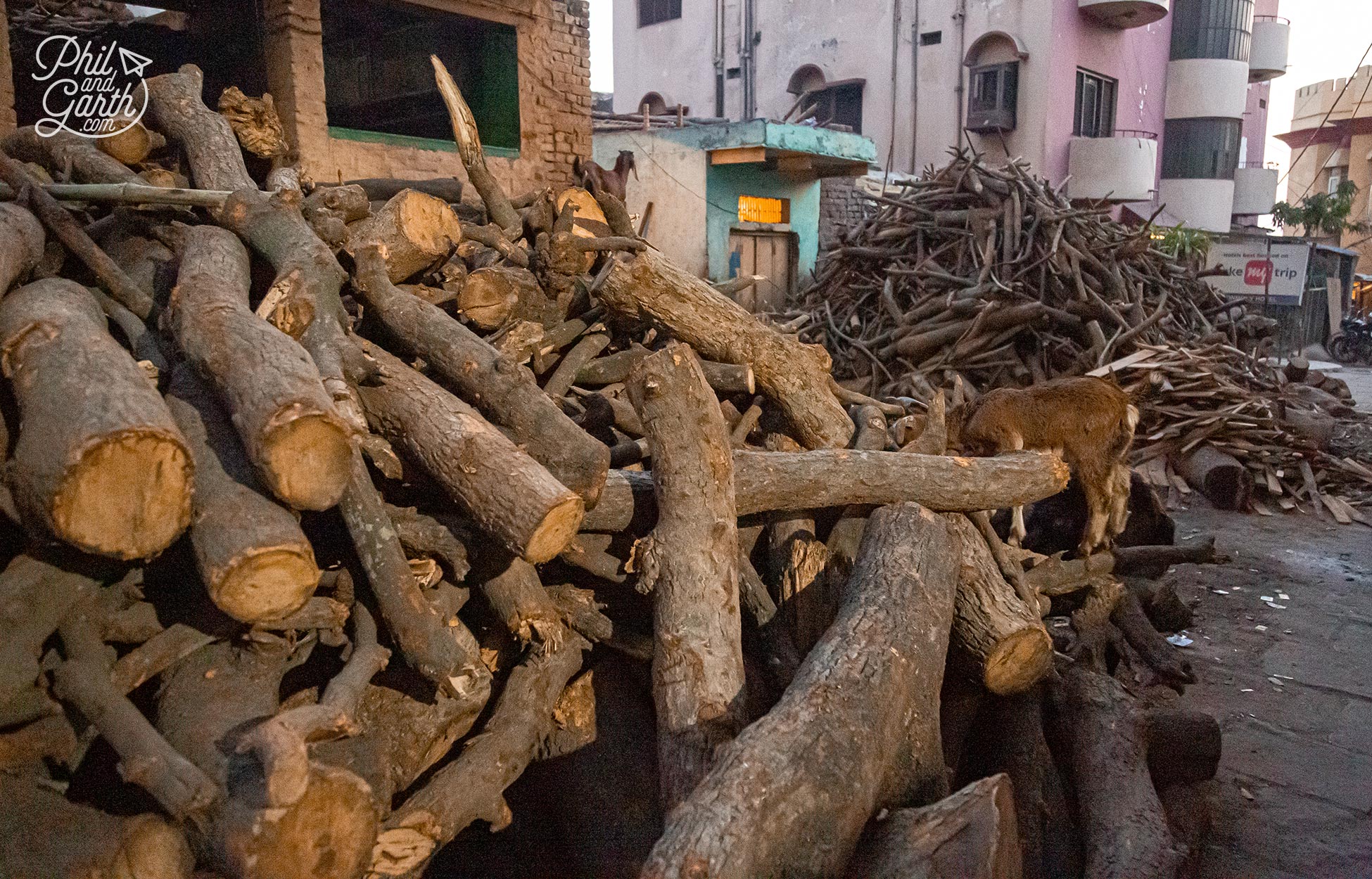
Piles of wood used for funeral pyres
Must See Ghats of Varanasi
- Dashashwamedh Ghat – The main ghat of Varanasi, where evening Aarti is performed at around 6pm.
- Assi Ghat – Where a morning Aarti ceremony is performed at 5.30am before sunrise.
- Darbhanga Ghat – A photogenic ghat with a backdrop of an old fort which is now a luxury hotel.
- Manikarnika Ghat – The main burning ghat of Varanasi for cremations next to the water.
Sunrise Boat Ride
It’s definitely worth the effort to get up early (4.30am) and take a sunrise open boat trip along the River Ganges to witness the ghats come alive with the rising sun. There’s so much activity with hundreds of people arriving to perform morning prayers on the ghats, practicing yoga and offering flowers and food to the Goddess Ganga. Whilst others take turns to bathe in the holy water, monks have to wash themselves before the sun comes up. Phil noticed people filling up small plastic bottles with water from the river, apparently the holy Ganges water is taken home to family members who can’t easily visit Varanasi. As we watched more and more people bathe in the water, we couldn’t help thinking even though it’s the world’s holiest river, it’s also one of the world’s most polluted rivers. Sewage and industrial waste are just a few ingredients pumped into the River Ganges everyday and people bathe and do their laundry here.
We got lucky with the weather as most mornings in winter are misty. The light was lovely and soft, one of Garth’s favourite moments was as the huge red sun rose above the water in the east. The river is just as busy as the ghats in the mornings with lots of boats taking domestic and foreign tourists to witness the rituals. Hundreds of seagulls flew over us and the other boats filled with logs for the funeral pyres. Seeing the sunrise from an open boat is amazing and we thought it’s easily one of the best things to do in Varanasi, because you experience the vibe of Varanasi.
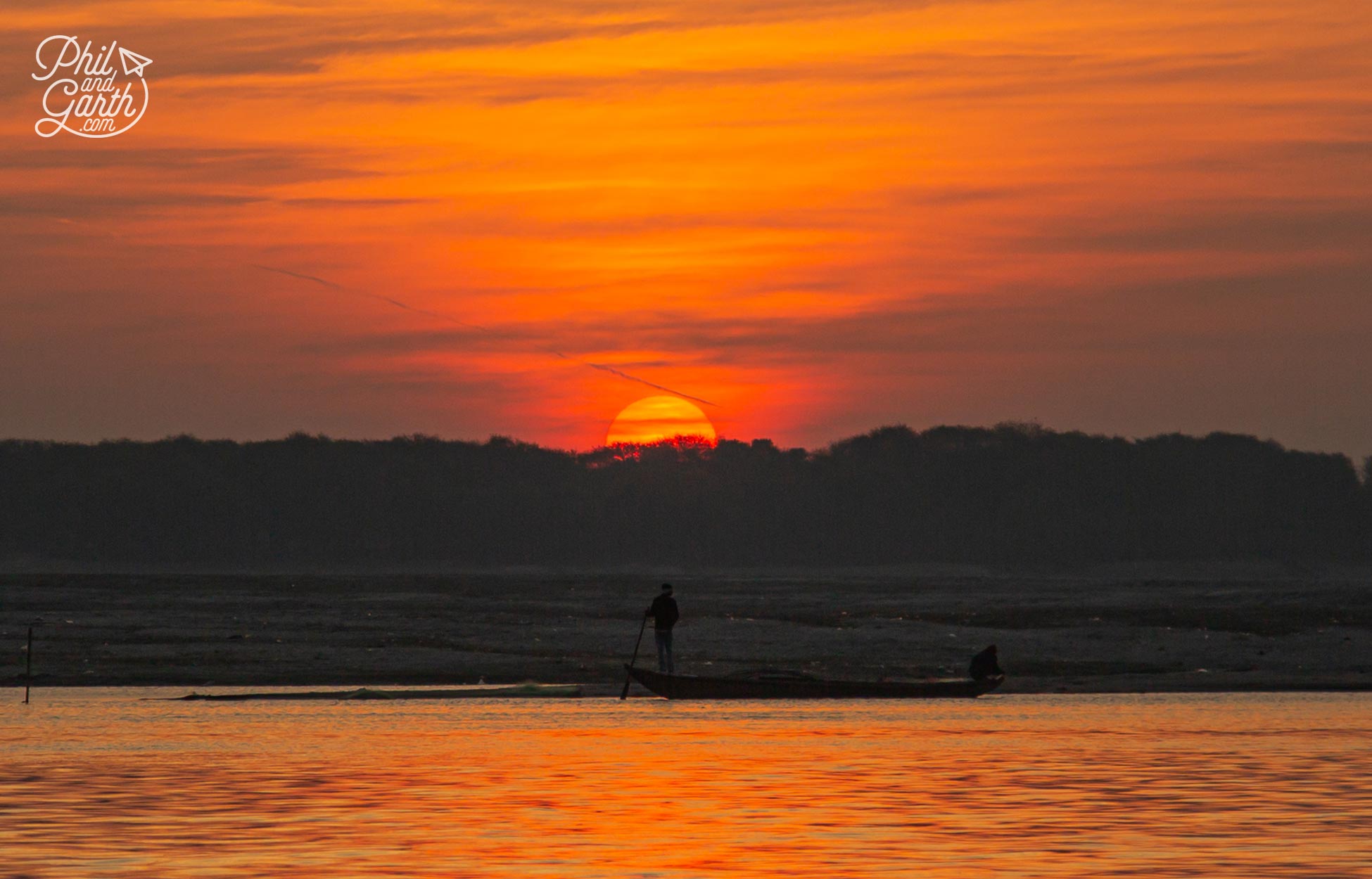
Daybreak over the River Ganges
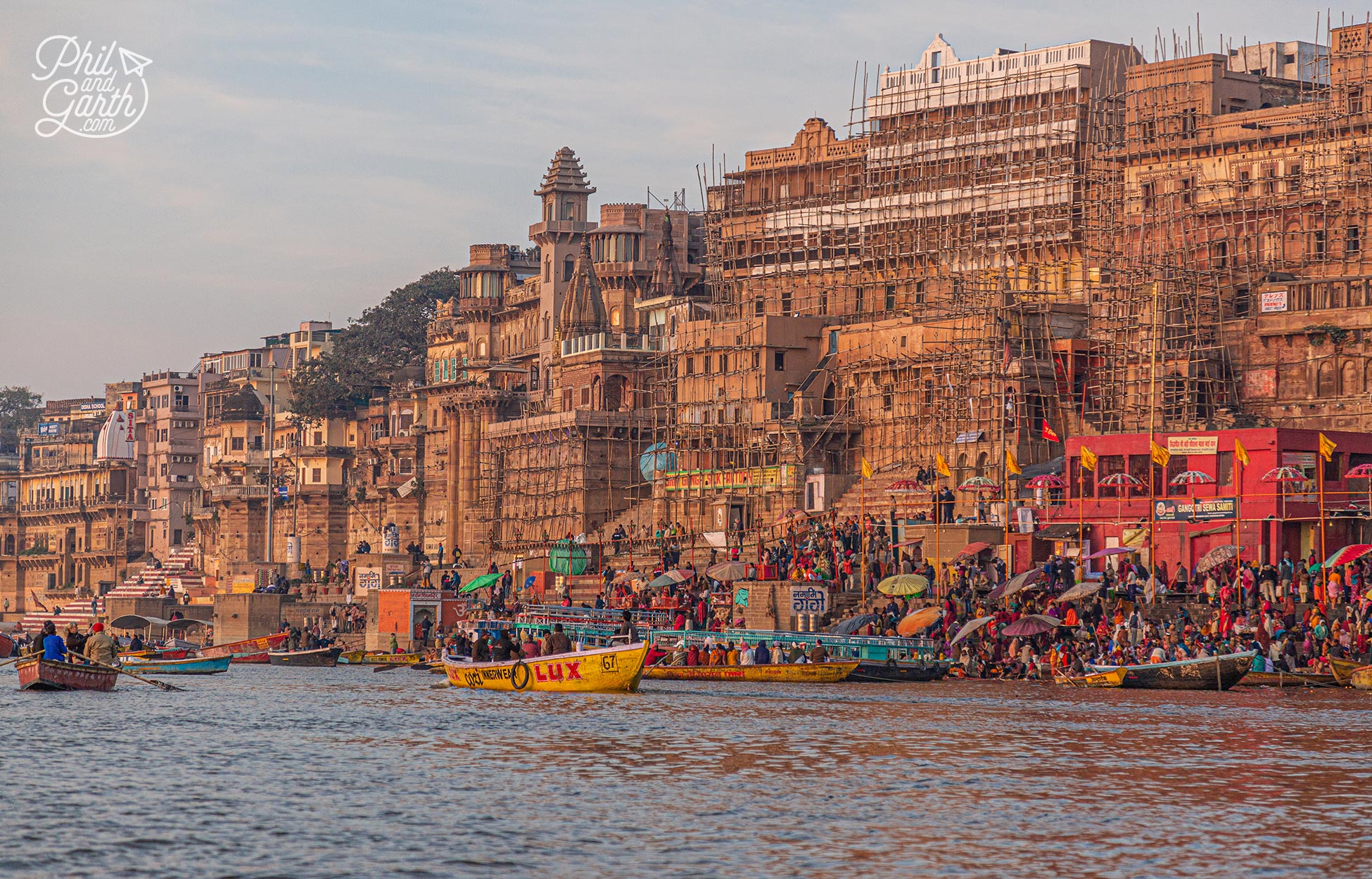
The Varanasi ghats are a hive of activity first thing in the morning
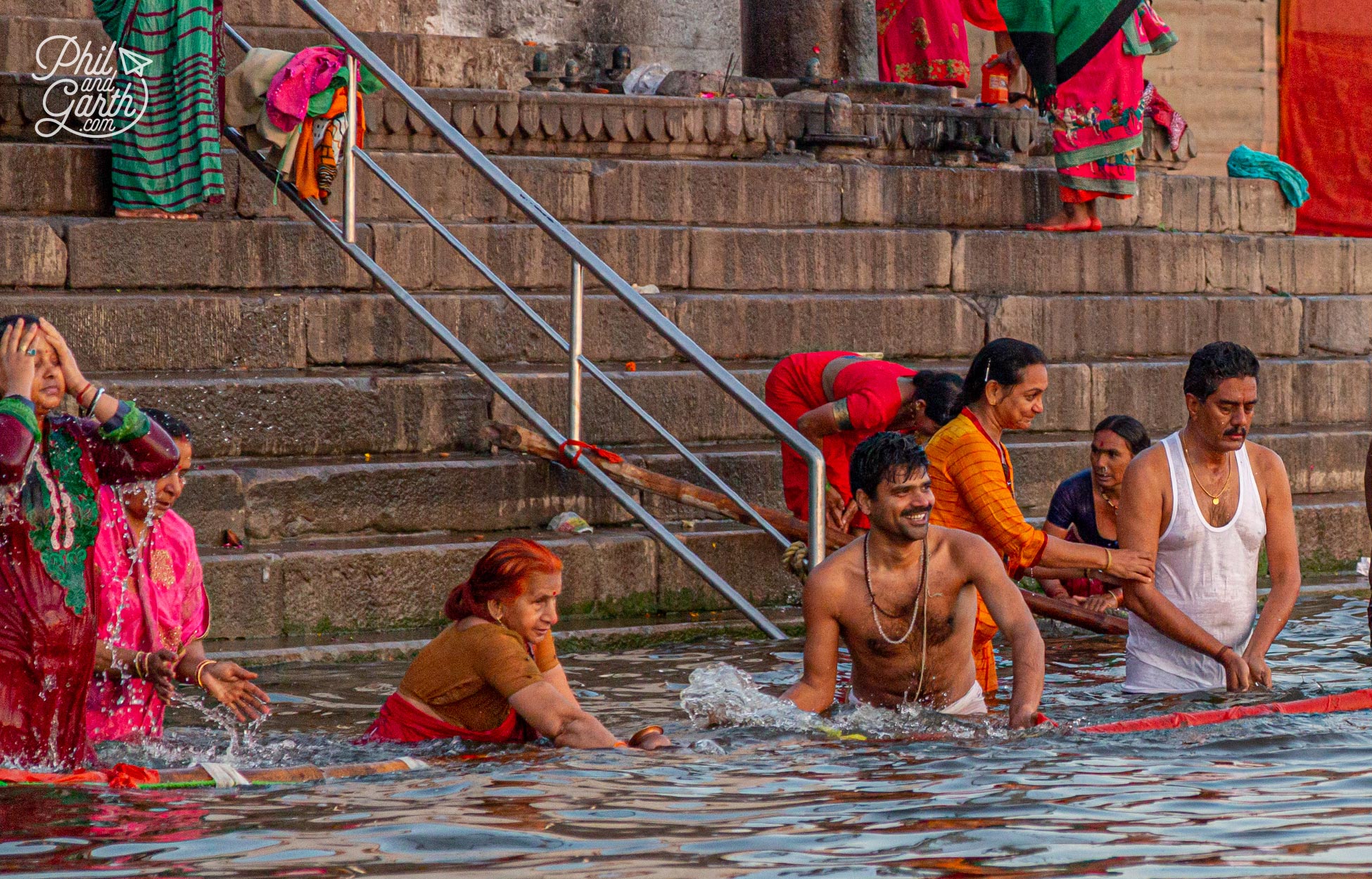
People bathing early morning in the River Ganges. The holy river is personfied as the Goddess Ganga
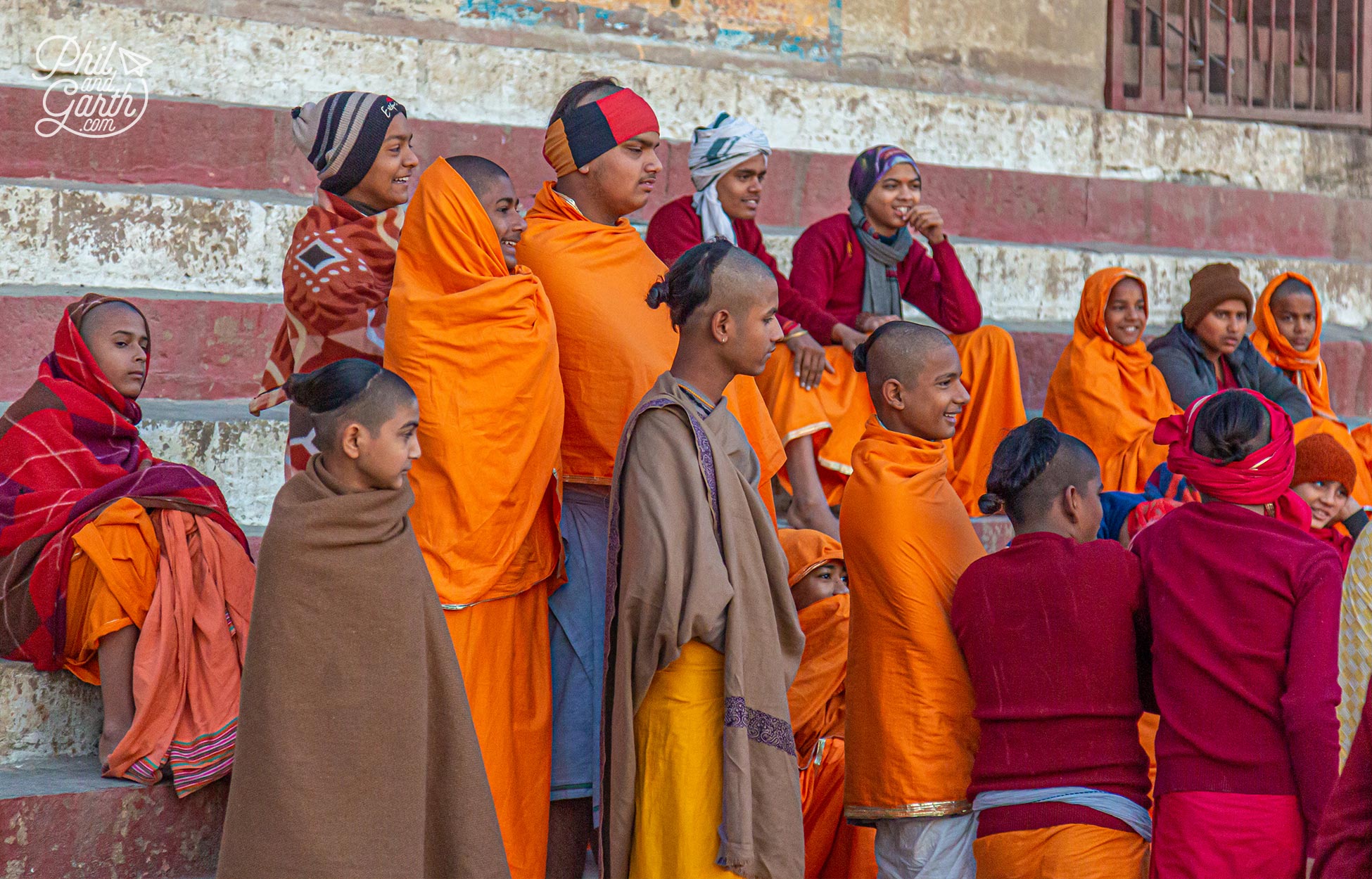
A group of young monks prepare to bathe
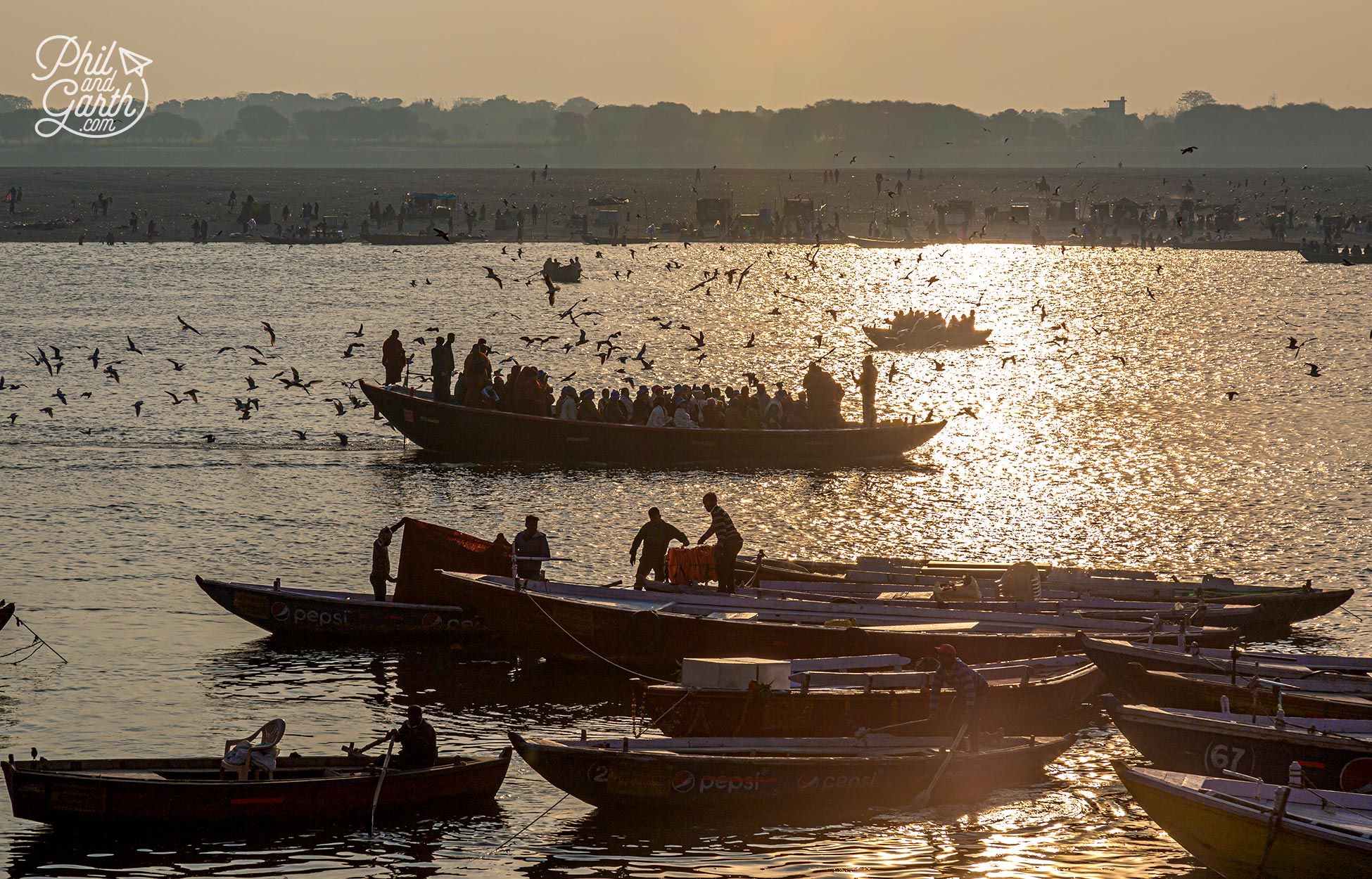
So many atmospheric views of Varanasi from the River Ganges early morning
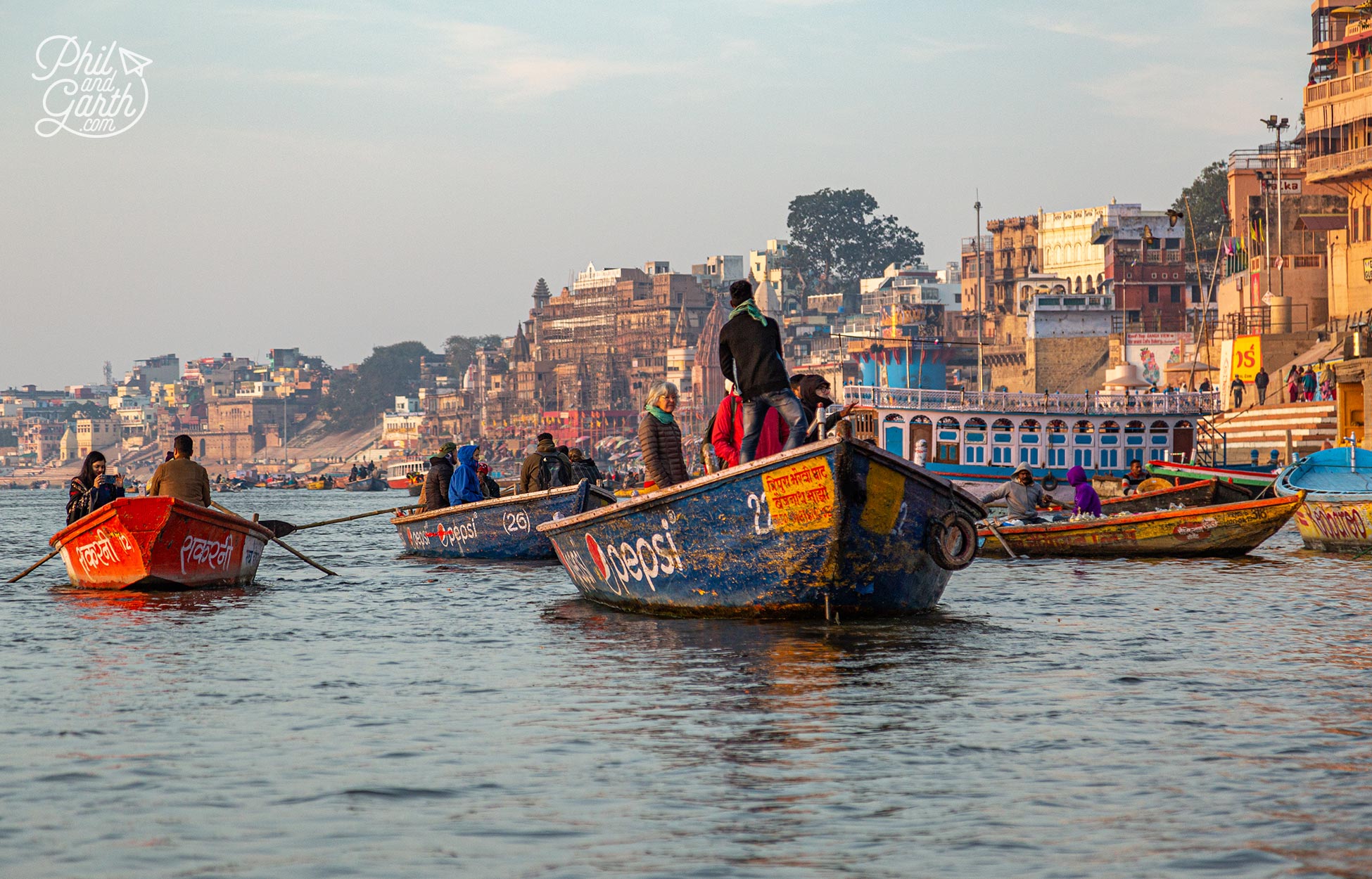
We thought an early morning boat ride down the River Ganges is one of the best ways to experience Varanasi
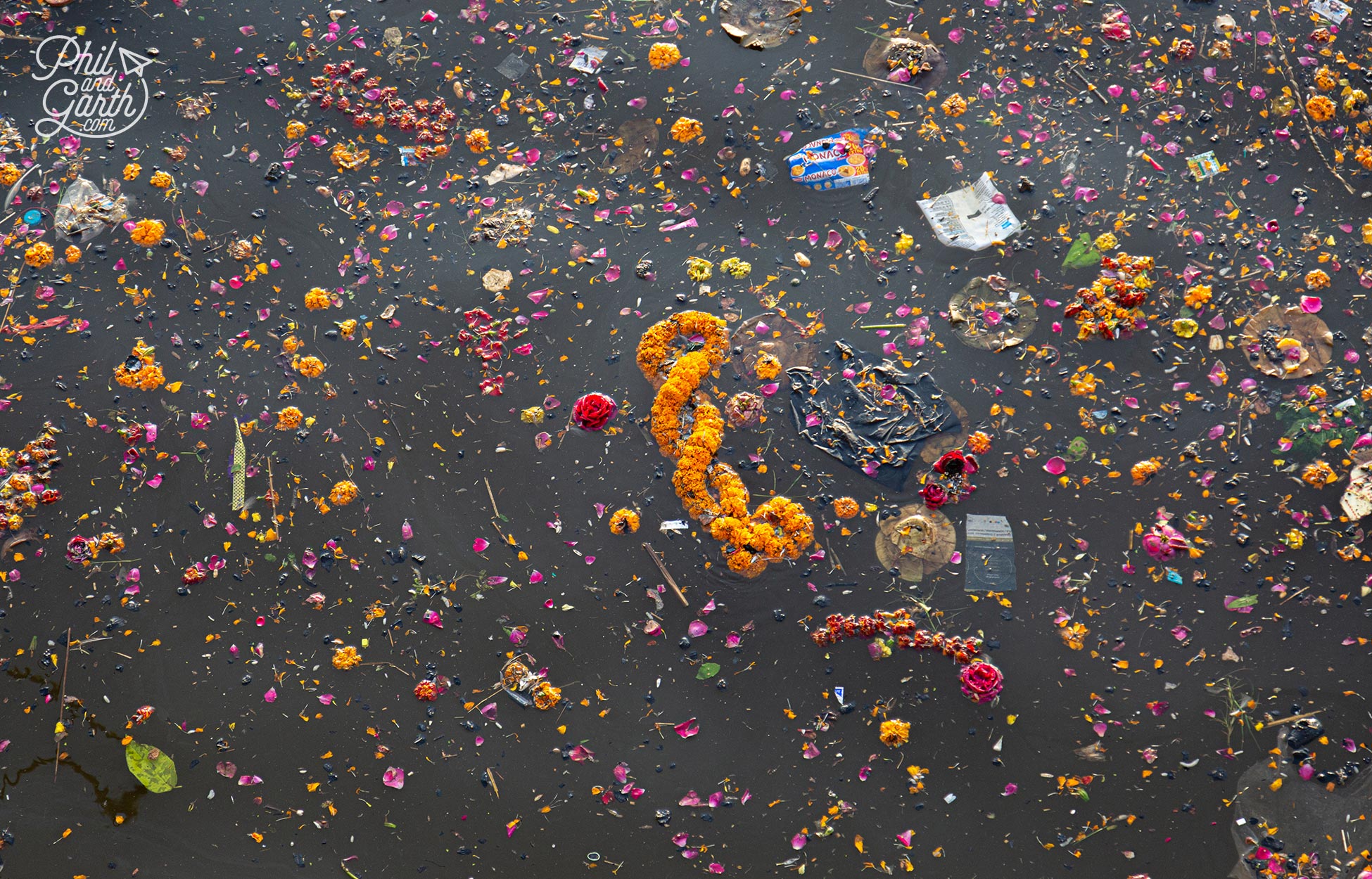
The River Ganges is the gateway to heaven for Hindus. Sadly it’s also the 5th most polluted river in the world
Evening Ganga Aarti
Every night at around 6pm on the Dashashwamedh Ghat an amazing ceremony is performed and should not be missed. It’s called the Ganga Aarti and is Varanasi’s famous Hindu ritual. Performed by young monks and priests facing out to the Ganges they use precise choreography with elegant movements always in clockwise direction. The priests offer prayers to the Ganges River and the light from big brass oil lamps called ‘deepas’ is offered to the Hindu God of Fire for her divine light from the sun. Aarti means ‘ceremony of light’. The air is filled with incense and smoke from the fire of the oil lamps. Religious chants and mantras are set to the sound from bells ringing, clash of cymbals, beats of drums and conch shells. At the end of the ceremony marigold petals are then scattered into the Ganges followed by an offering of milk.
Even if you’re not particularly religious like us, we thought the ceremony was quite mesmerising and really beautiful to watch, it felt mysterious and special. It’s very crowded here as hundreds of people come to witness the ceremony. We watched it twice over 2 nights, the first time from the river on a boat which was jostling for position amongst lots of other boats. It felt a bit far away to be honest to see exactly what was happening. However we were in the crowds which had a great atmosphere as they chanted back mantras to the priests. From the boat we both took part in lighting a lotus flower candle in little bowls made from leaves and then floating them in the water. In the hope Goddess Ganga would receive our wishes and give it her blessing. It’s quite magical seeing hundreds of candle lamps floating across the water, it reminded us of the paper ones we saw in Hoi An. On our 2nd night we arrived early at 5pm to secure a position right next to the stage for a more intimate view which was really amazing to see everything up close.
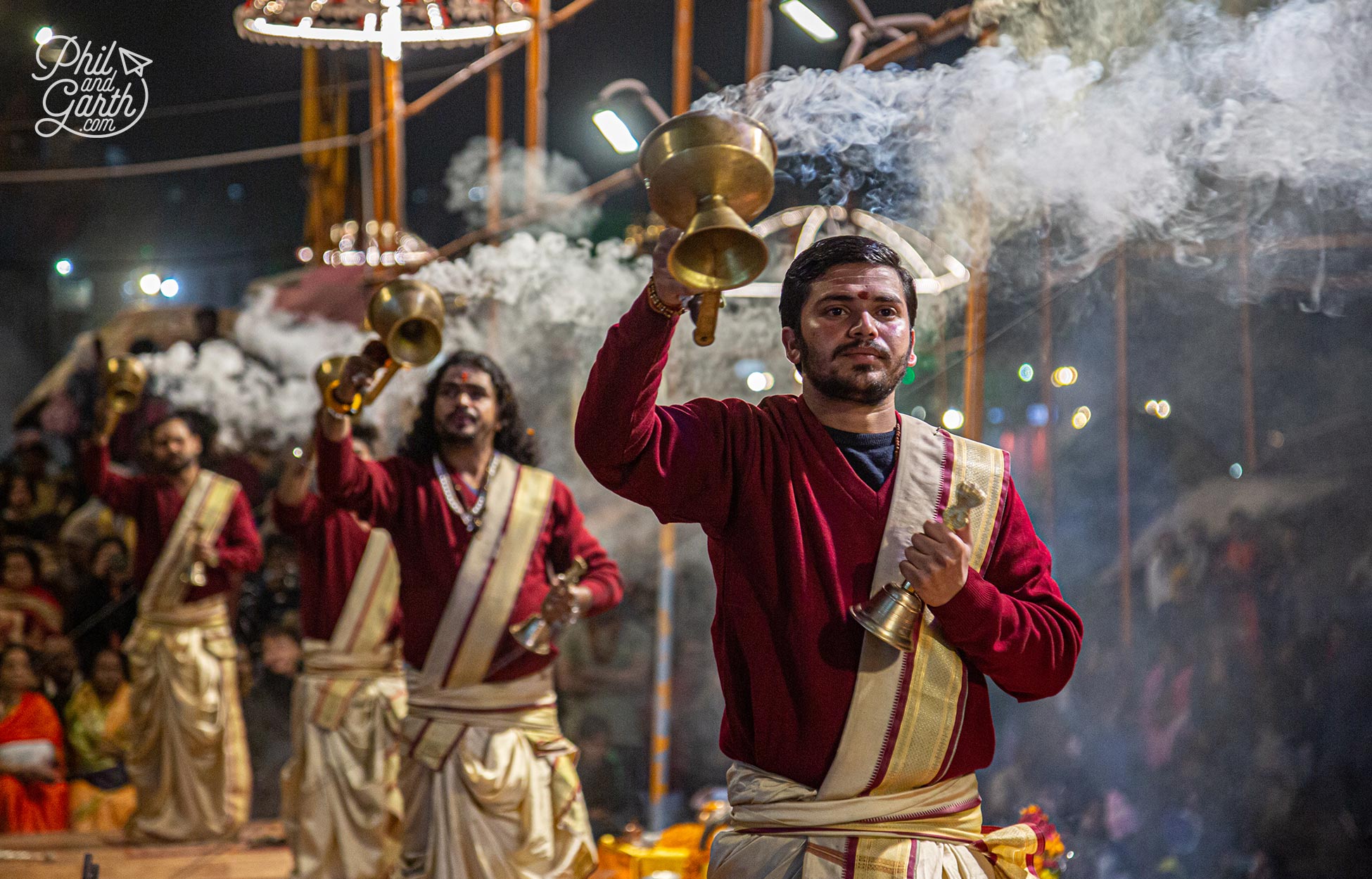
Young monks and priests perform the nightly Ganga Aarti ceremony
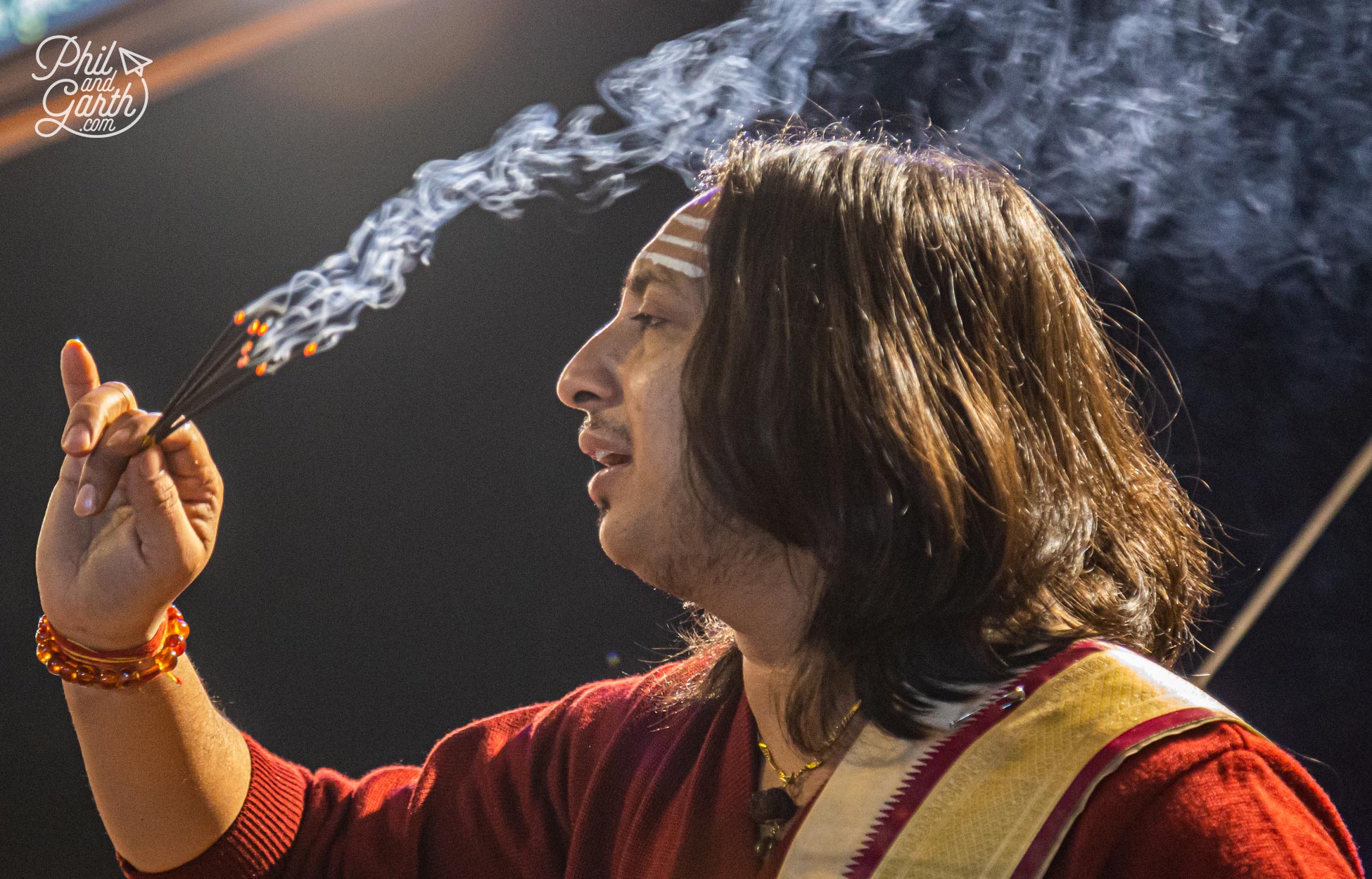
The air is filled with the smell of incense from the evening aarti
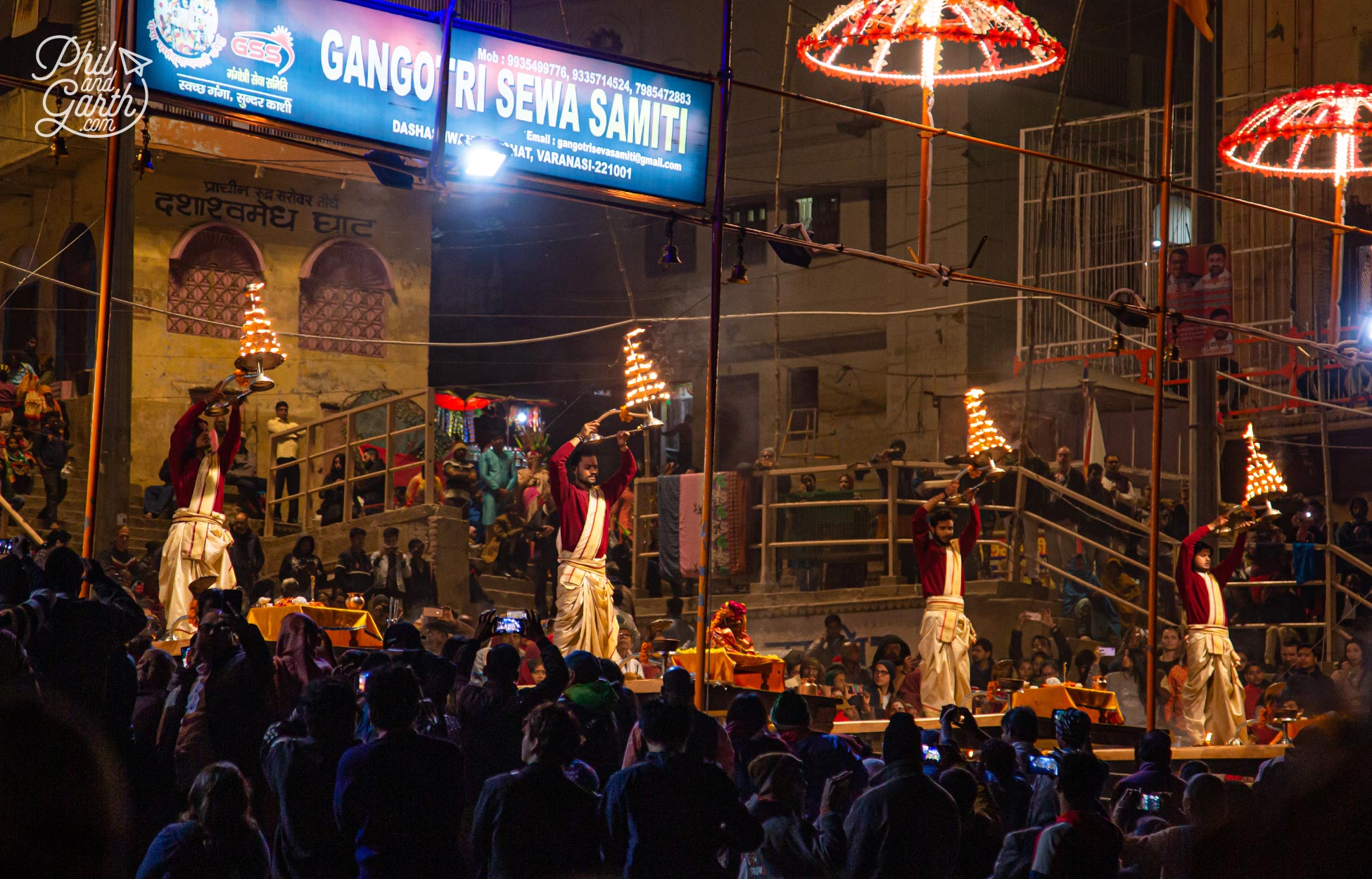
The Ganga Aarti is performed every night on the Dashashwamedh Ghat
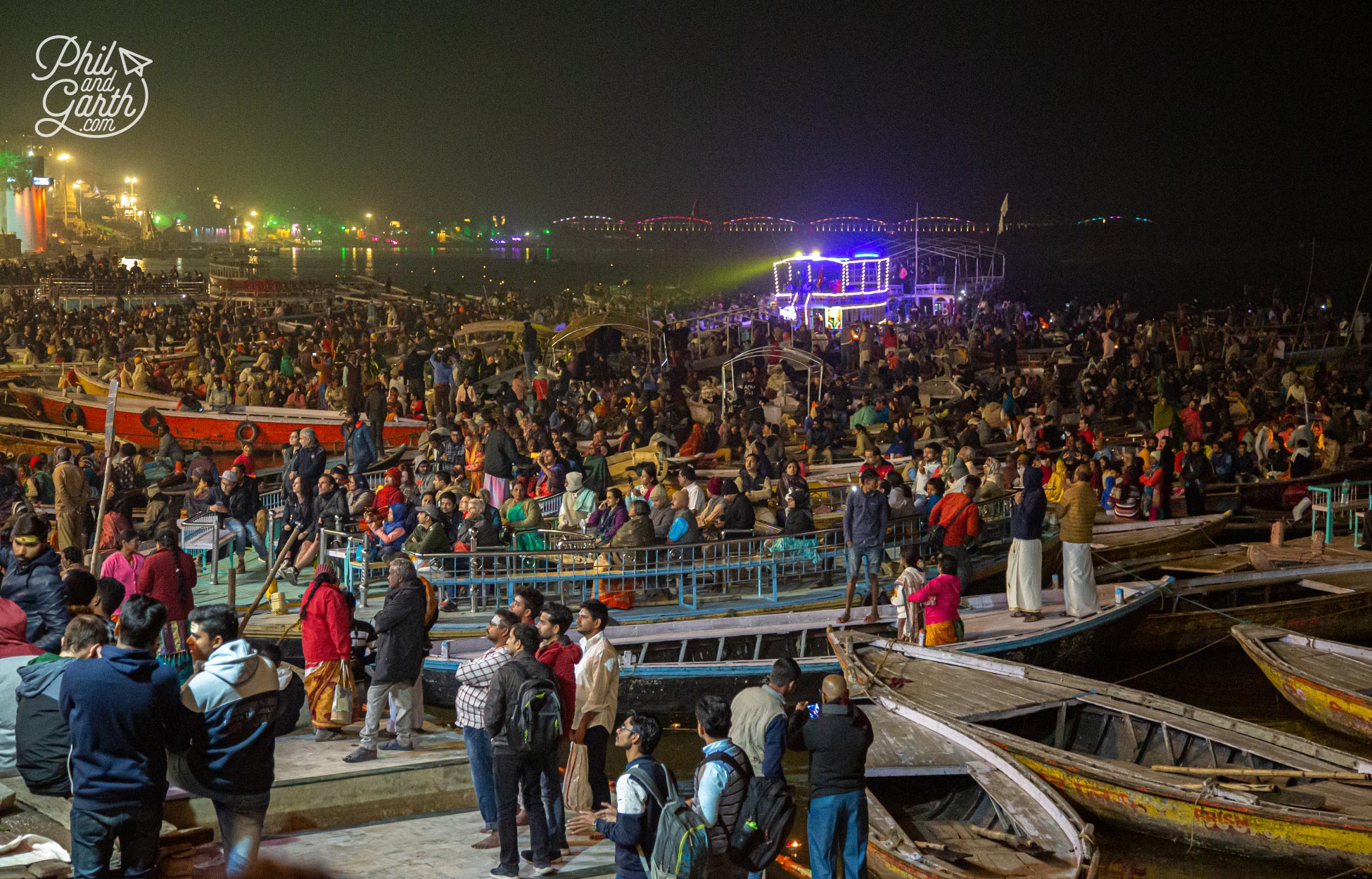
Hundreds of people watching the Aarti from the river
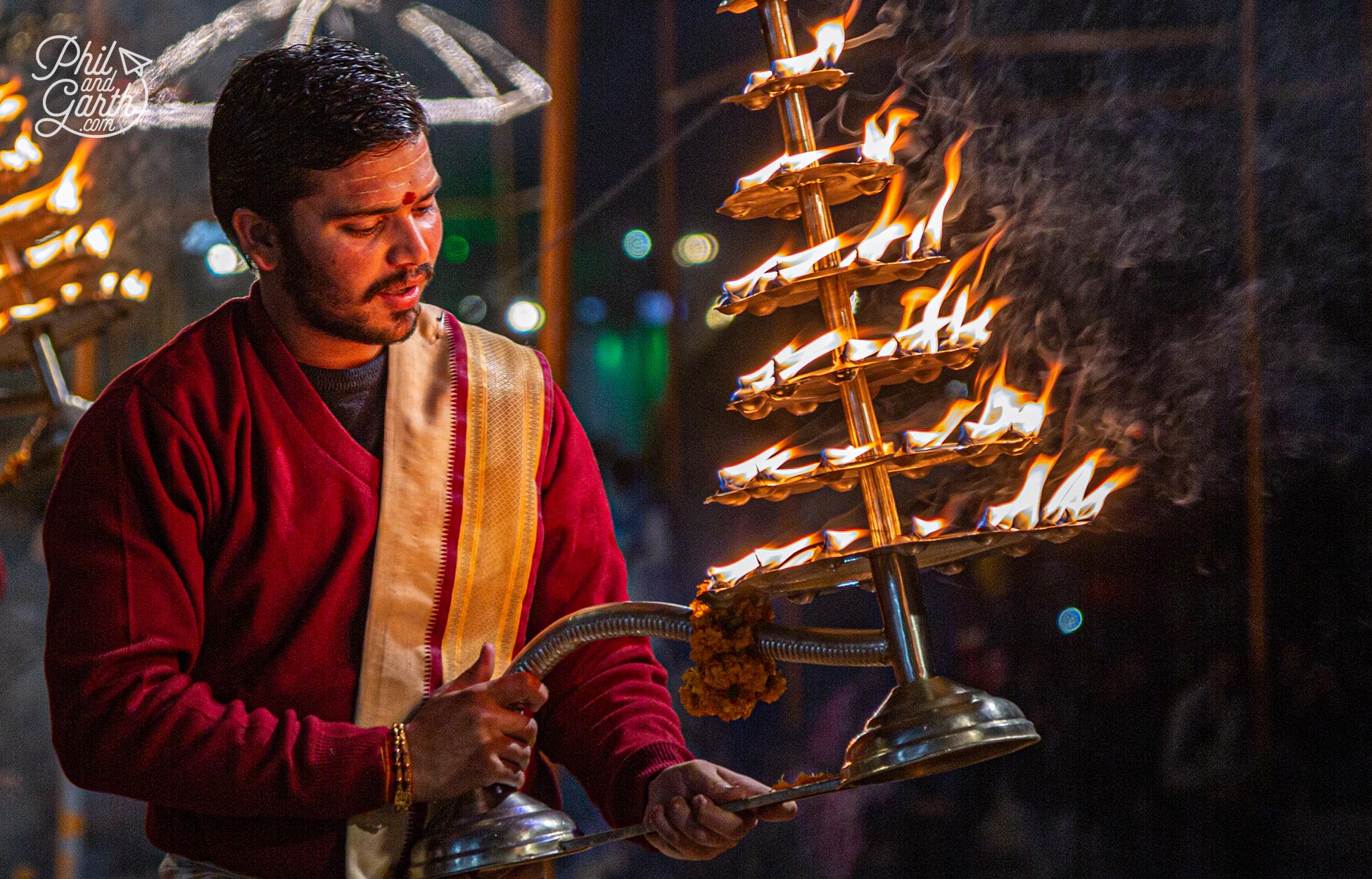
The prayer ceremony uses the light from deepas – big brass oil lamps
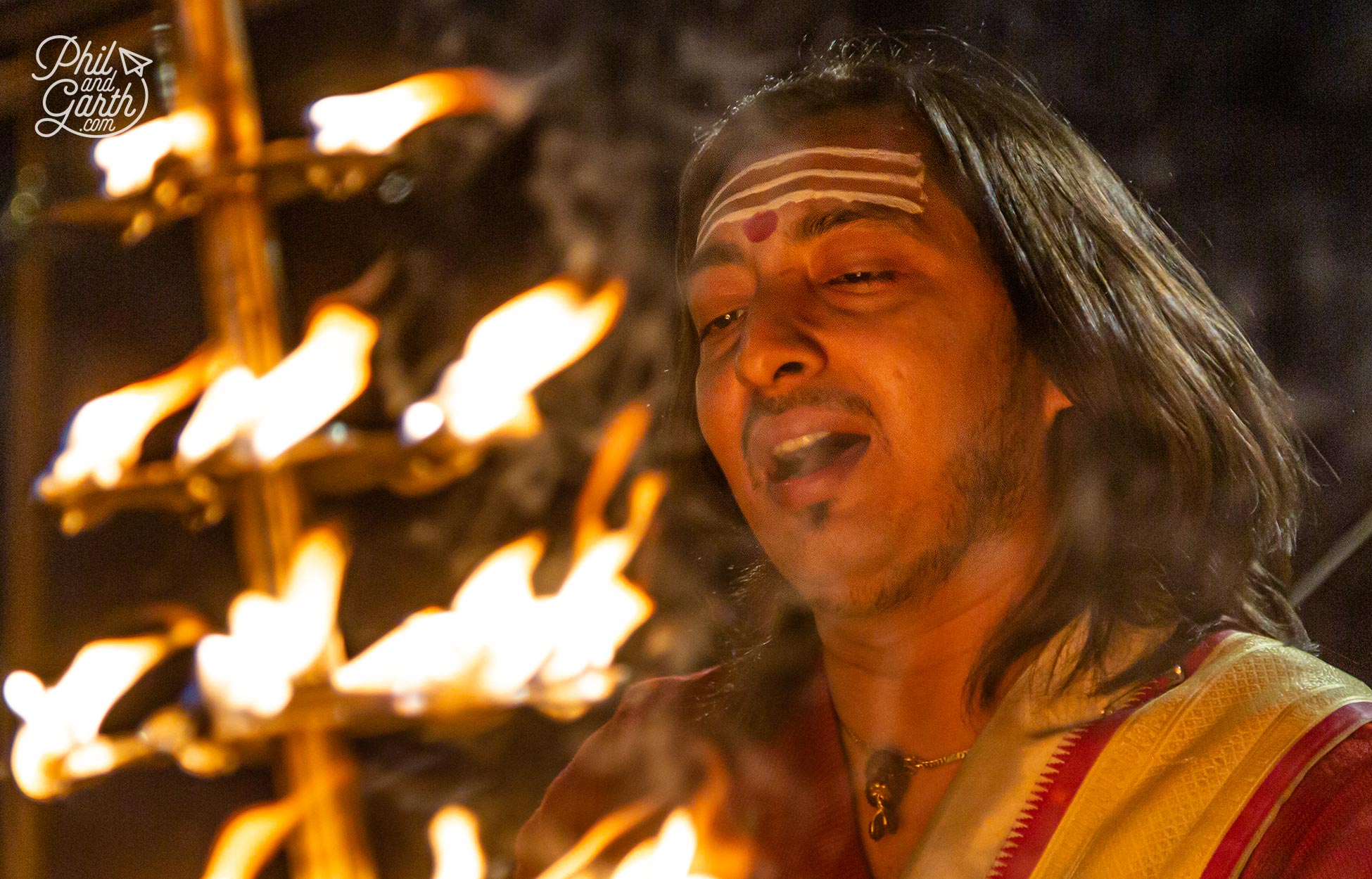
The evening Ganga Aarti ceremony lasts around 45 minutes
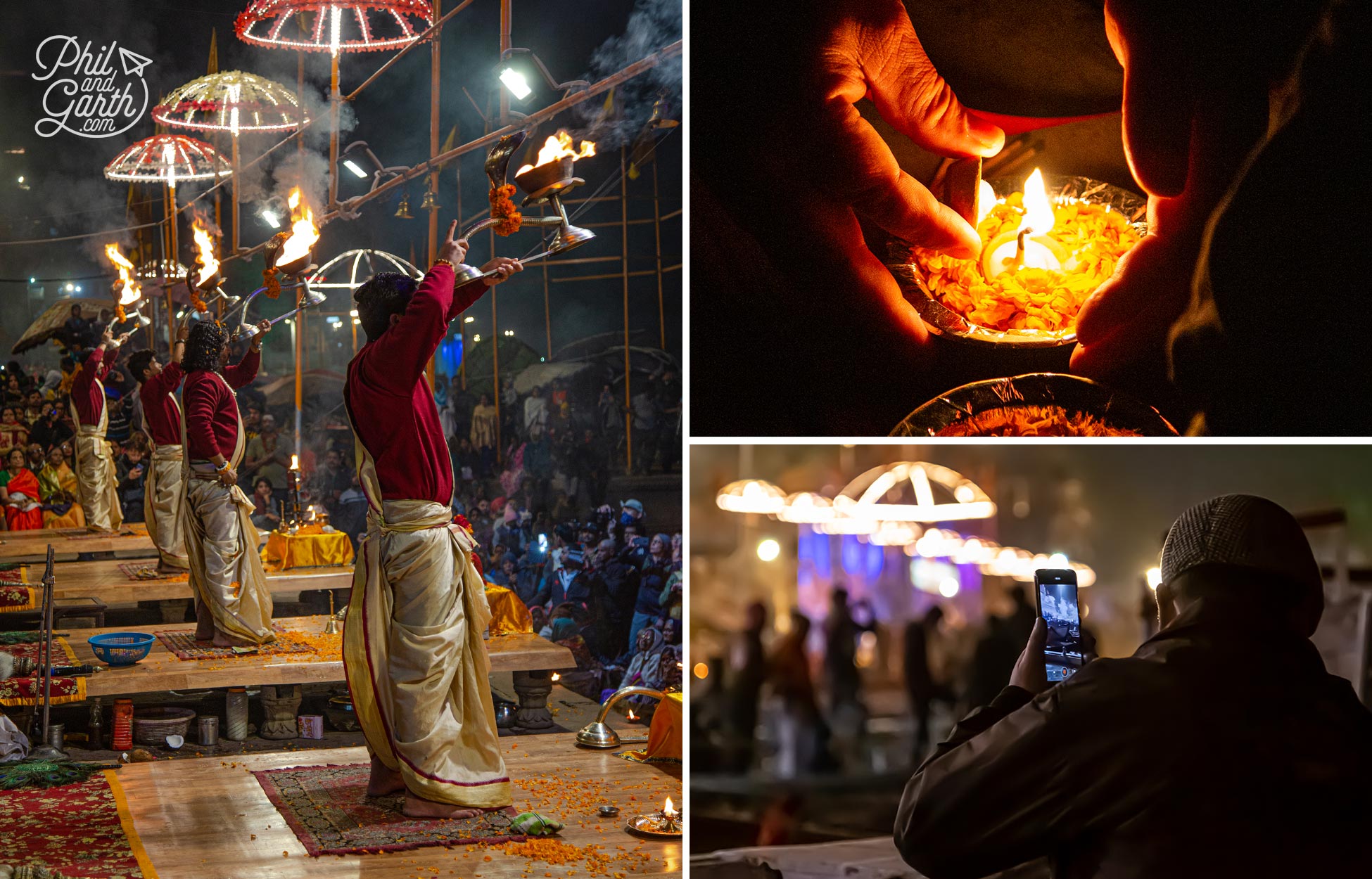
The must see cultural experience of Varanasi
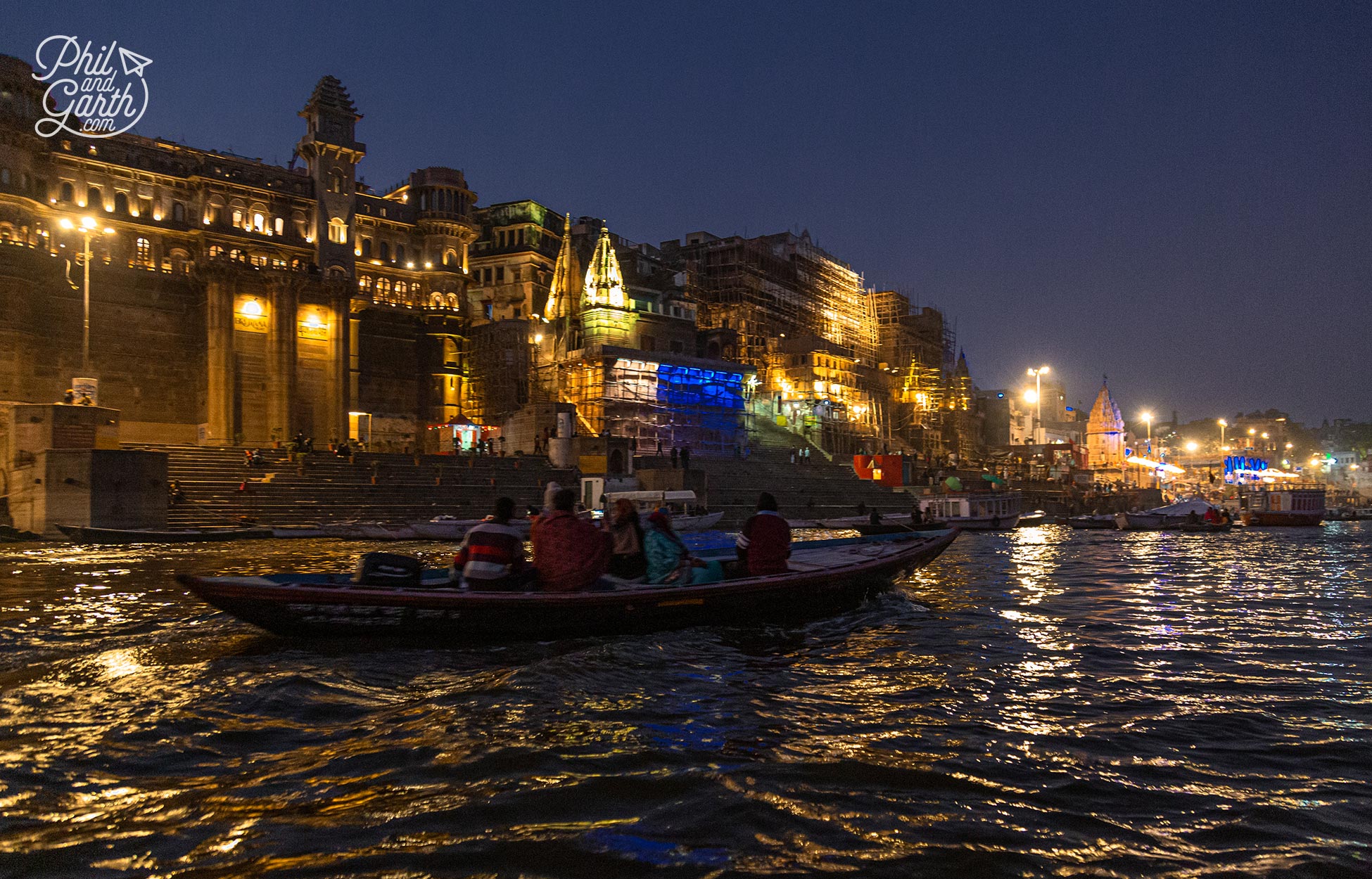
The journey back was fascinating as we listened to the sounds of the ghats – like the sound from a sitar
Sadhus of Varanasi
In Varanasi you will see lots of Sadhus, these are holy men who have said goodbye to possessions, family and lead a celibate life. They wear very simple clothing usually orange and dedicate their lives to prayers and rituals like meditation and yoga to achieve enlightenment and liberation from reincarnation. Some cover themselves in ash or chalk according to the god they have devoted themselves to, others also smoke pot all day. We approached a couple of sadhus and asked if we could take their photo in return for a small donation (100 rupees).
We also walked past a group of 3 ‘Naga’ Sadhus – these are naked sadhus. They cover themselves in ashes of the dead and worship the god Shiva. We were with our guide Pema at the time, who said they might be ‘Aghori’ – sadhus who live a much more extreme lifestyle, which includes eating human flesh remains, OMG!
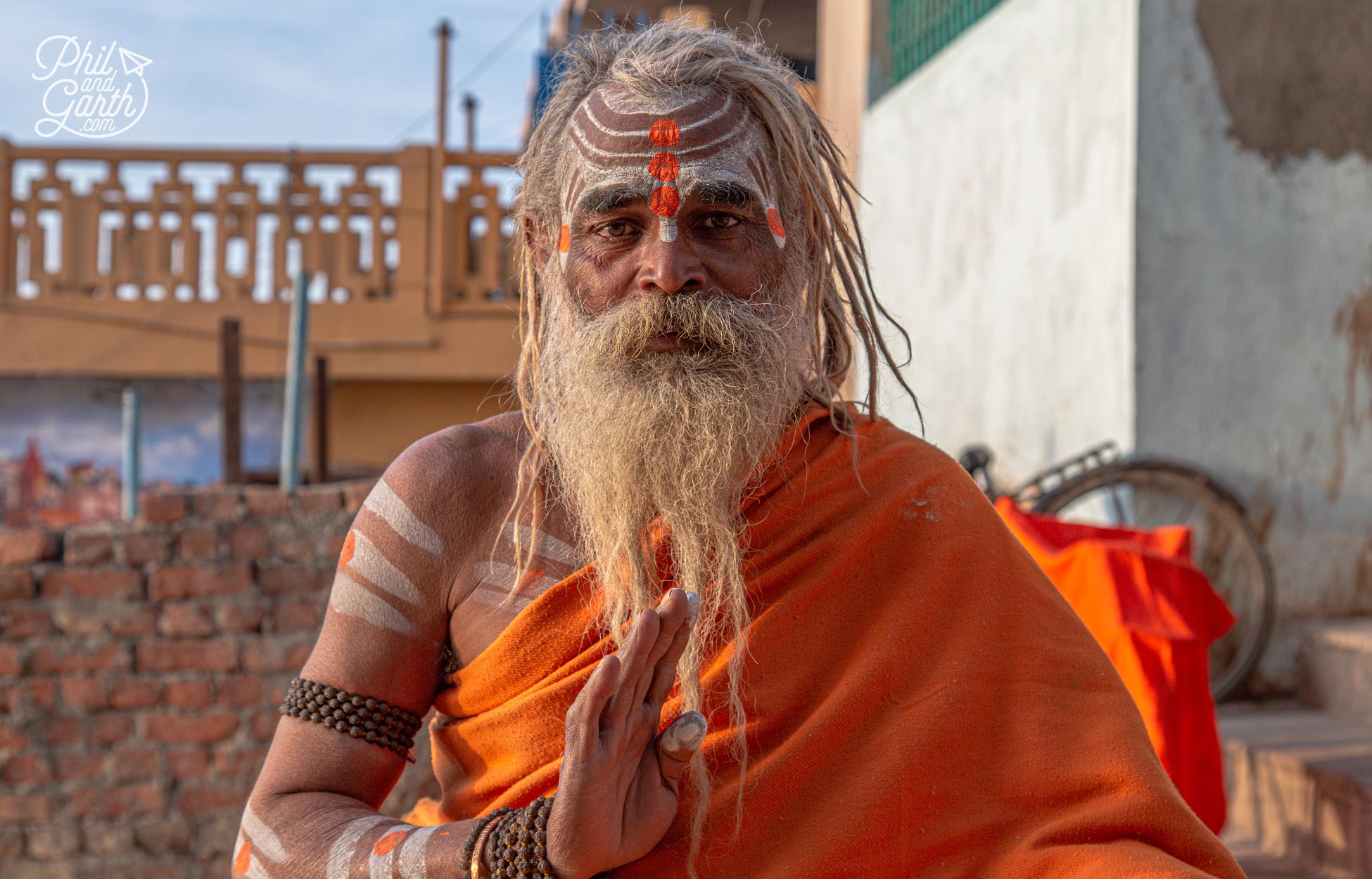
Sadhus in Varanasi have said goodbye to possessions and family
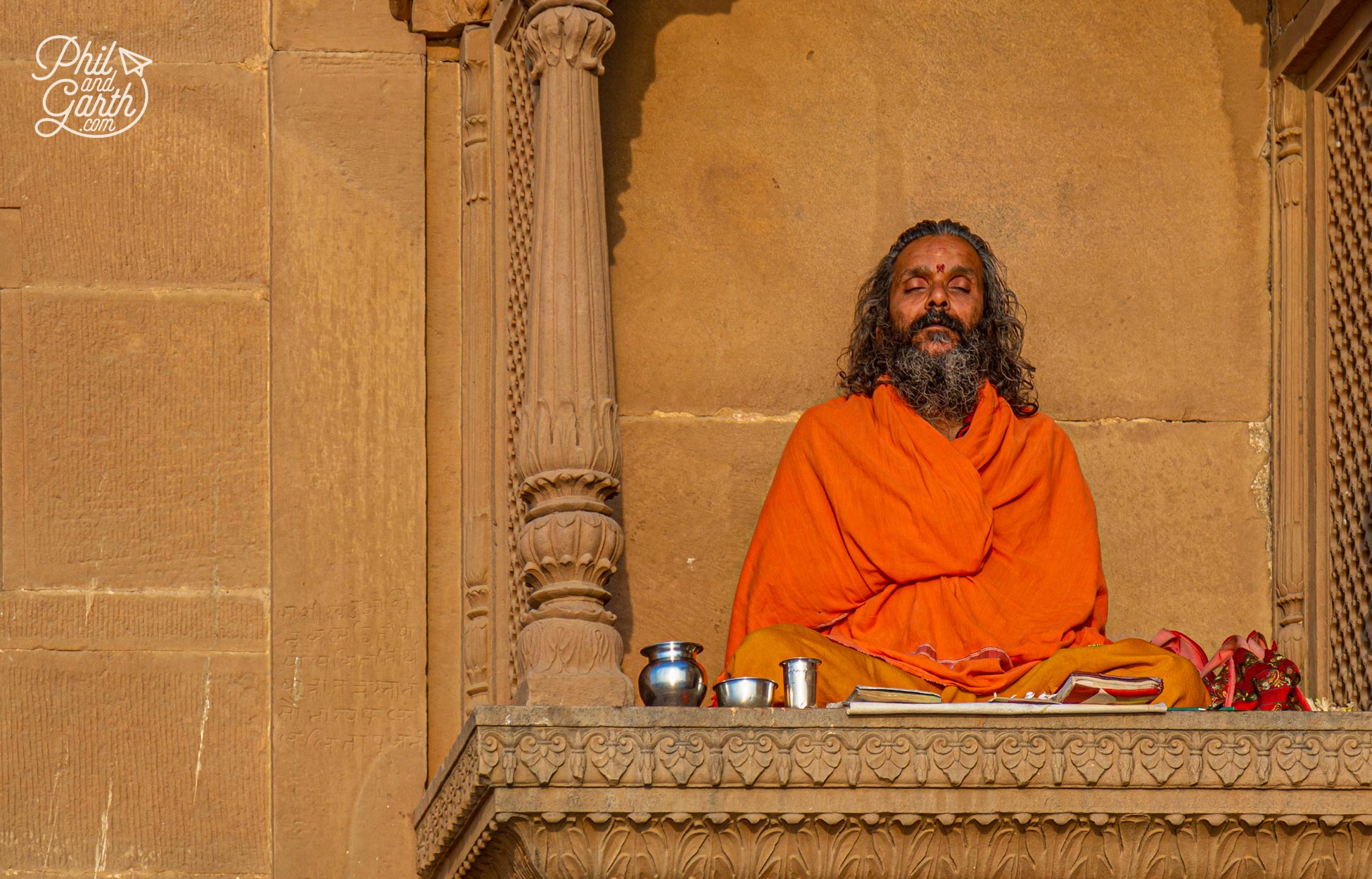
A sadhu meditating next to a temple
Temples
There are so many temples in Varanasi, over 23,000, yes! wow. Kashi Vishwanath Temple is the oldest and most popular to visit. Non-Hindus are generally not allowed to enter Hindu temples, but you can view them all from the outside with glimpses to the inside. The Tulsi Manas Temple welcomes everyone.
Back and Side Streets
The back streets and alleys are fascinating to wander around with tiny shops, hawkers and street food and plenty of holy cows getting in your way. This really is one of the best things to do in Varanasi – embrace the scenes of local life. Some side streets are like a maze and every nook and corner usually present itself with brilliant photographic opportunities. We got some of our best photos of Varanasi just wandering around, especially on the streets behind the Dashashwamedh Ghat. We also passed a couple of funeral processions with bodies carried on stretchers. Bodies are bandaged up or covered in orange cloths so thankfully we didn’t see any body parts. Some streets do smell of wee or burning rubbish (everyone seems to burn their rubbish in India). Make sure you look down for cow and dog poo especially at night as some streets are poorly lit.
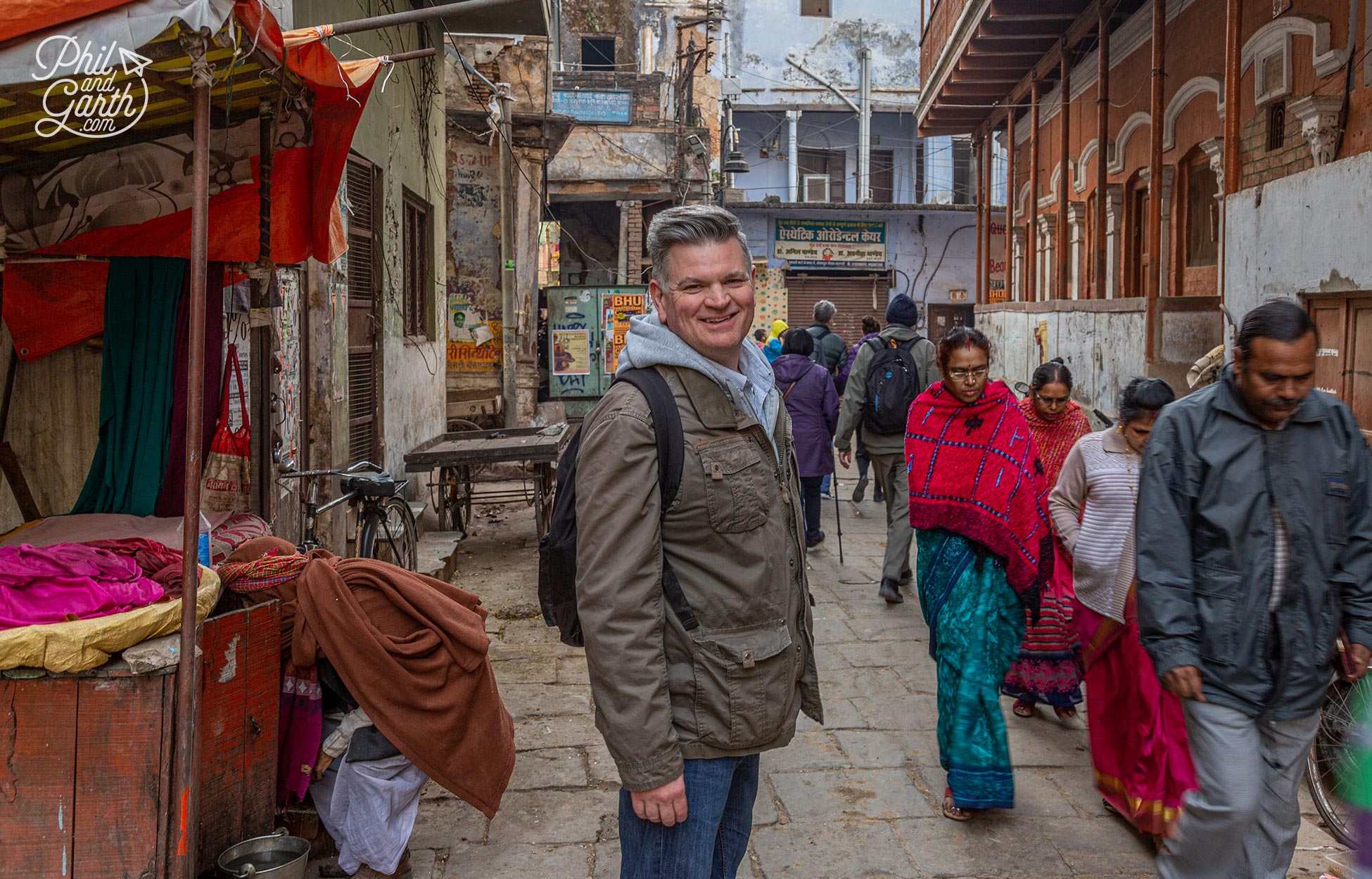
The back and side streets of Varanasi are fascinating to wander around
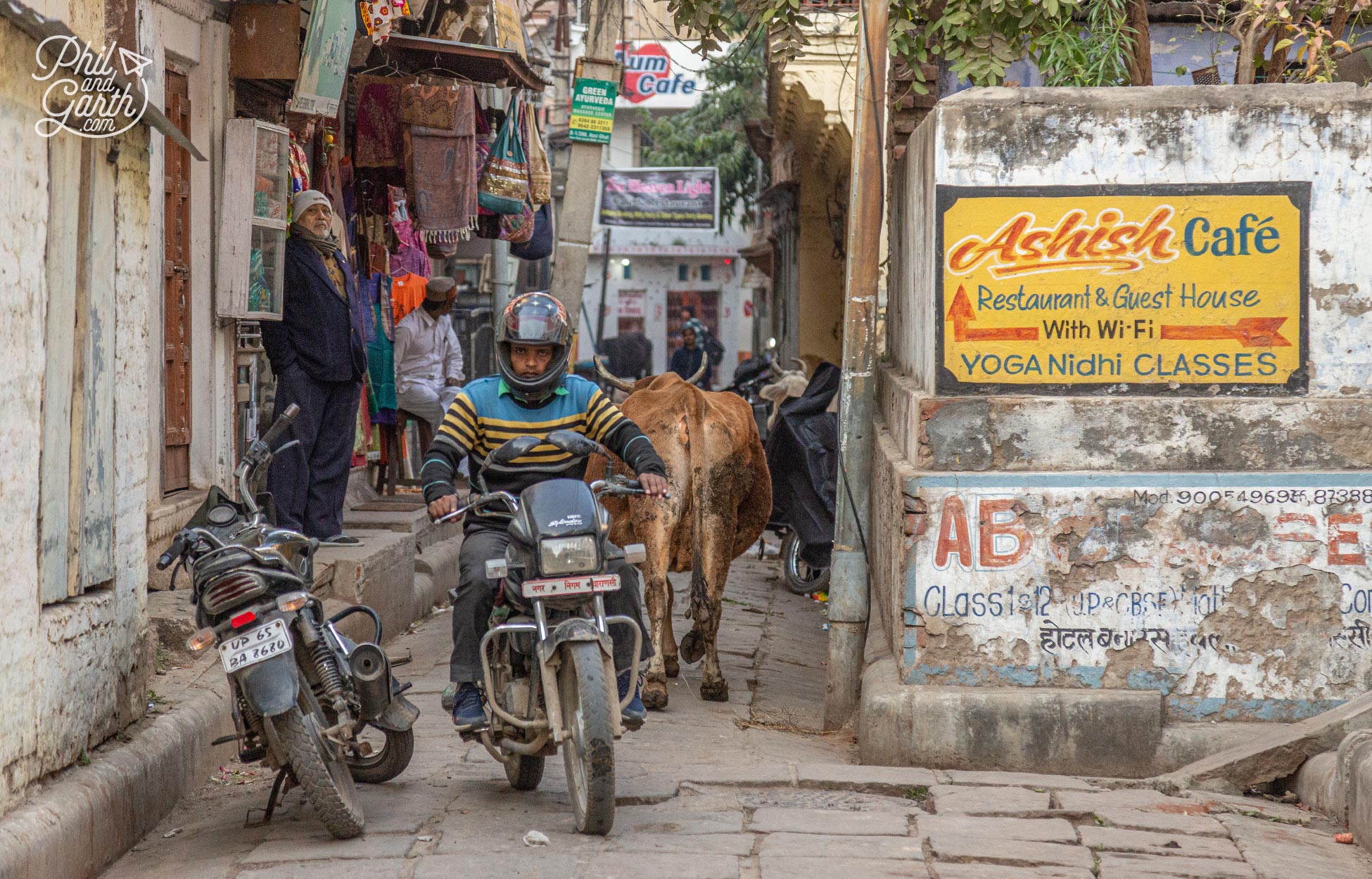
People, motorbikes and holy cows share some of these tiny streets
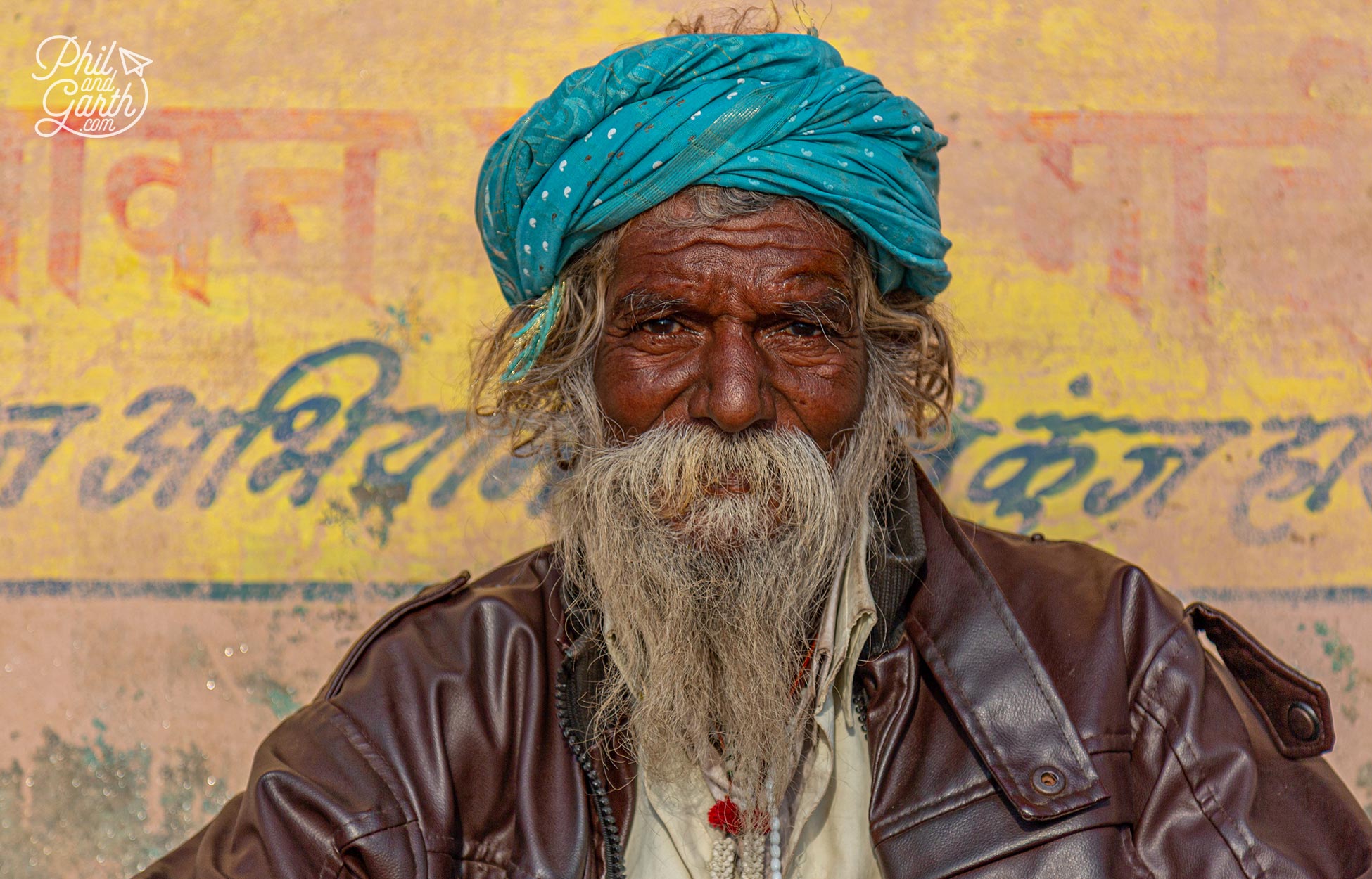
We asked this handsome chap if we could take his photo, he kindly agreed
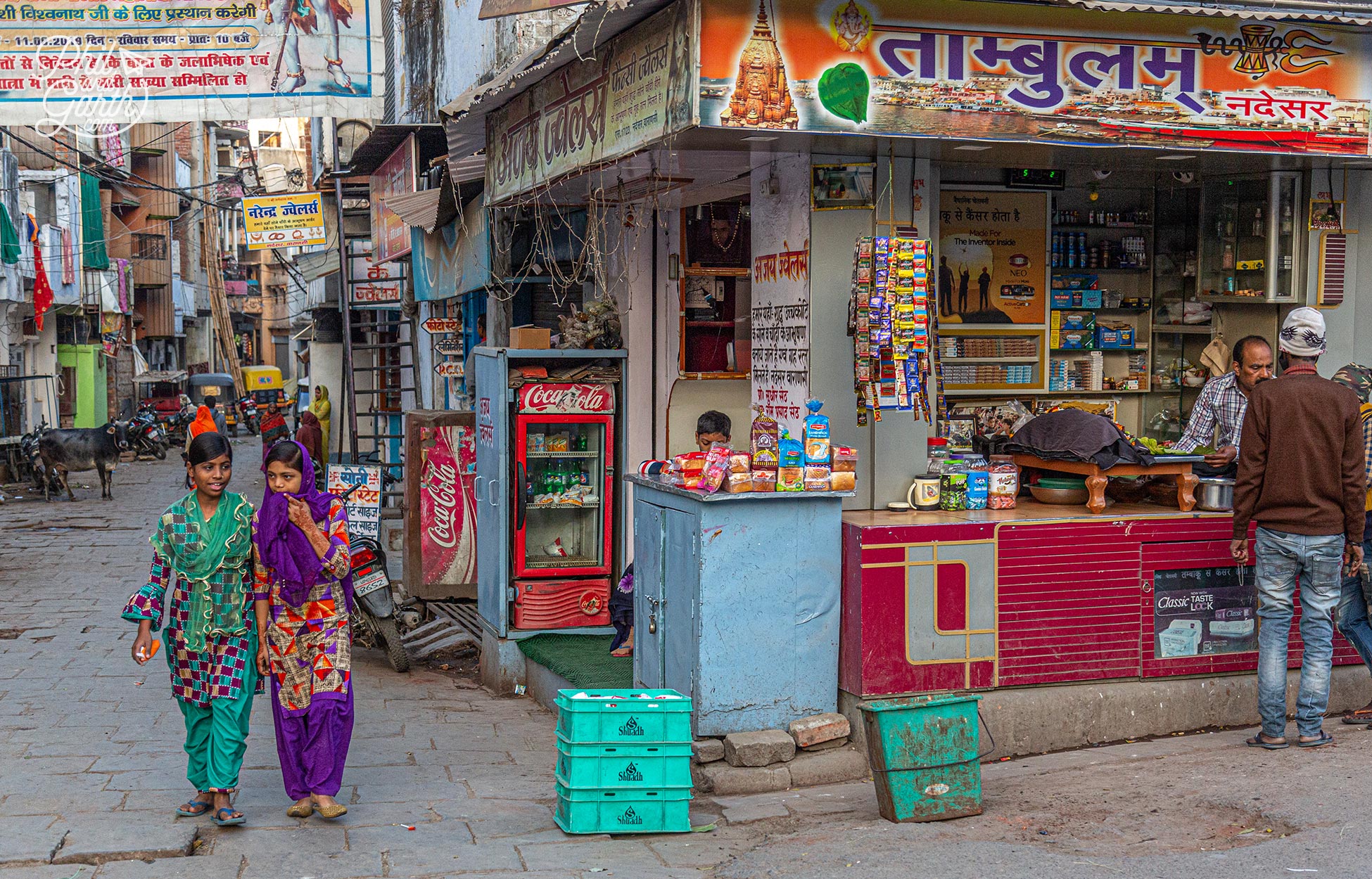
Take some time to wander around the back streets

Plastic bottles for sale – so people can take home some holy water from the River Ganges.
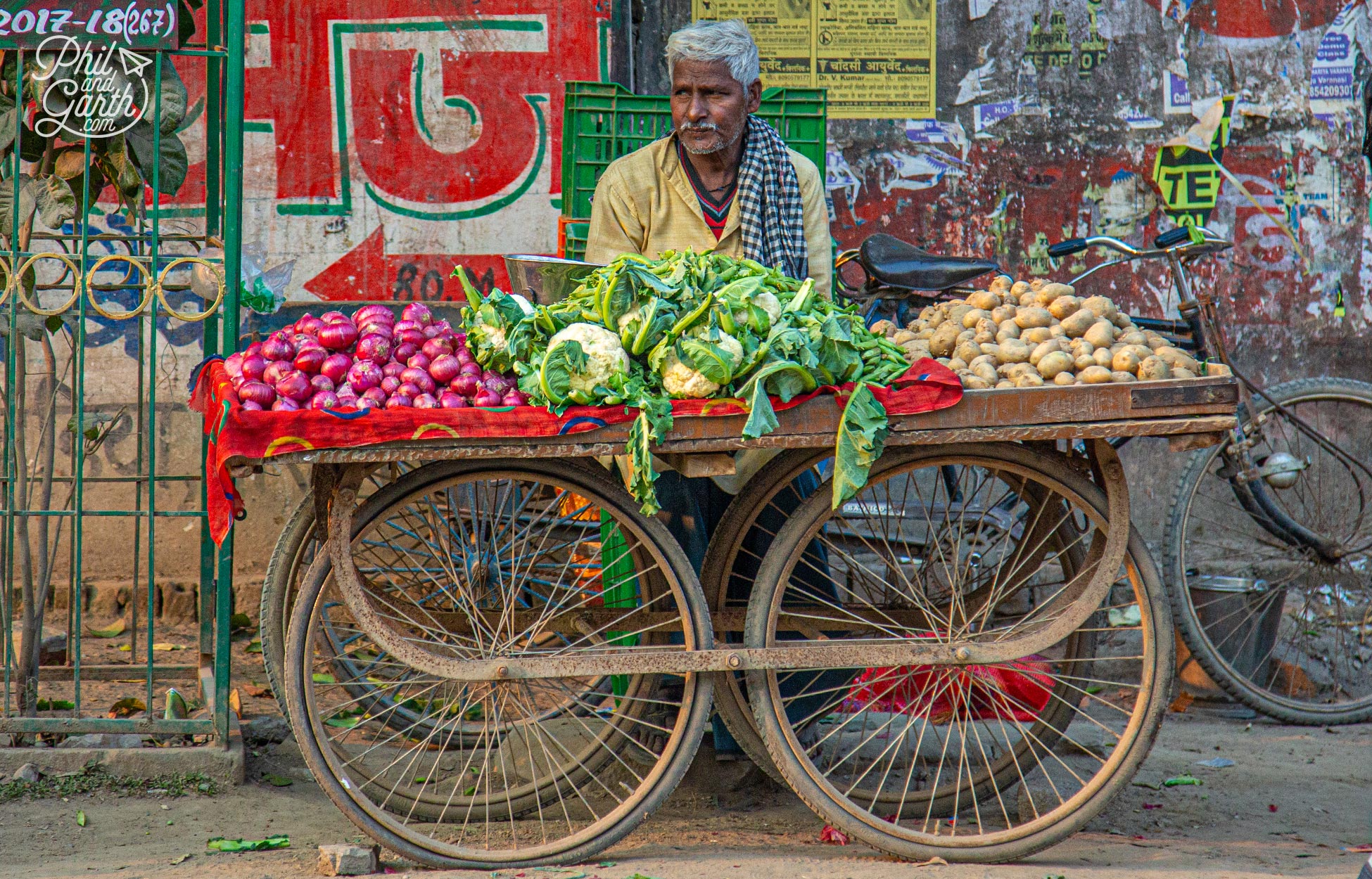
A guy selling onions, cauliflowers and potatoes
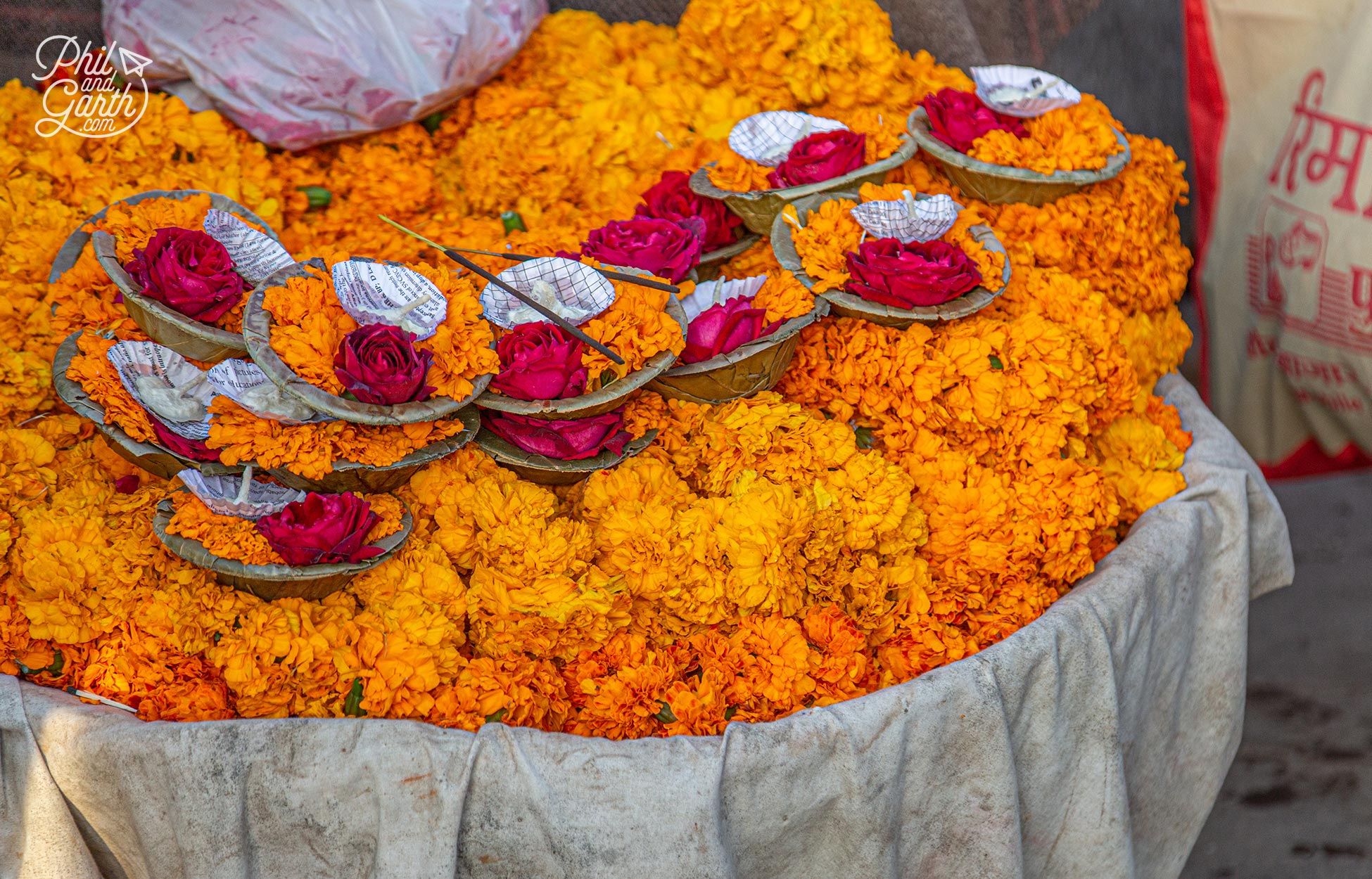
Deepaks for sale – little leaf bowls containing a prayer candle, marigold and rose flowers
Varanasi Street Art
Varanasi was the only place on our tour of India where we saw lots of street art. It came as a pleasant surprise for Garth, especially as he loves street art. Most artworks are painted on the walls at the top of the ghats.
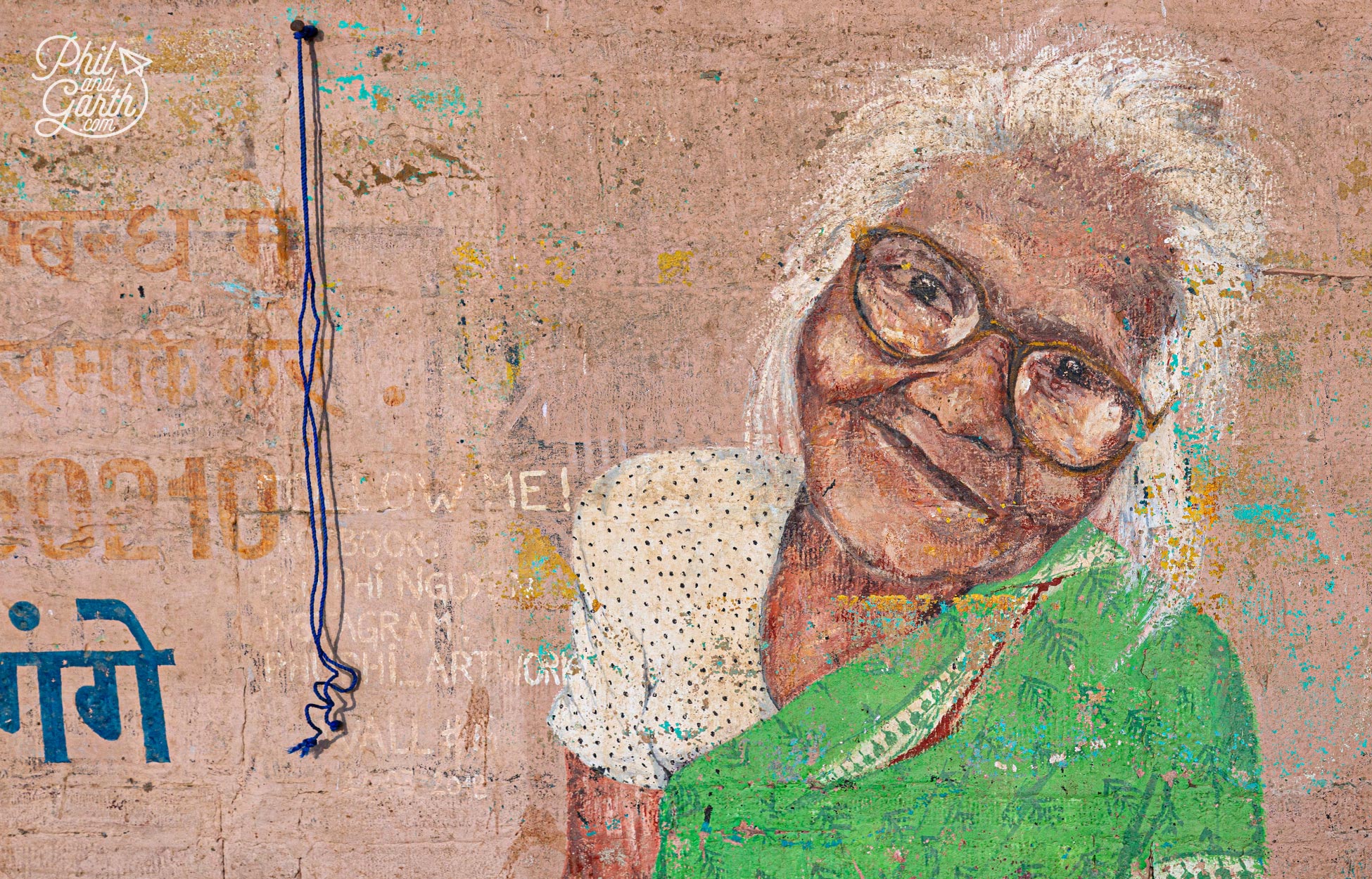
So much street art in Varanasi like this mural of an old lady
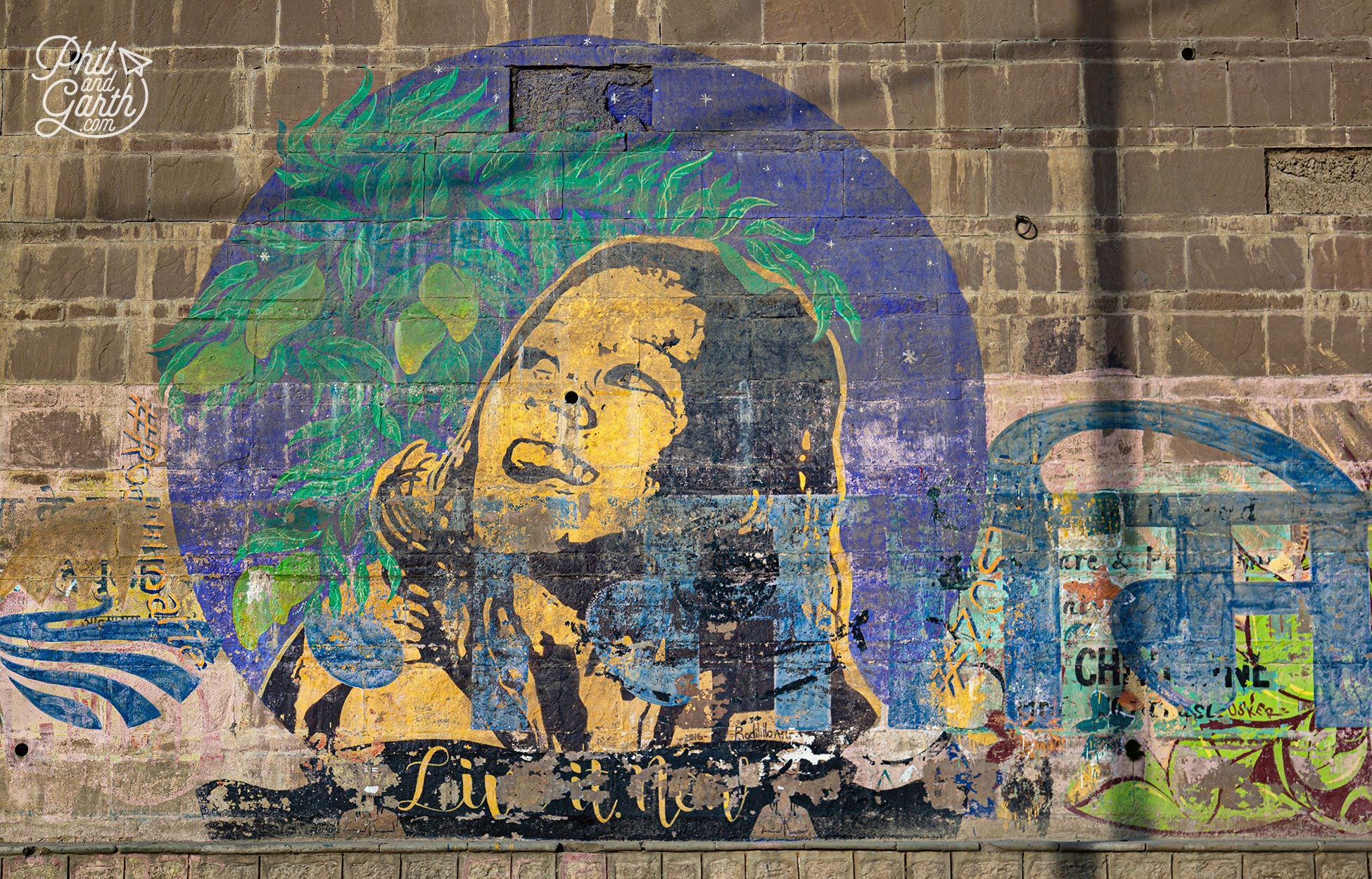
Looks like this artwork is called ‘Live It Now’
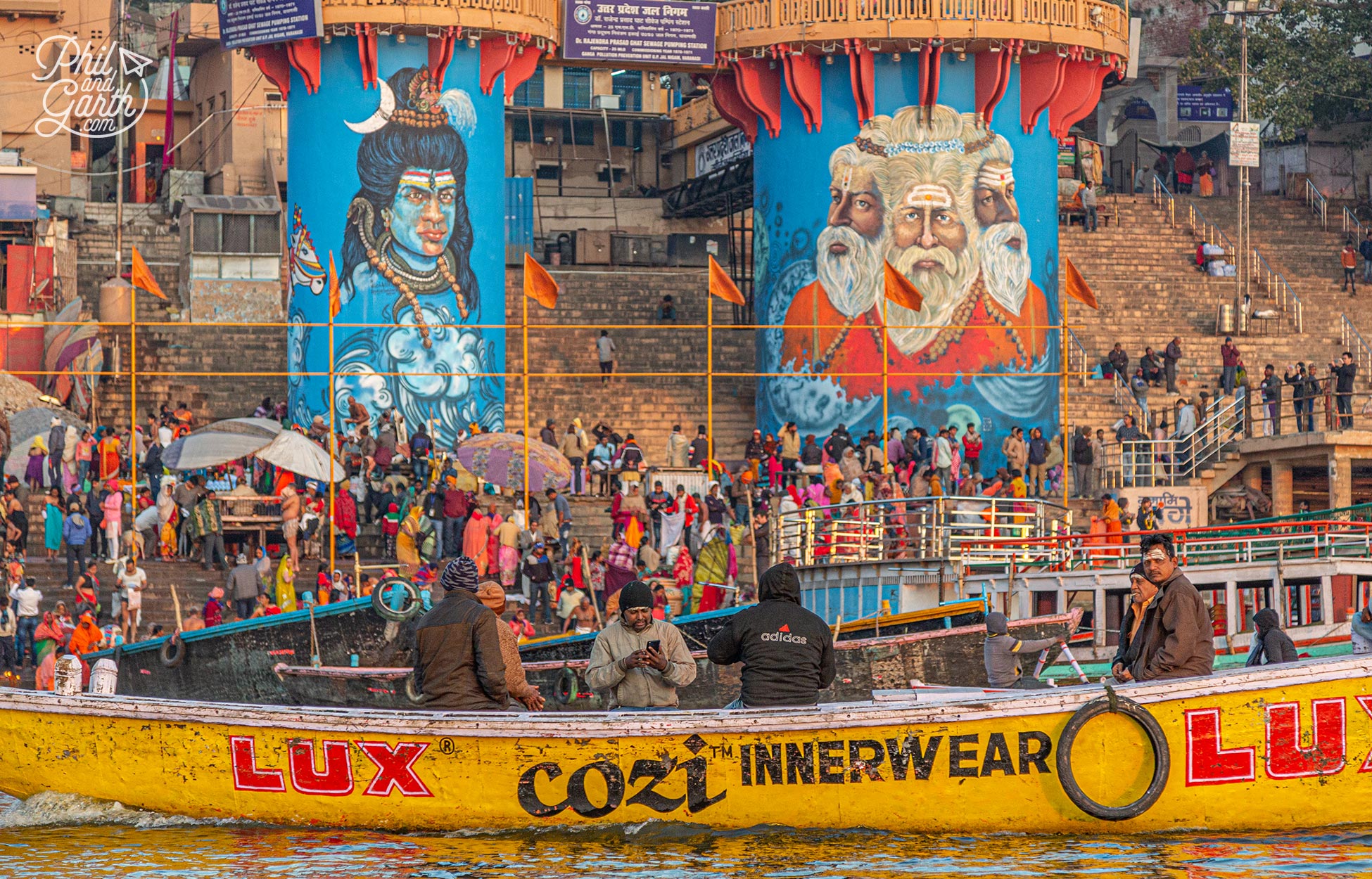
Even these sewage pump towers are decorated with some street art. The right tower has the face of Brahma
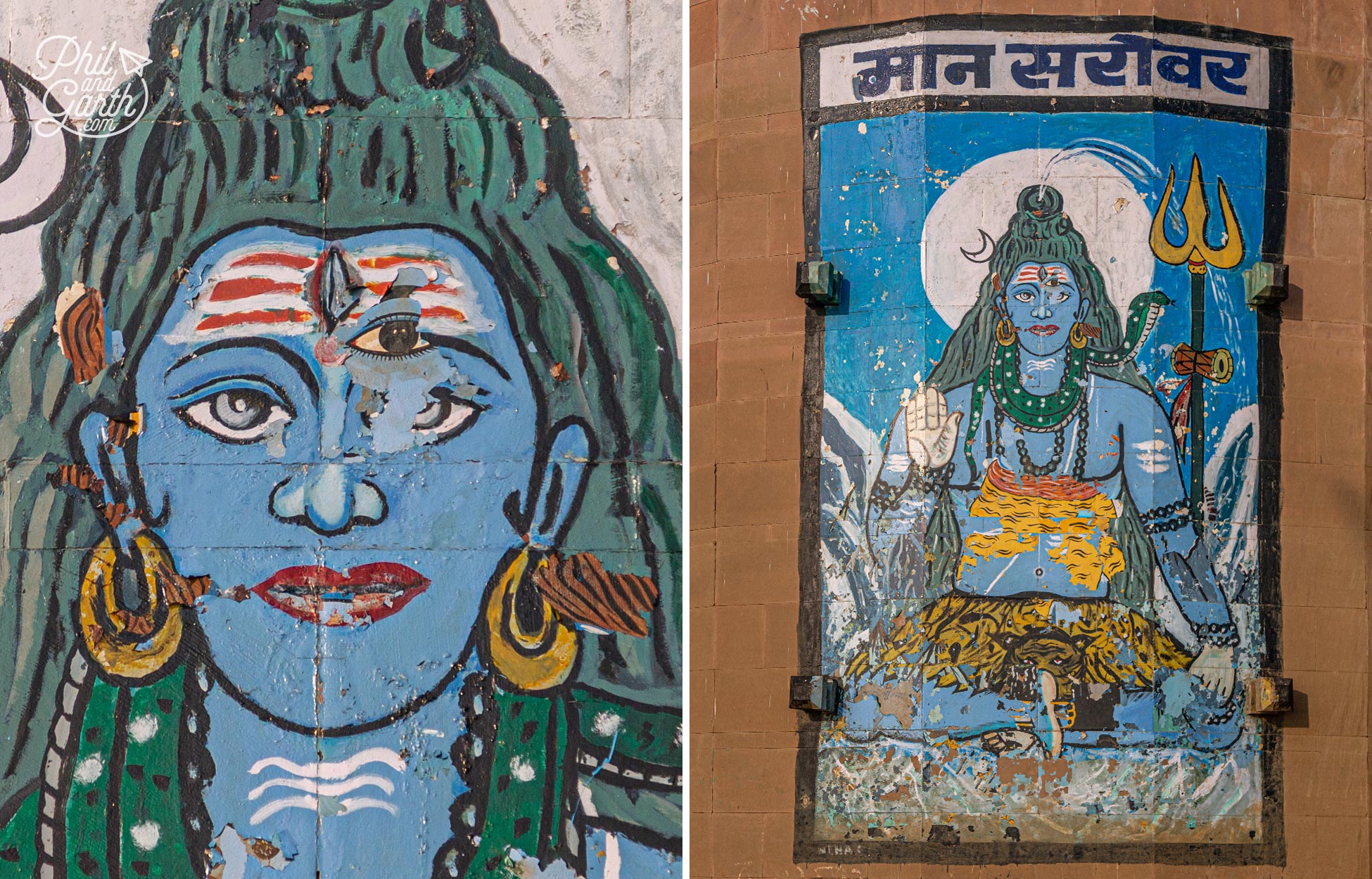
A large artwork on a wall depicting the Hindu god, Shiva
Getting Around Varanasi
Our hotel was 20 minutes from the ghats so we took a tuk tuk each time to get there. Be warned the roads in Varanasi are super busy, with easily the worst traffic we had experienced in India with everyone tooting their horns constantly. The volume is incredible and overwhelming, especially with Garth screaming at the sights of stray dogs nearly been hit on the roads. The fumes and pollution on the streets are also really bad, especially worse sat in the back of a tuk tuk. It’s amazing that no one wears a face mask, not even the policemen directing traffic stood right in the middle of the road all day.
Every tuk tuk driver we had spoke decent English and always wanted to take us to their sister or brother who had something to sell. They are quite pushy and try really hard to take you somewhere, asking if we were interested in buying silk or jewellery. We had to keep telling them politely “sorry, no thank you, we’re not interested” which worked.
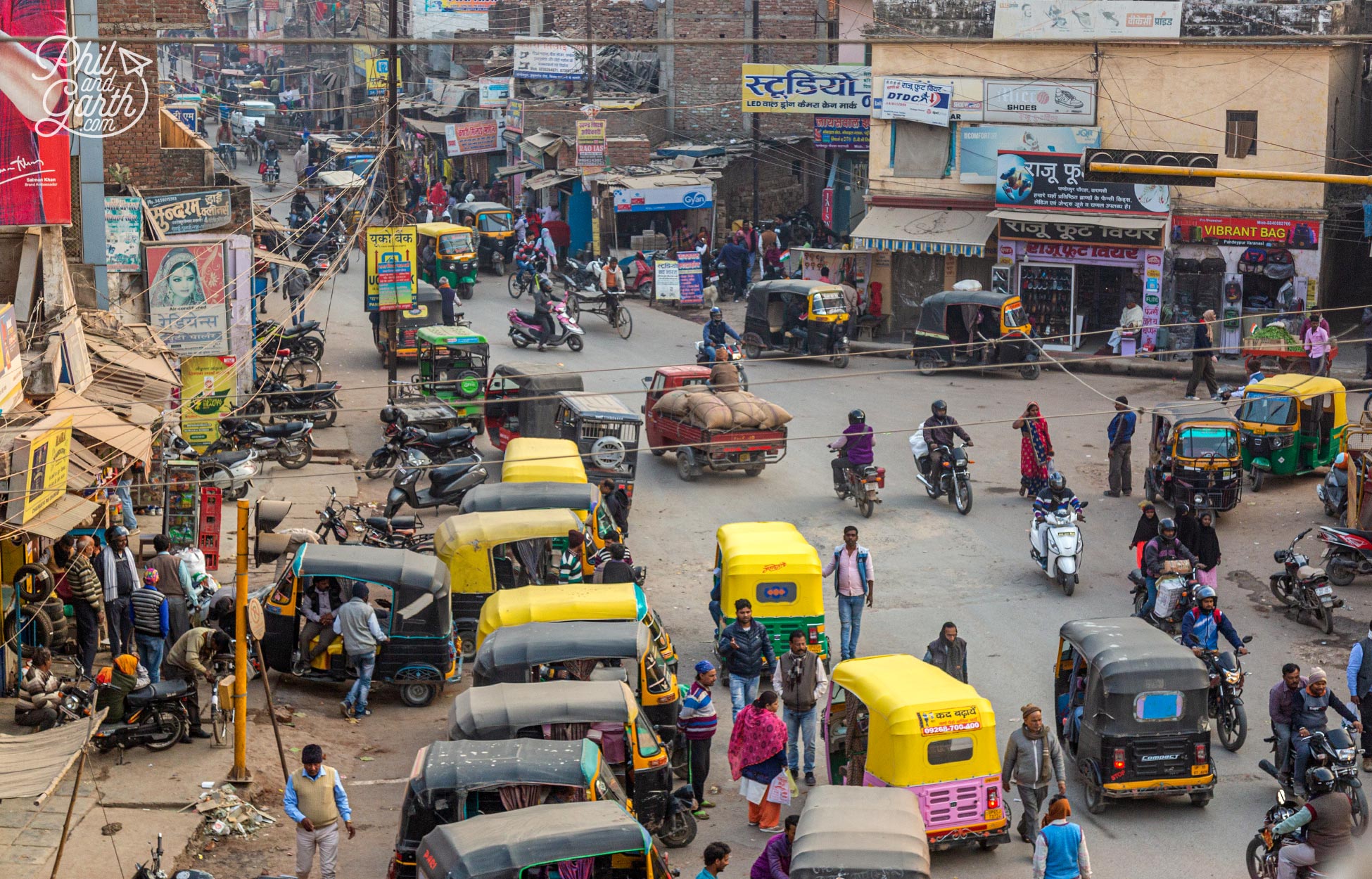
The crazy busy traffic. It’s like been in a video game with cars, tuk tuks all weaving in and out at the same time
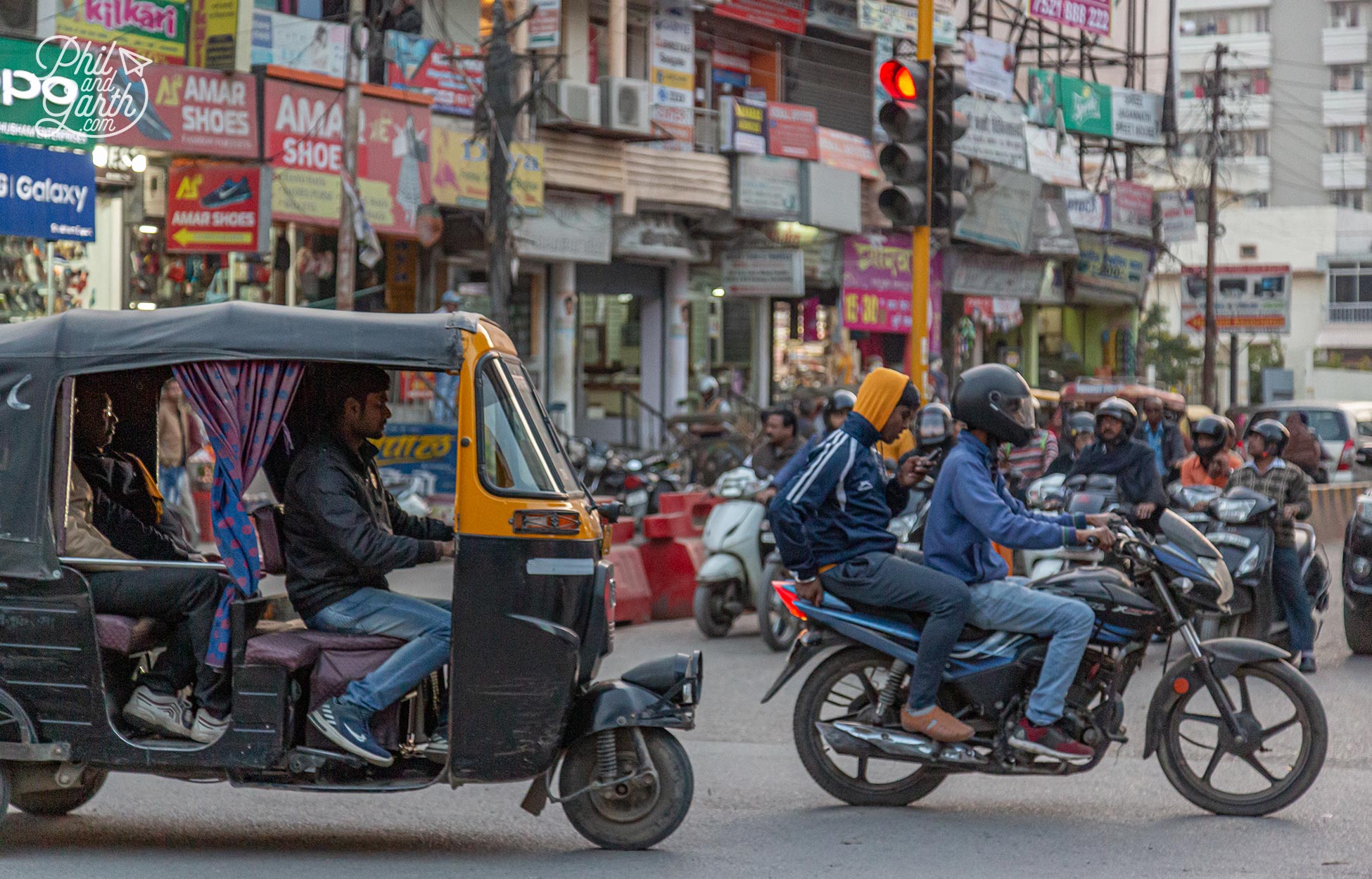
The traffic fumes and pollution were the worst we experienced in India
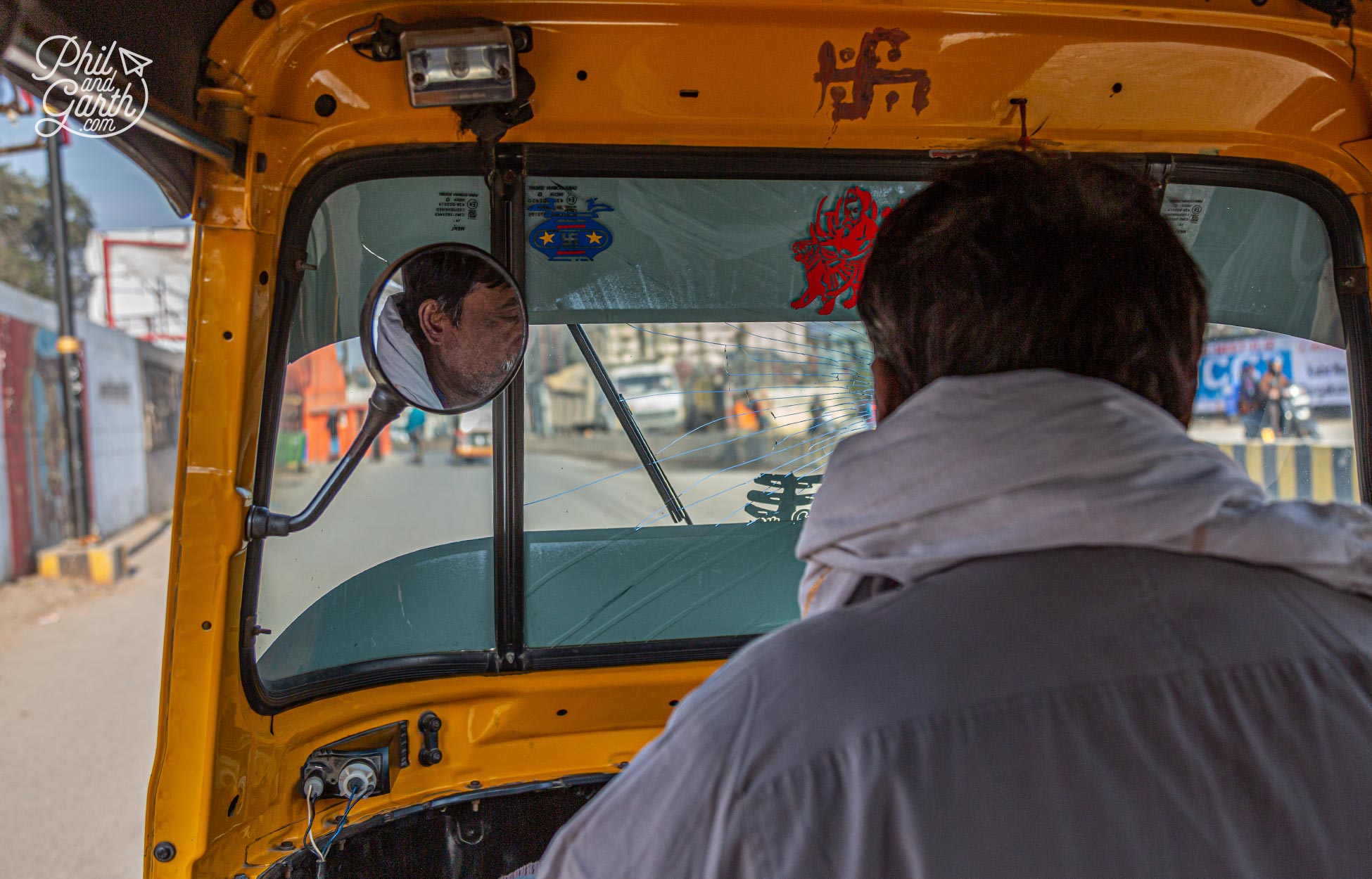
One of our many tuk tuk drivers
Sarnath – The Place Where Buddhism Began
On our last day in Varanasi we travelled to Sarnath – one the world’s 4 holiest sites for Buddhists. It’s 30 minutes from Varanasi and is where Lord Gautama Buddha preached his first sermon of peace to his five followers, around 500 BC. Sarnarth went on to become an important place of religion as Buddhism thrived here over hundreds of years and many monasteries were built. The remains of Sarnath and a couple of other attractions are all within walking distance of each other. It’s a busy location with lots of stalls on the roads with everyone wanting to sell you something.
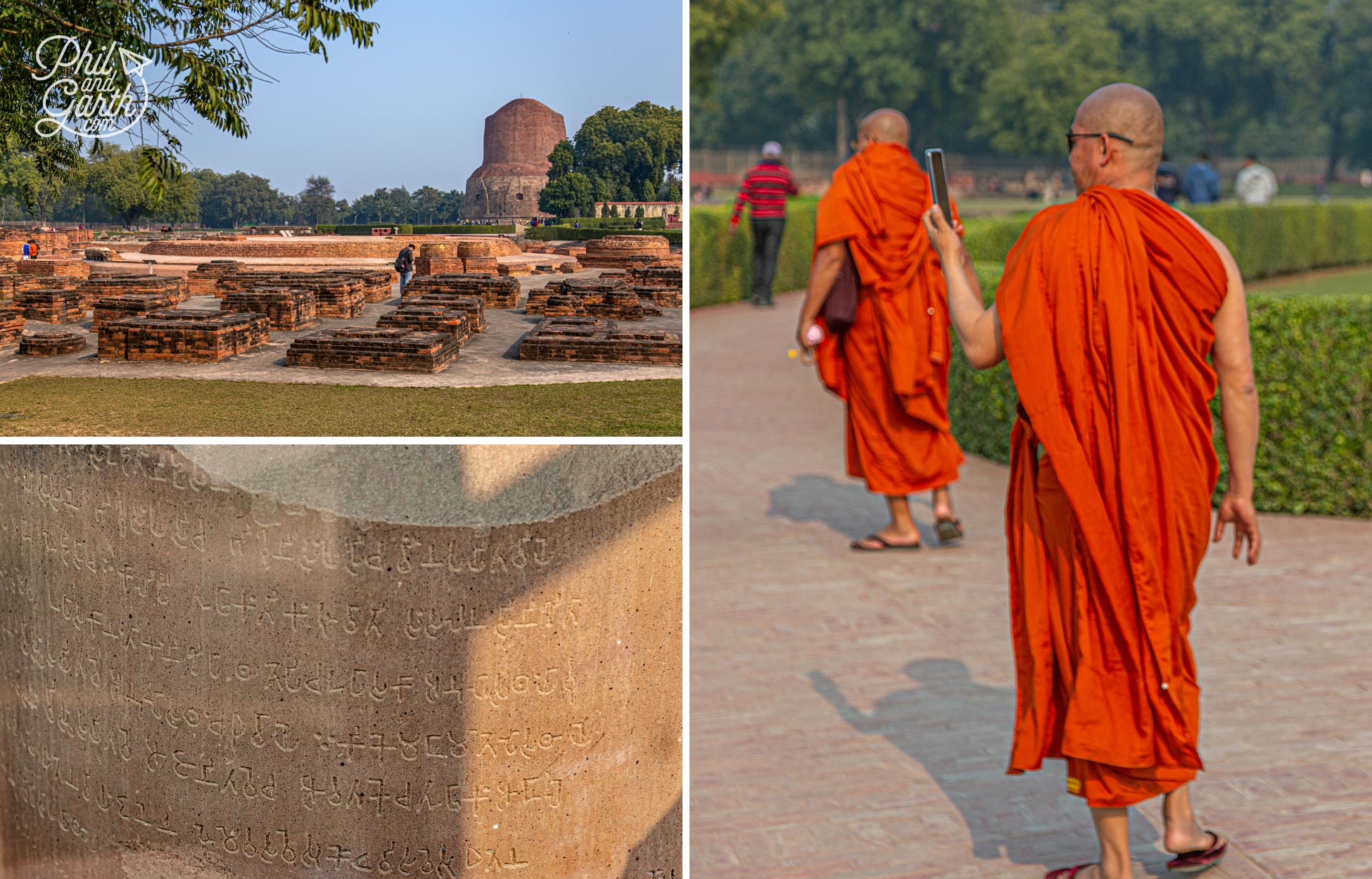
Sarnath is one the world’s holiest sites for Buddhists. It’s 8 miles from Varanasi and takes about 40 minutes to get there
Sarnath Stupa Complex
At the Sarnath Stupa complex you can see the impressive Dhamek Stupa built in 500AD. It was built to the mark the sacred spot where Buddha preached his first sermon. Various stupas like this one were built all across India to promote Buddhism. It’s a massive solid brick and stone structure and amazingly still has some the original carvings of flowers, birds, geometric patterns and people.
The ruins surrounding the stupa are the remains of this ancient city including multiple monasteries, shrines and courtyards built from the 1st century. Most of the structures were destroyed by the Turkish muslim invaders in the 12th century. British archeologists discovered the remains of Sarnarth in 1830 and began excavations, many of the artefacts from the 4th and 6th centuries can be seen in the museum next door.
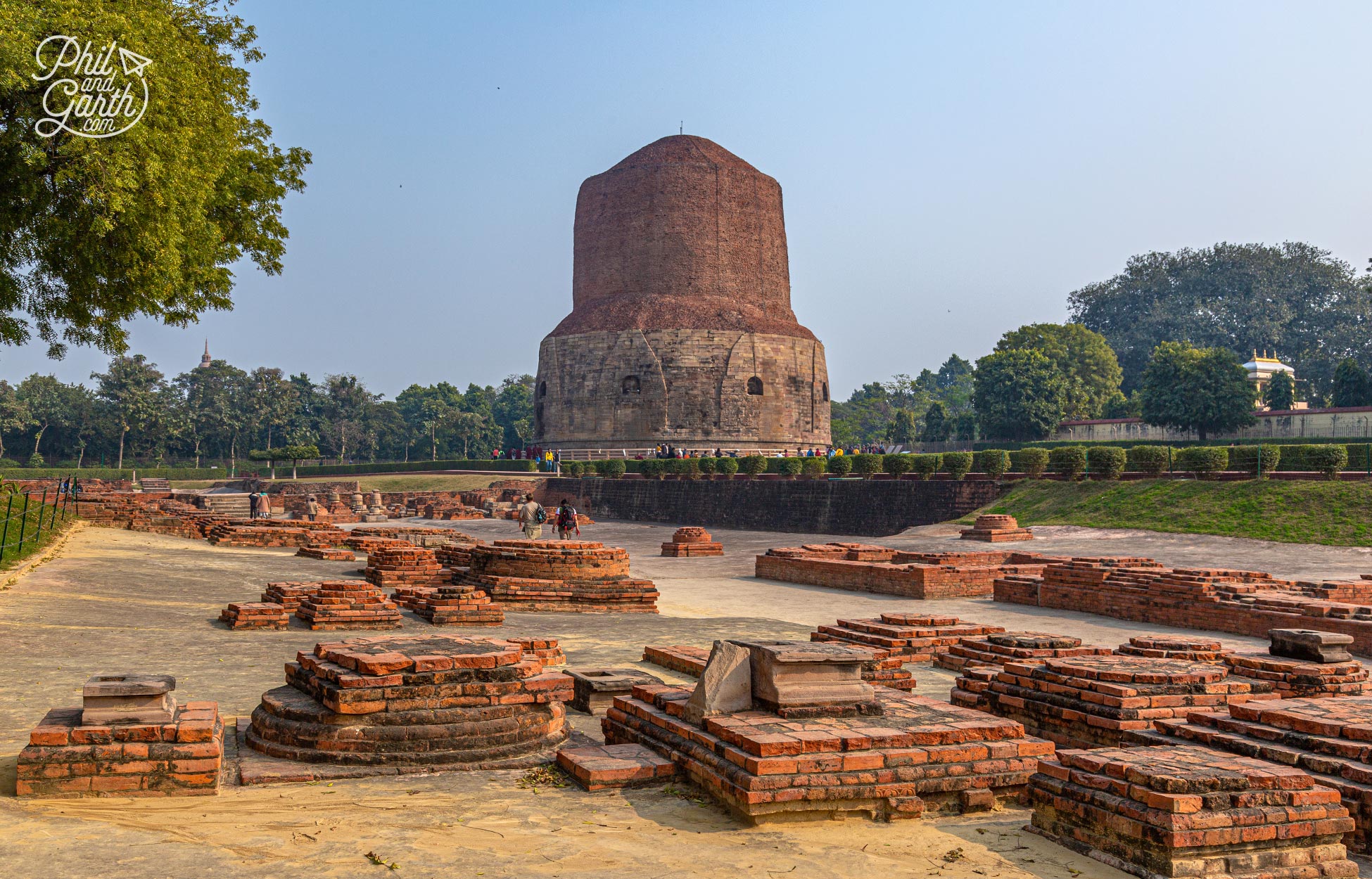
The Dhamek Stupa built in 500AD still stands at an impressive 43 metres
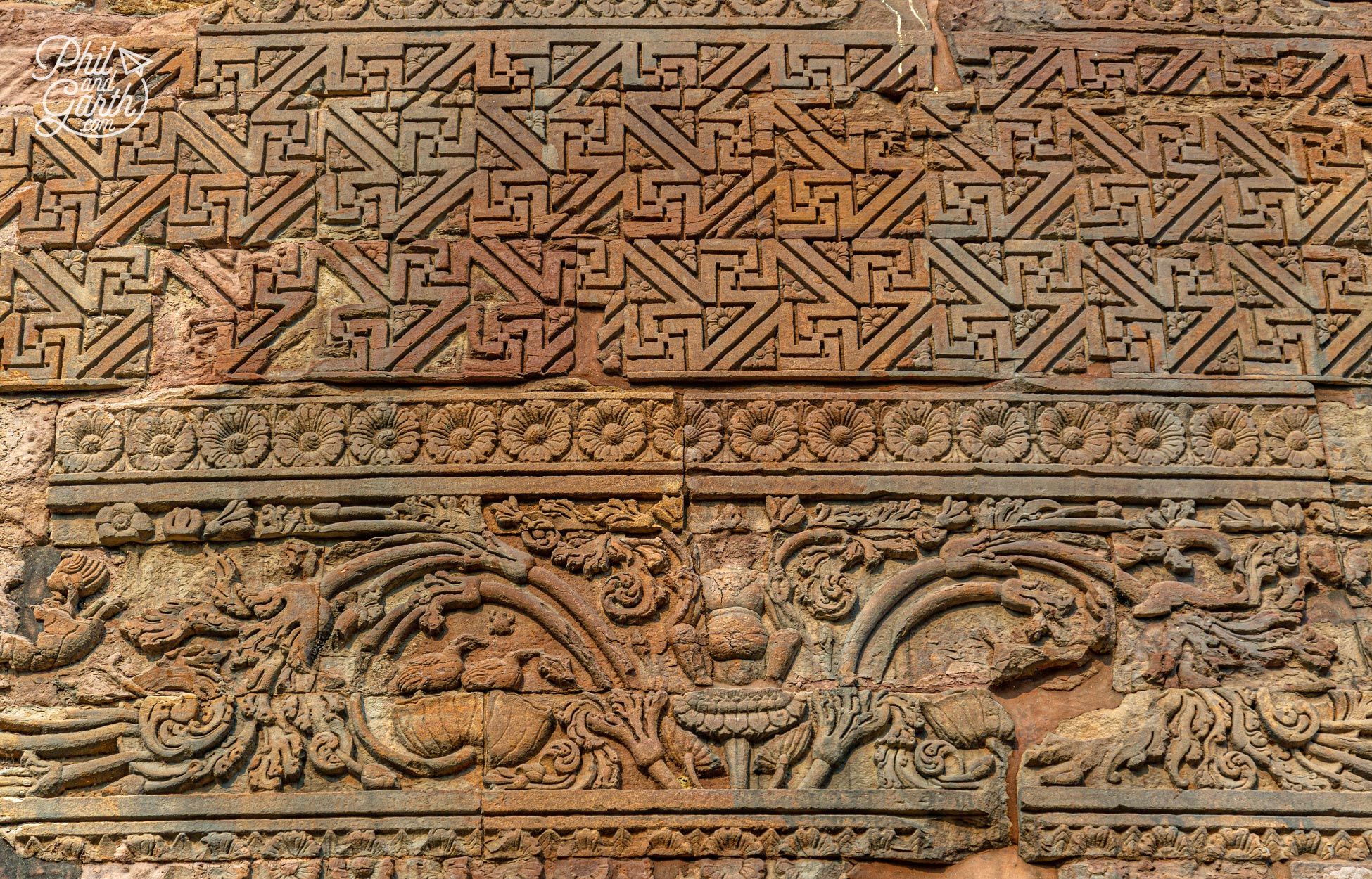
The Dhamek Stupa’s carvings include flowers, birds and people
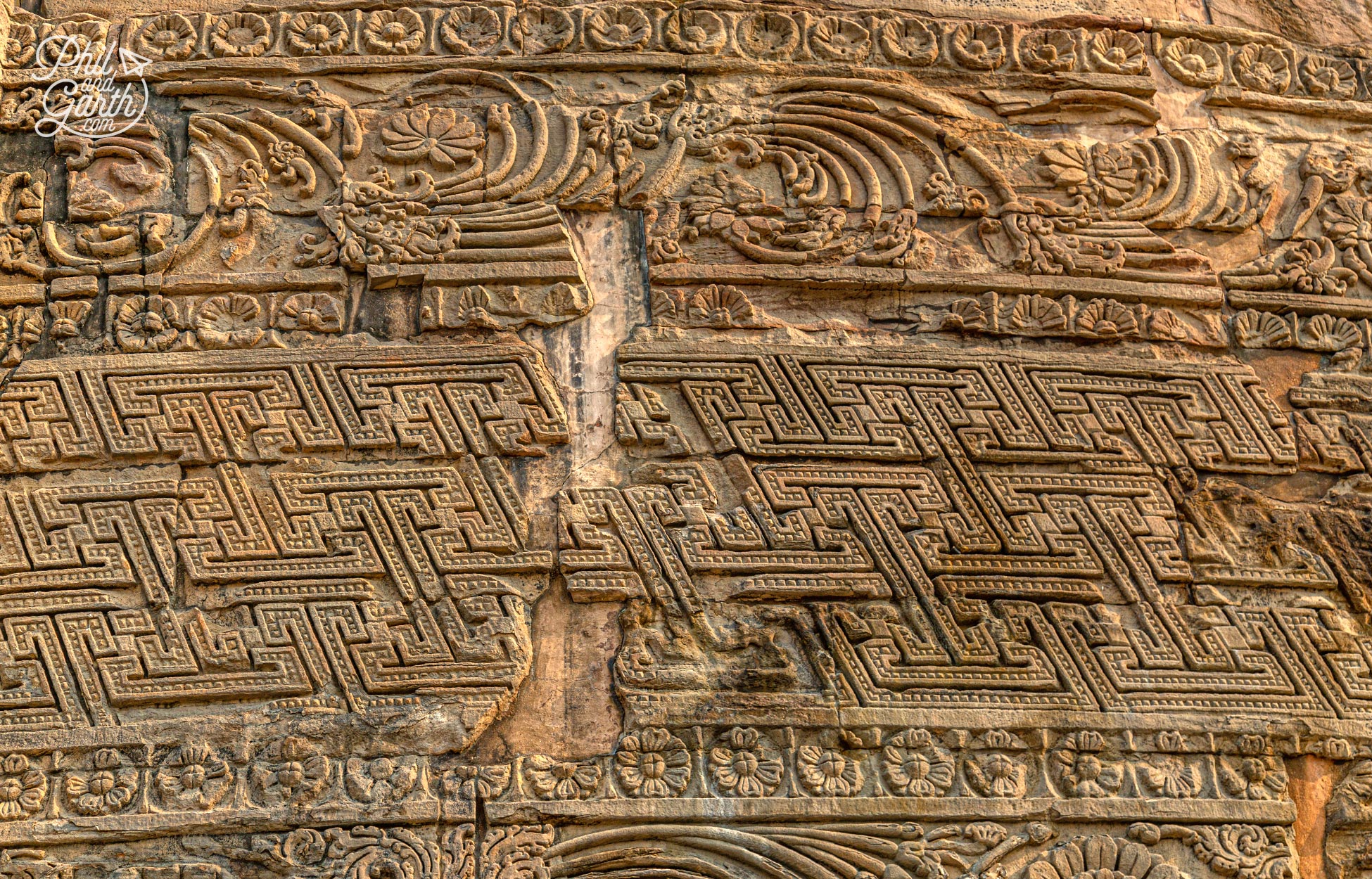
More of the floral and geometric stone carvings
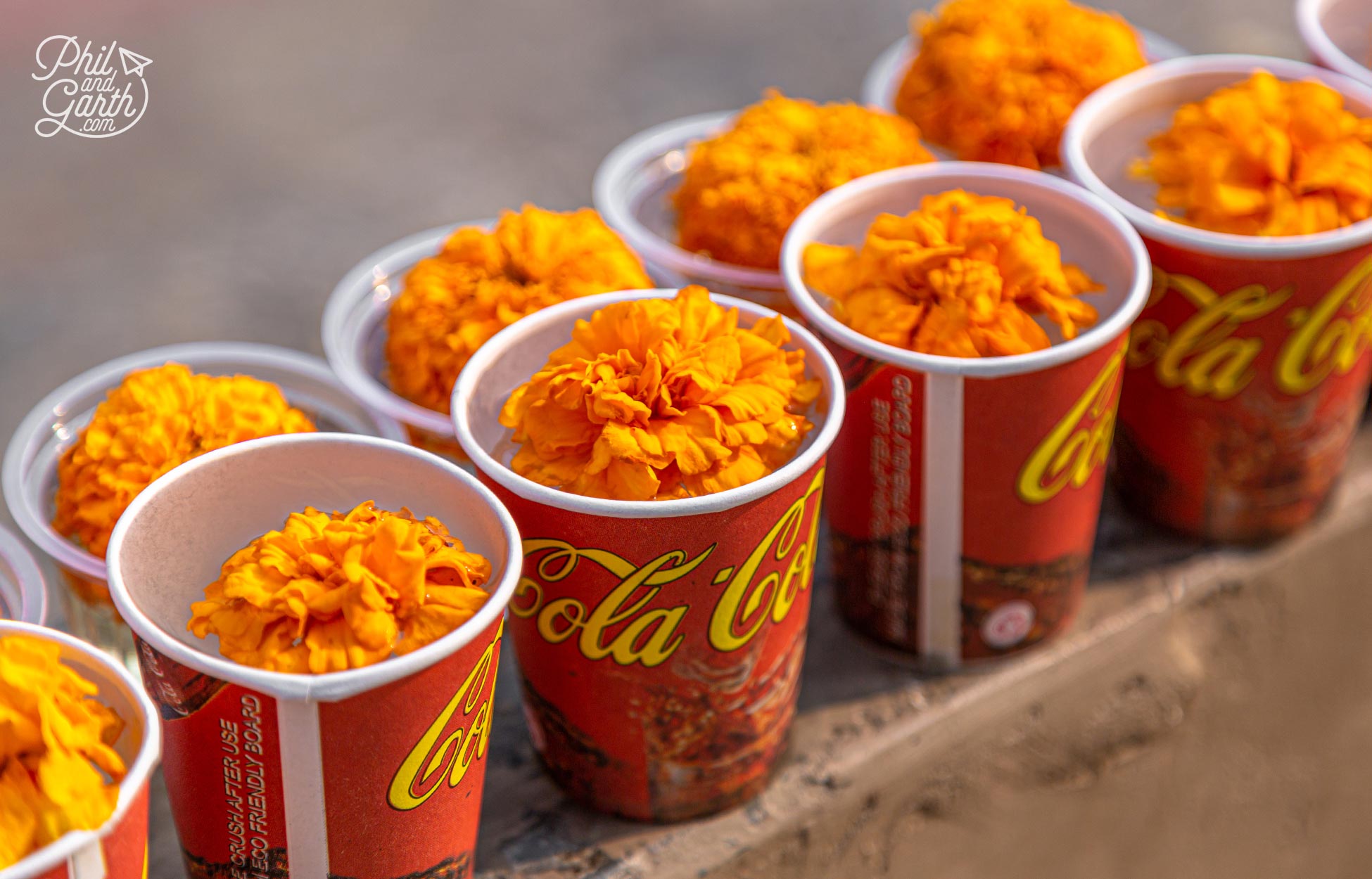
Offerings of marigold flowers surround the Dhamek Stupa
Mulagandha Kuti Vihara
Next to the park is the modern Mulagandha Kuti Vihara monastery and temple. Multi coloured Buddhist flags welcome you to the temple where inside frescoes tell the story of Lord Buddha. Next to the temple is a Bodhi tree, planted in 1931 (when the temple was built) it’s a sapling from a cutting of the original tree in Bodh Gaya, India where Lord Buddha gained enlightenment. Next to the tree is a statue of a scene depicting Buddha preaching his first sermon to what would become his first 5 disciples.
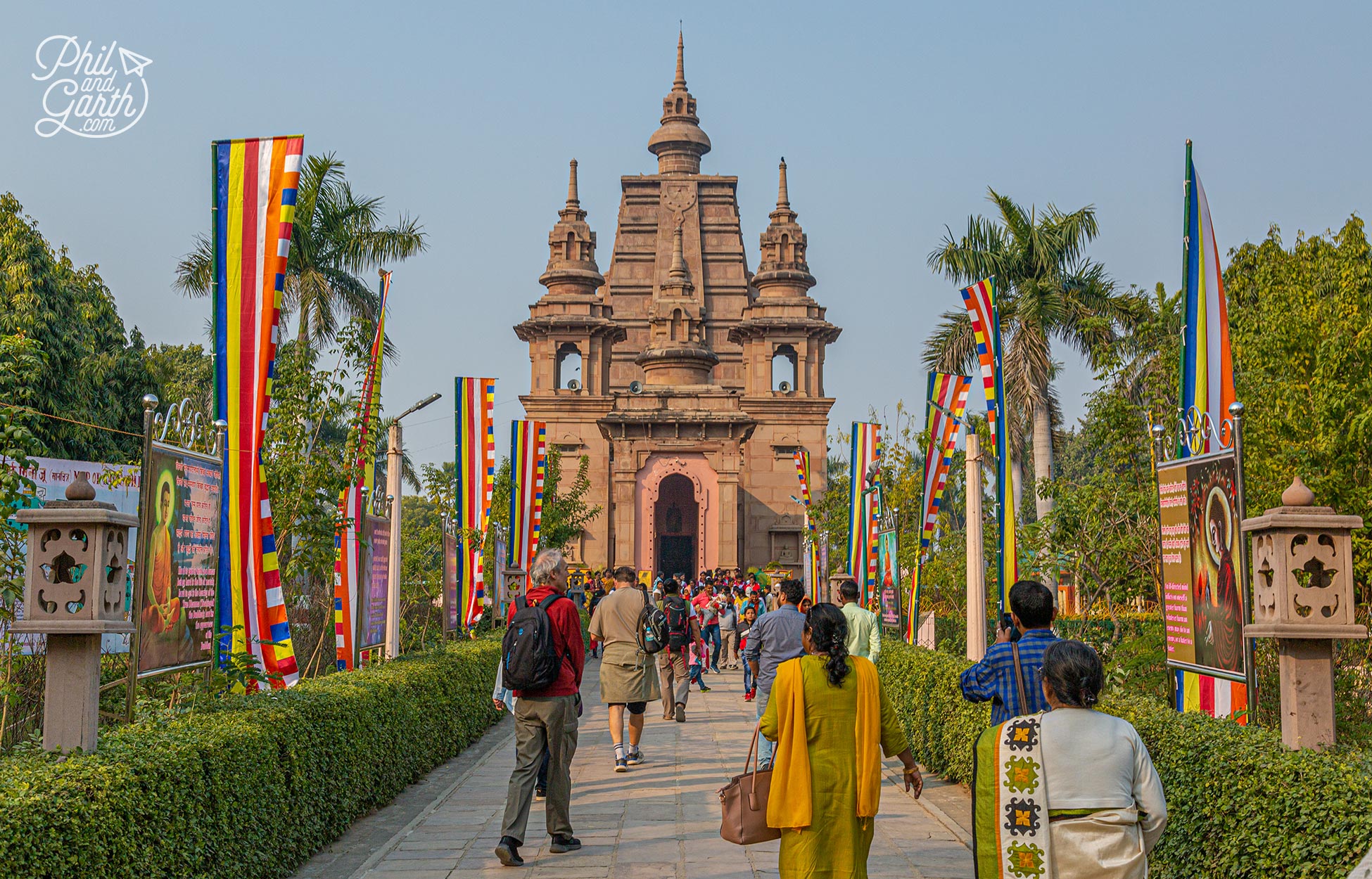
Mulagandha Kuti Vihara – a Hindu temple devoted to Lord Shiva
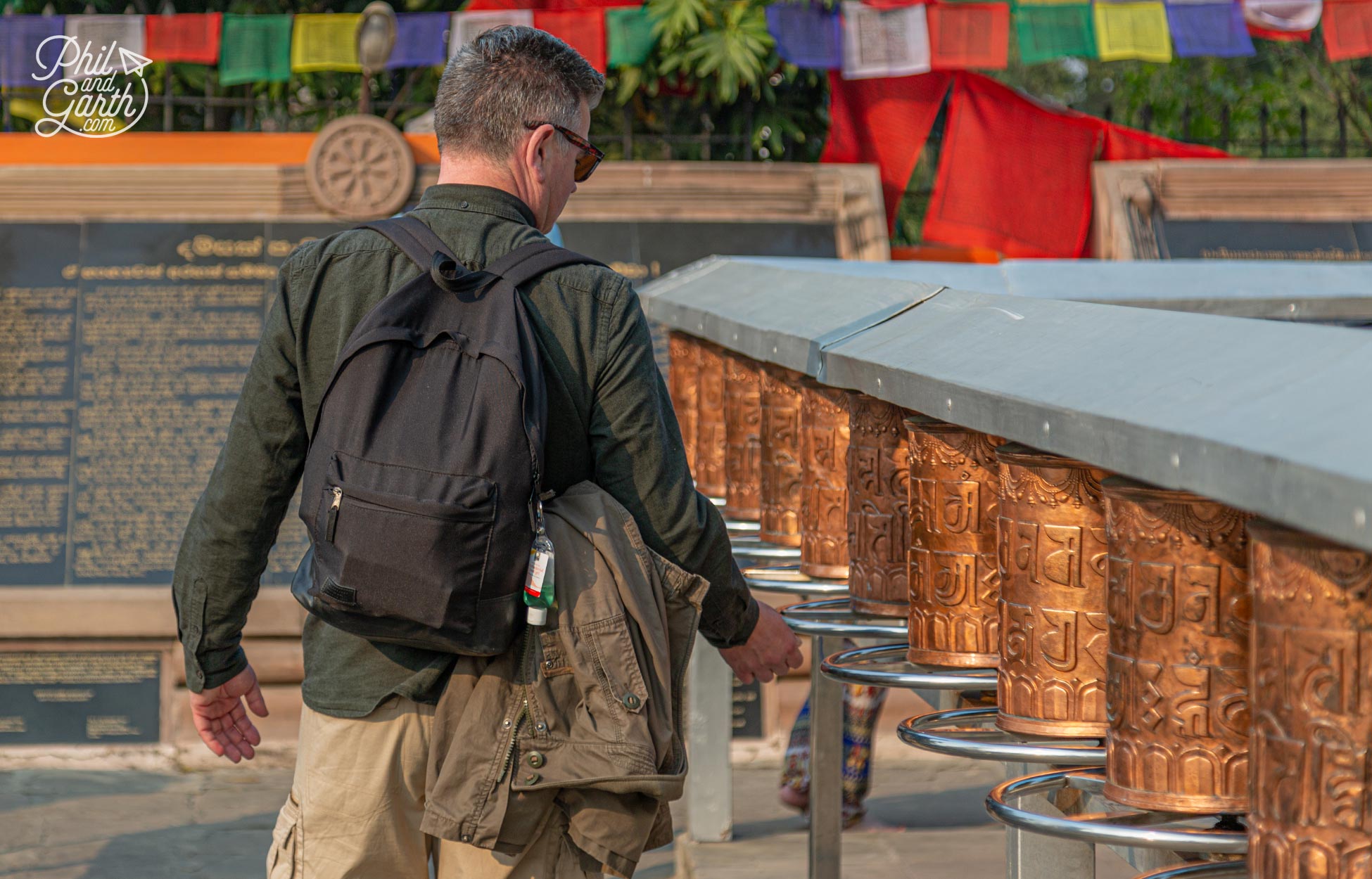
Phil spins the prayer wheels clockwise at the Mulagandha Kuti Vihara temple
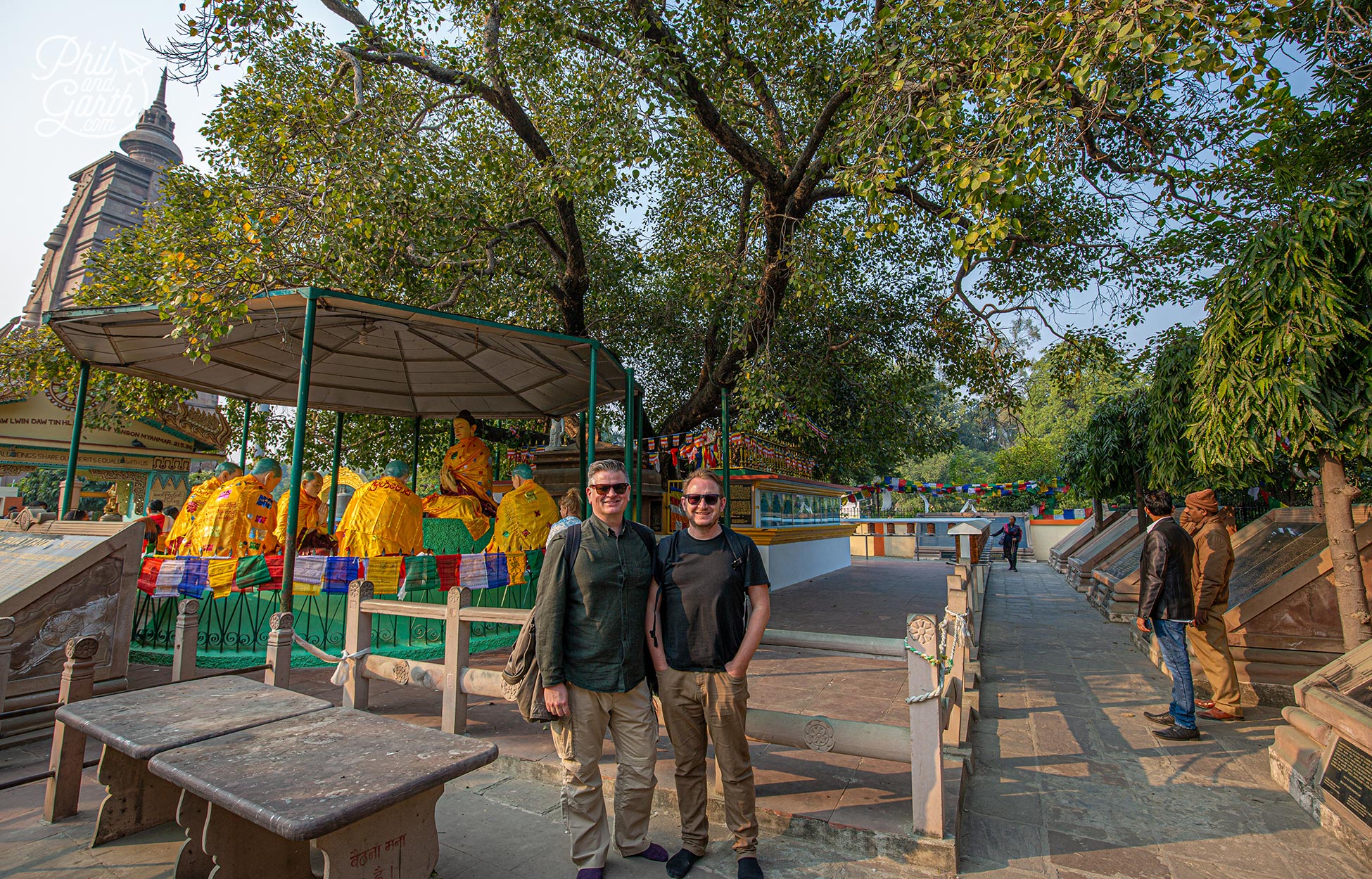
Next to the Bodhi tree at the Mulagandha Kuti Vihara temple
Archeological Museum
We also checked out the Sarnath Archeological Museum which displays a large collection Buddhist and Hindu sculptures and artefacts found at Sarnath. The star attraction of the museum is the Lion Capital of Ashoka carved out of a single slab of sandstone. This highly polished sculpture from 250BC used to sit at the top of a pillar in the stupa complex next door. The circle emblem is called the ‘Dharmachakra’ and is the most important symbol of Buddhism. It symbolises the turning of the wheel of law by Buddha. The symbol from this sculpture gave India its national crest in 1950 after gaining independence.
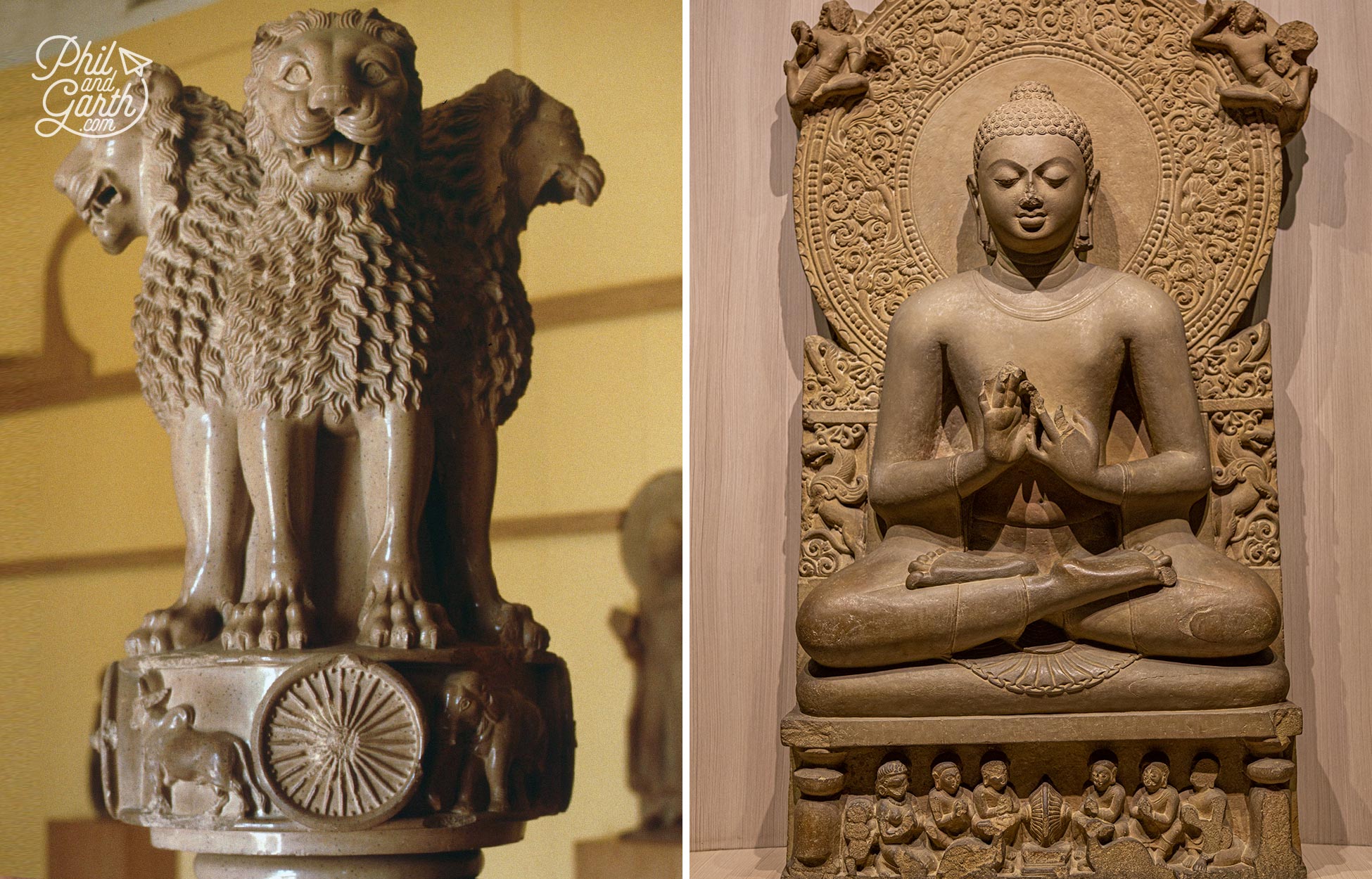
Two star attractions – The Lion Capital of Ashoka and a statue of Buddha in the preaching position
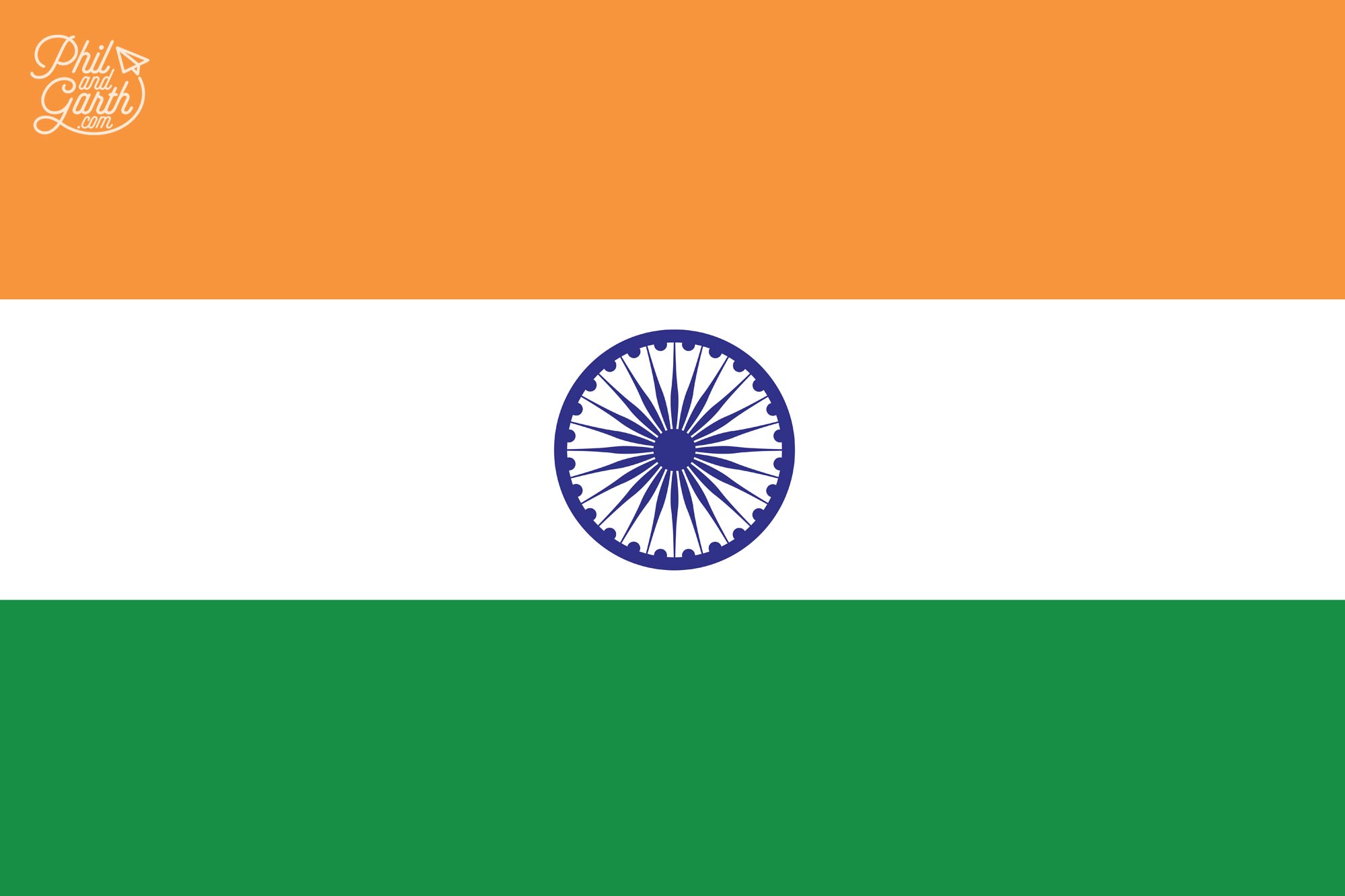
National flag of India with the Ashoka Chakra wheel in the middle coloured in navy blue
Varanasi Practical Information & Useful Advice
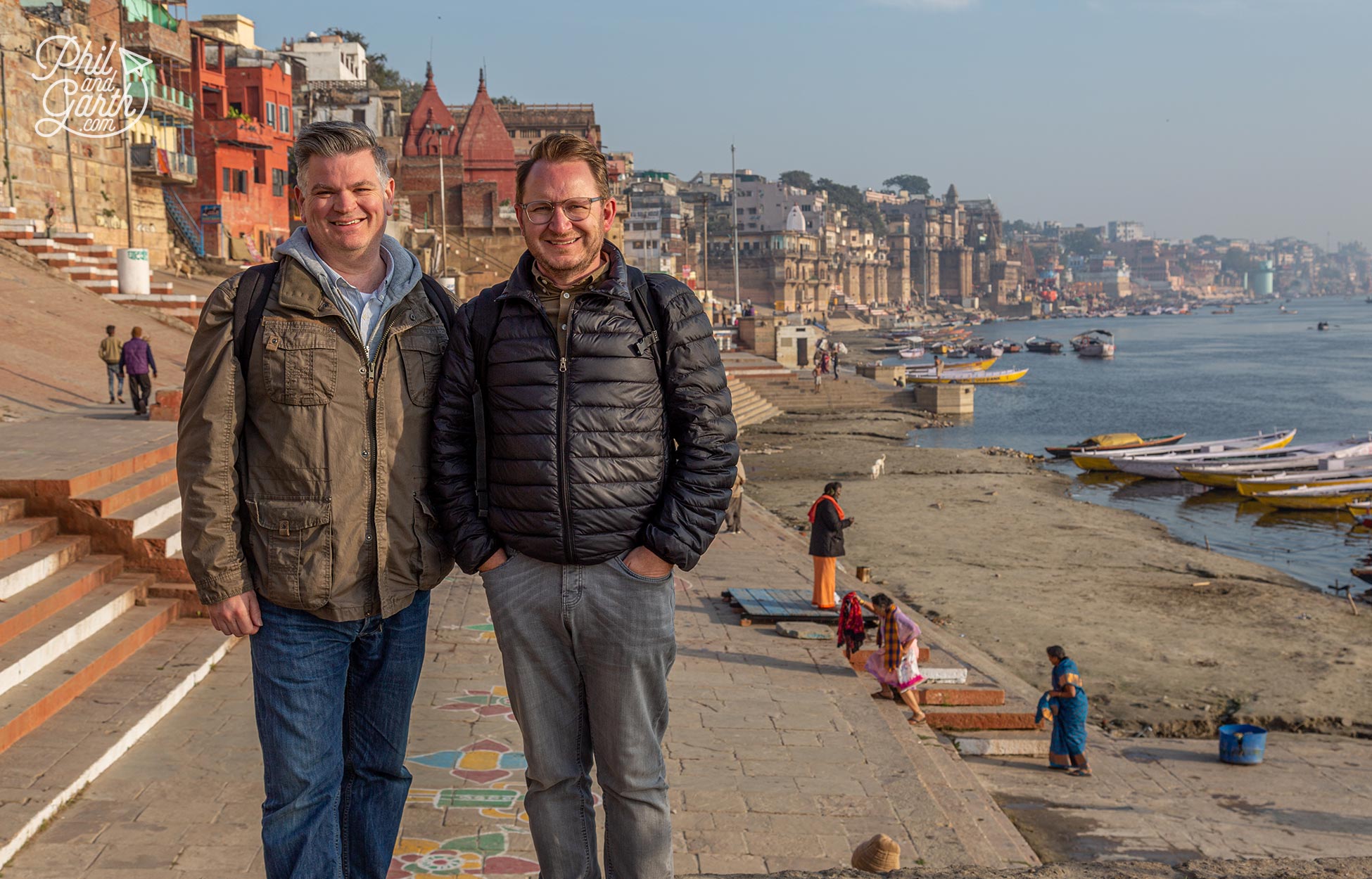
Phil and Garth’s Top 5 Varanasi Tips
Phil and Garth’s Top 5 Varanasi Tips
- Tip #1: Pack a decent face mask for open air tuk tuk journeys. The fumes and pollution is really bad on the roads.
- Tip #2: Our hotel had regular power cuts, which is very common in India, so take a handy torch.
- Tip #3: Take mosquito repellent for flies near the water and especially for mosquitos at the railway station.
- Tip #4: Don’t shake hands with anyone. People will massage your hand and expect a payment – it’s a scam.
- Tip #5: Festival times like Holi, Diwali & Mahashivratri are considered less safe for solo female travellers.
Varanasi FAQs
- What is the airport code for Varanasi? VNS – Lal Bahadur Shastri International Airport, 16 miles from Varanasi.
- What’s Varanasi time zone? GMT+5:30 – India Standard Time.
- What currency is used in Varanasi? Indian Rupee (Symbol: ₹)
- What languages are spoken in Varanasi? Hindi, Bhojpuri and Urdu.
- What is the population of Varanasi? 1,664,942
- What number should I call in an emergency? Call 112
- What electric plug type is used in Varanasi? Plug Types C, D & M. The 3 round pin type is the most common. Voltage is 230V / 50Hz.
- When is the best time to visit Varanasi? October to March because it’s dry and sunny. December and January will be much colder.
- When is the worst time to visit Varanasi? During festivals – Holi, Diwali & Mahashivratri as the city and hotels will be packed. April to June is extremely hot (45ºC) and makes sightseeing impossible. July to September is monsoon season.
- What is Varanasi famous for? Religion, Ghats, River Ganges and Banarasi silk.
- What’s a brief history of Varanasi? Varanasi is the oldest city in India. It’s considered the most sacred city in India.
- What are the 5 must see sights of Varanasi? Varanasi’s Ghats, Ganga Aarti ceremony, Kashi Vishwanath Temple, back streets and Sarnath .
- What’s the best Varanasi local food? Eat Litti Chokha – charcoal grilled dough balls stuffed with chana dal. Lots street food stalls at Assi Ghat.
- What is the best way to get around Varanasi? The best way to get around Varanasi is by taxi or tuk-tuk.
- What’s a Varanasi fun fact? Varanasi has one of Asia’s largest universities – Banaras Hindu University. Home to 25,000+ students.
- What movies have been filmed in Varanasi? Filming location for The Curious Case of Benjamin Button starring Brad Pitt (2008).
- Where’s the best photo spot in Varanasi? Darbhanga Ghat home to the luxury Brijrama Palace heritage hotel which was once a fort.
- What’s a hidden gem in Varanasi? Durga Temple, bright red in colour also called ‘Monkey temple’. 12 minute walk from Assi Ghat.
- What is the best souvenir to buy in Varanasi? A Banarasi silk sari or wooden toys.
How We Did It
- We stayed for 2 nights at the Hotel New Temple’s Town.
- We visited in January (winter) it’s cold, especially in the evenings and hotels don’t have heating.
- We paid for a small group tour of Varanasi and India with Explore Worldwide.
Varanasi Costs
- Sunrise boat trip along River Ganges 150 INR (£1.50) per person based on 10 sharing boat.
- Return Tuk tuk to and from our hotel to the evening Ganga Aarti was 400 INR (£4) including a 2 hours wait time.
- Tuk tuk to and from Varanasi to Sarnarth including 3 hours waiting time was 600 INR (£6.00).
- Evening Arti ceremony viewing by boat 600 INR (£6.00).
Pin our Varanasi travel guide for reference
- Varanasi – The best things to do
- Things to see in Varanasi, India
- Places to visit in Varanasi in 2 days


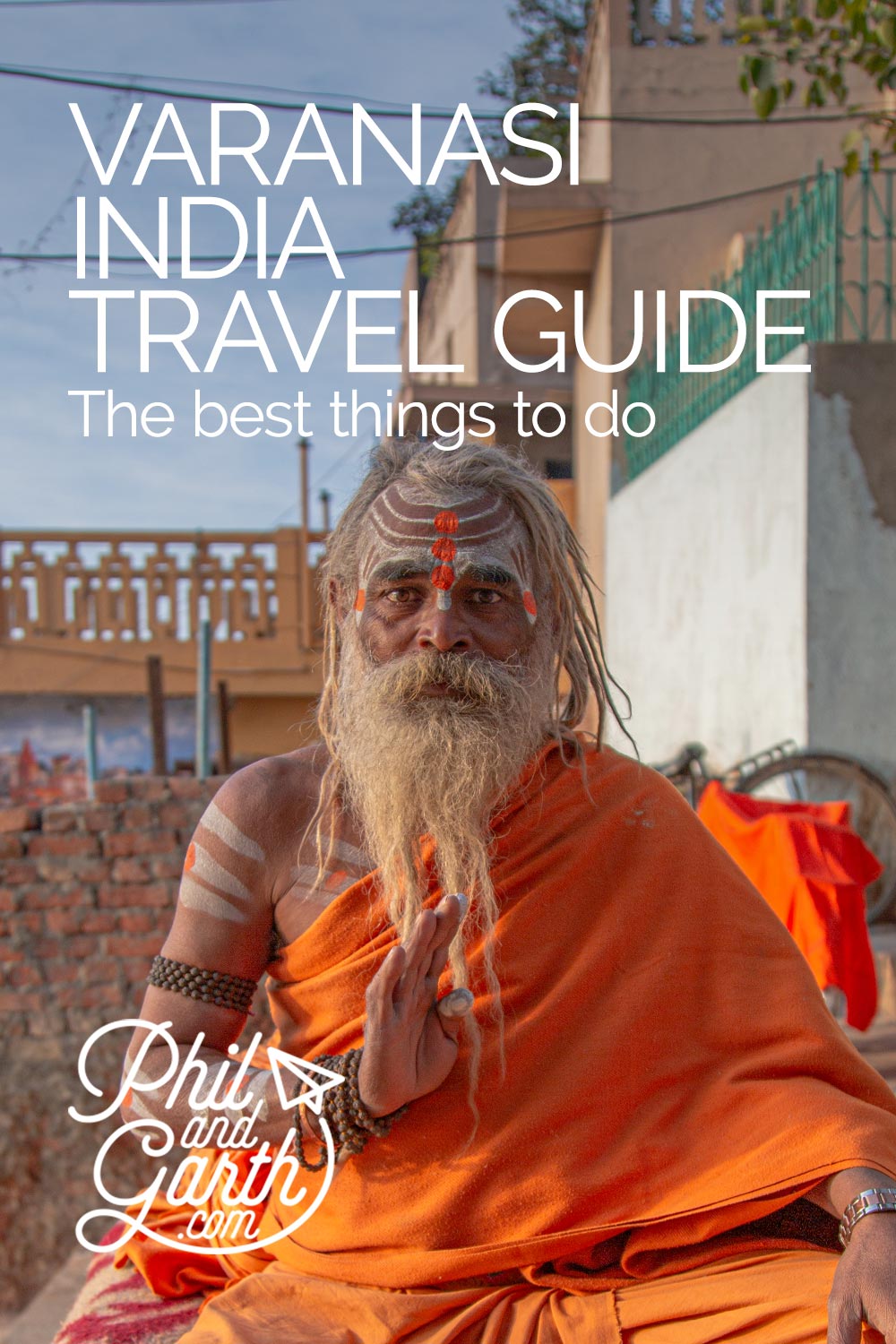
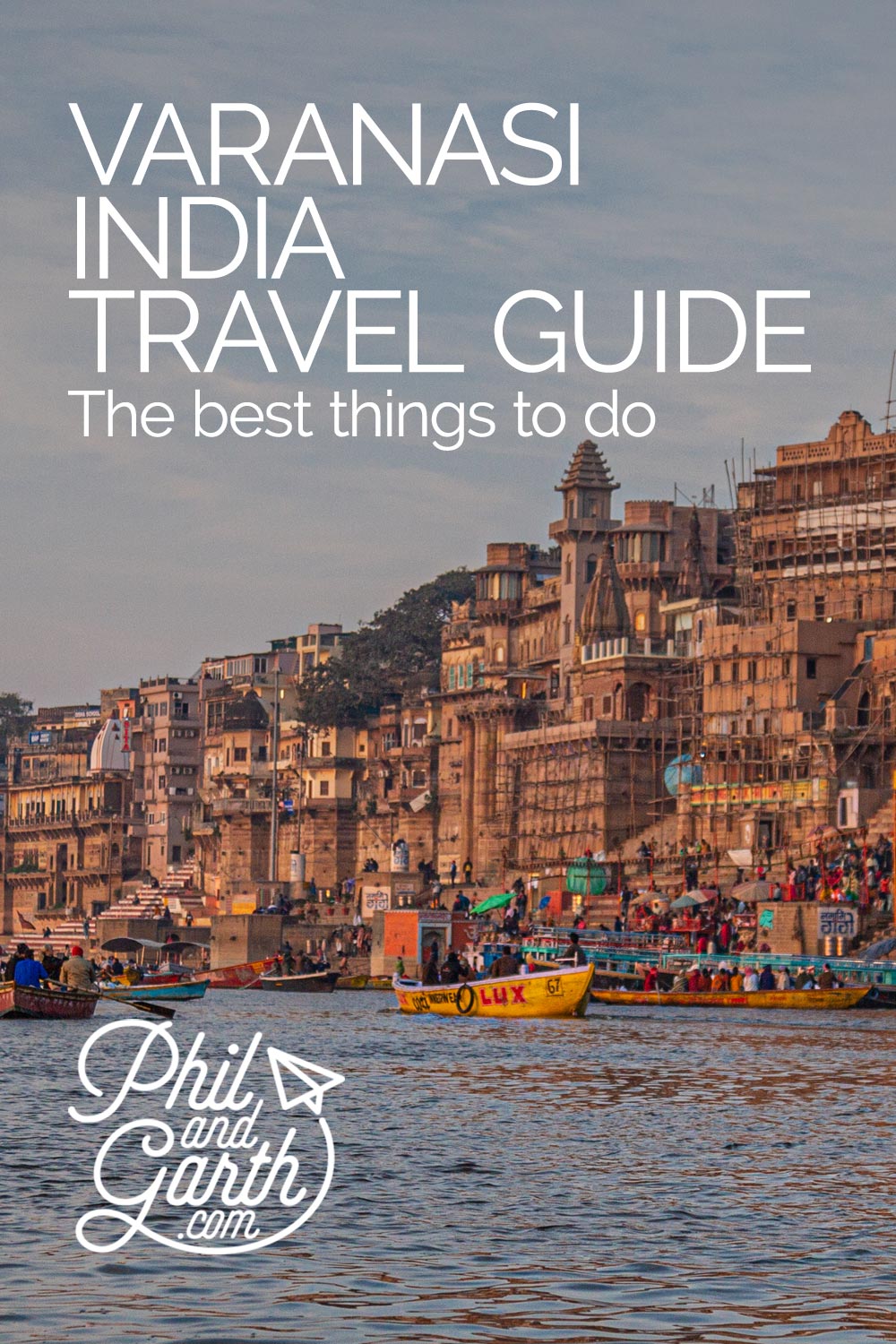
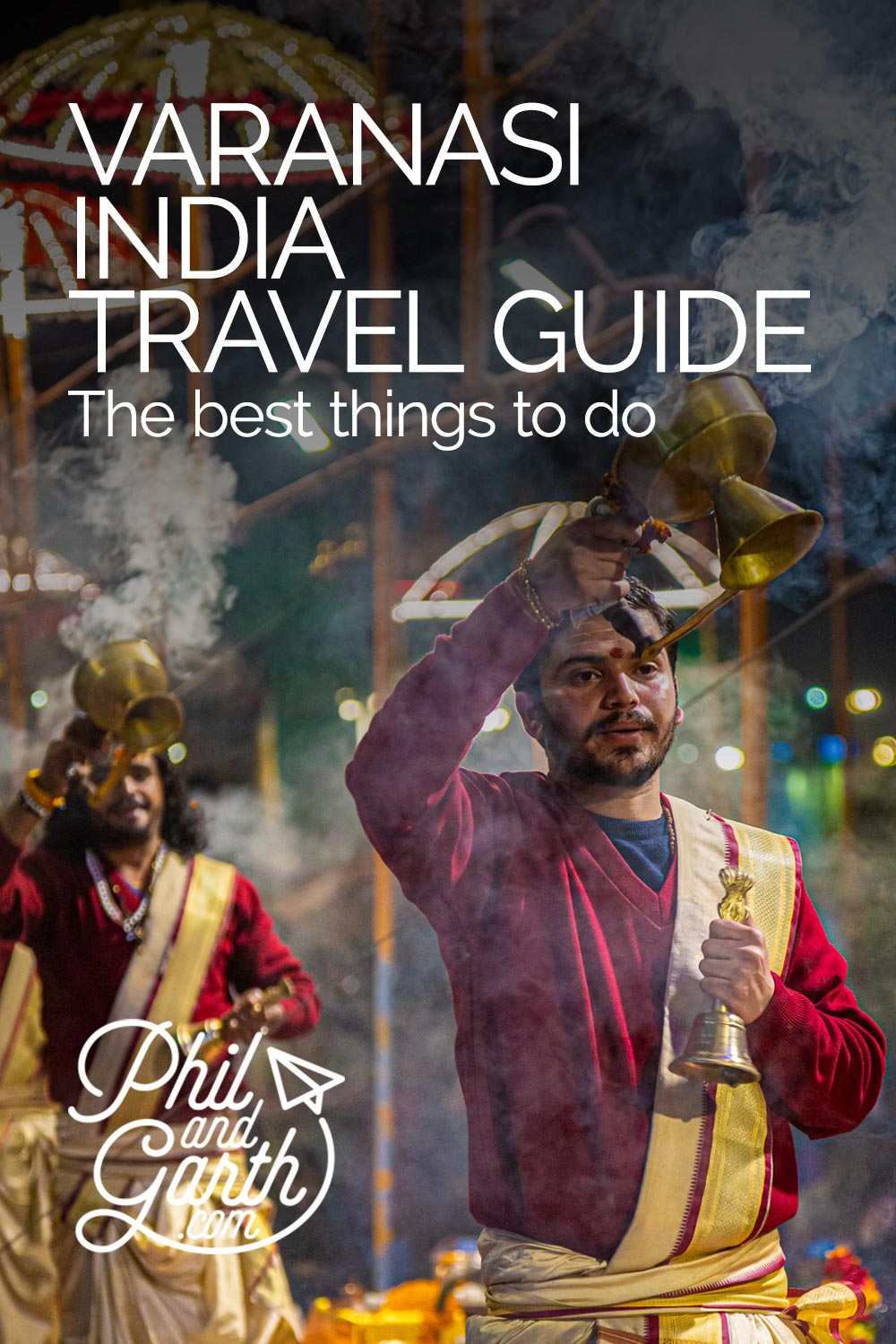
5 comments
Absolutely loved your article on the best things to do in Varanasi, India! Varanasi has always held a special place in my heart, and your comprehensive list truly captures the essence of this vibrant city. From the serene boat ride along the Ganges River to the mesmerizing Ganga Aarti ceremony, every experience in Varanasi is filled with spirituality and cultural richness.
I particularly appreciated your suggestion to explore the narrow lanes of Varanasi, where every corner reveals a new surprise – be it a hidden temple, a bustling market, or a quaint cafe serving delicious local delicacies. Your emphasis on experiencing the city’s diverse culinary scene is spot on; Varanasi indeed offers a culinary adventure like no other, with its mouthwatering street food and traditional dishes.
Moreover, your inclusion of the Sarnath excursion is fantastic. It’s incredible how a short trip from Varanasi can lead to such historical and spiritual significance. Visiting the ancient ruins and the Dhamek Stupa is an experience that truly connects you to India’s rich past and Buddhist heritage.
Overall, your article is a fantastic guide for anyone planning a trip to Varanasi. Thank you for sharing such valuable insights and recommendations! I can’t wait to embark on these unforgettable experiences when I visit Varanasi next.
On my bucket list.. Thanks Phil & Garth for the travel guide..
Thanks for Valuable Information Keep it up.
Very Useful Blog For Varanasi Guidance.
Glad we could help!